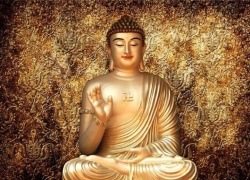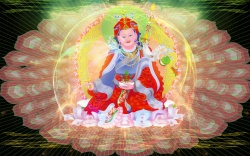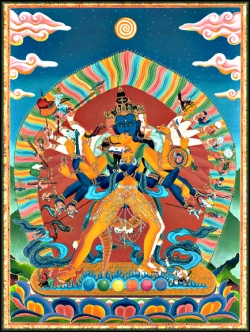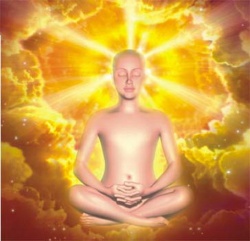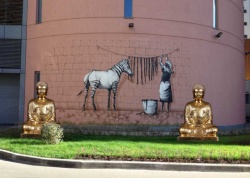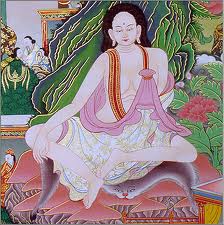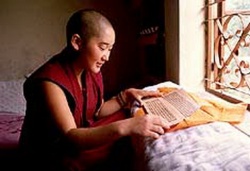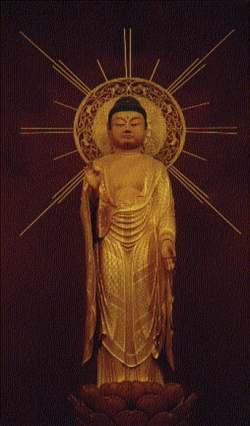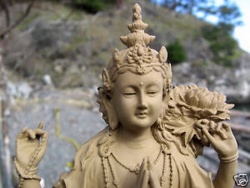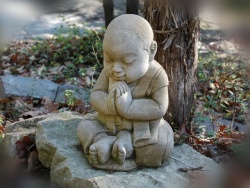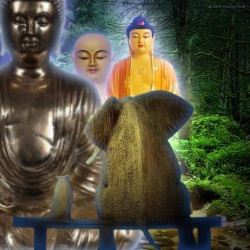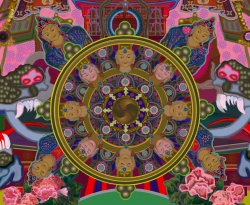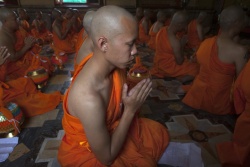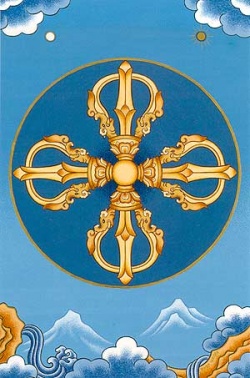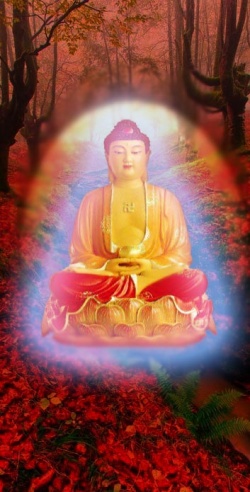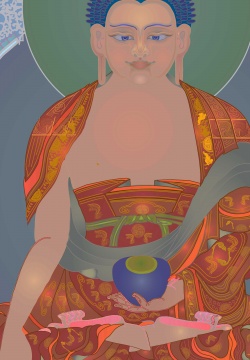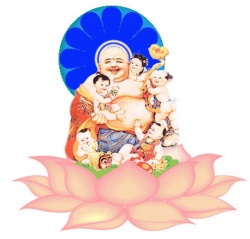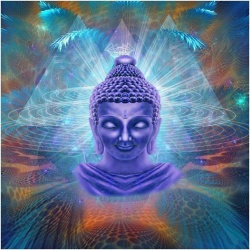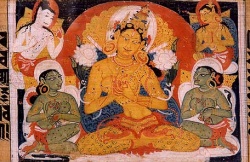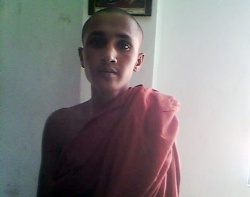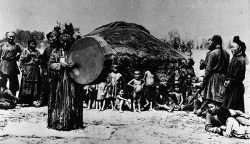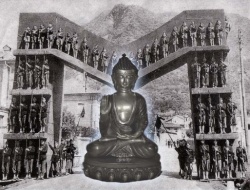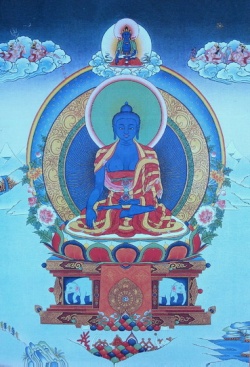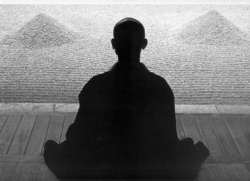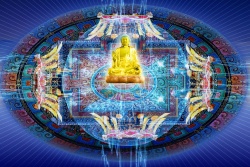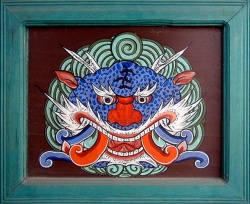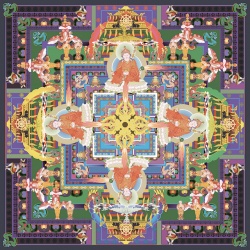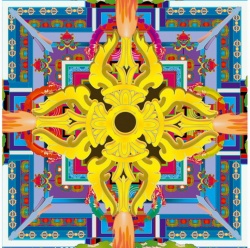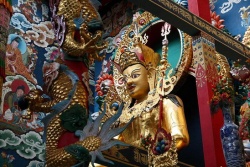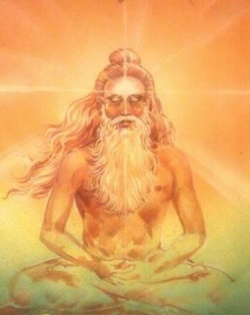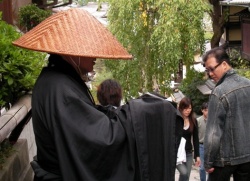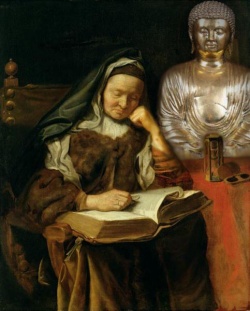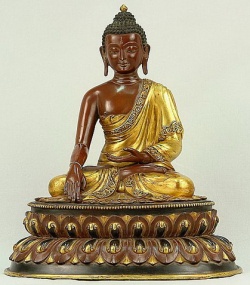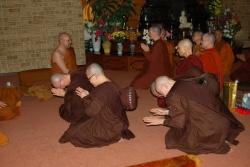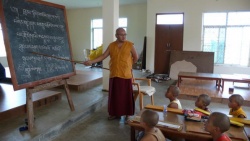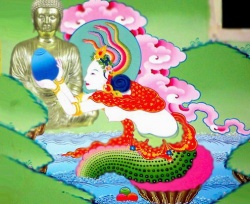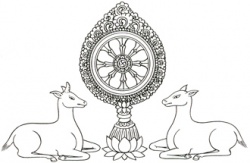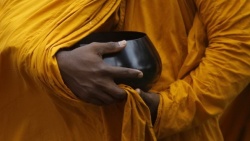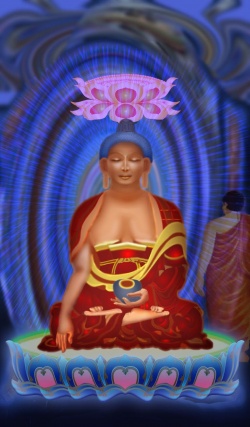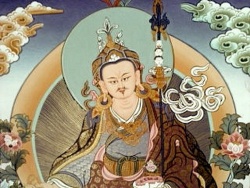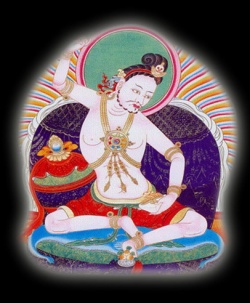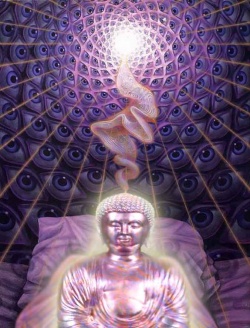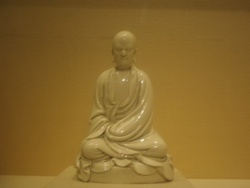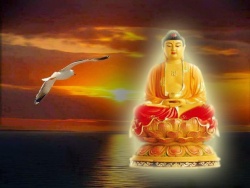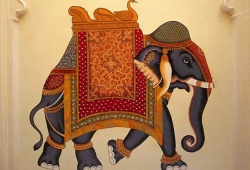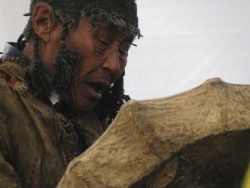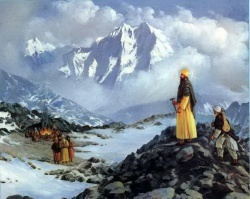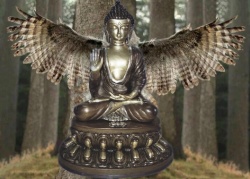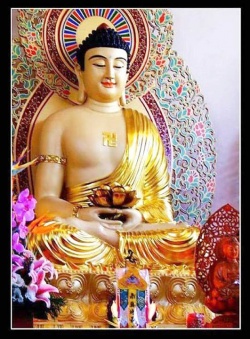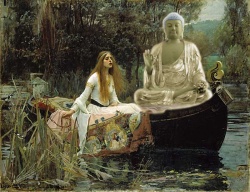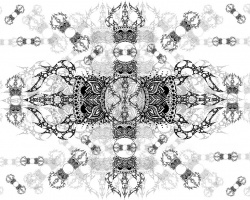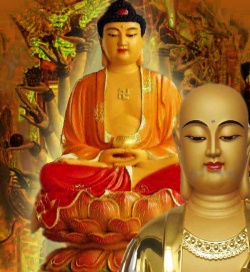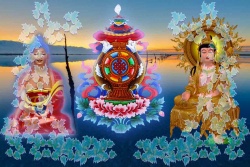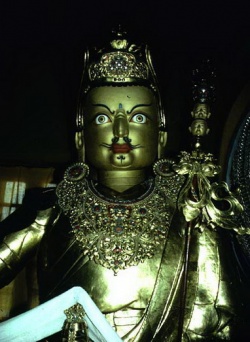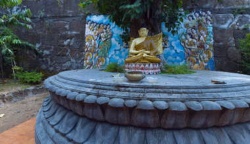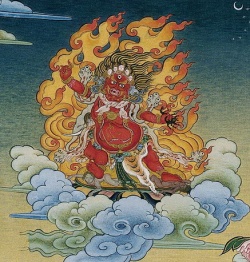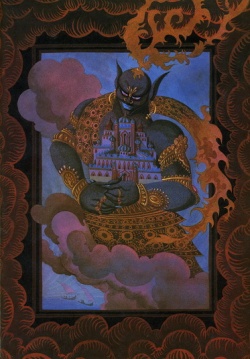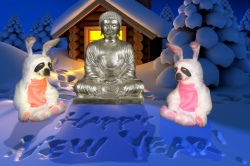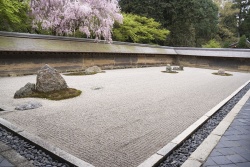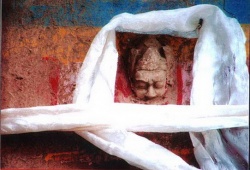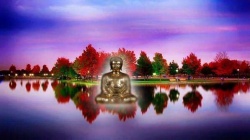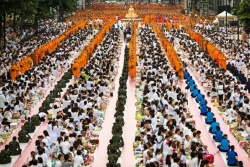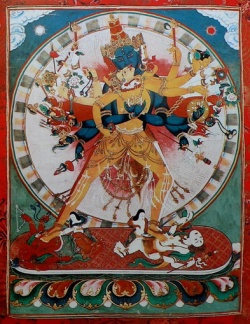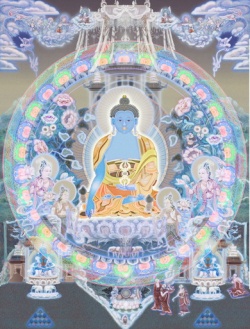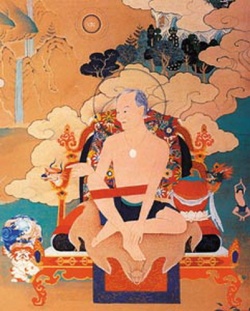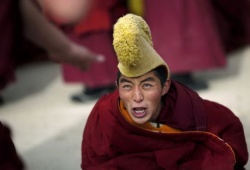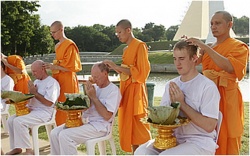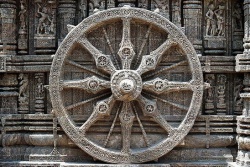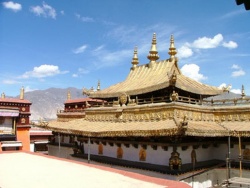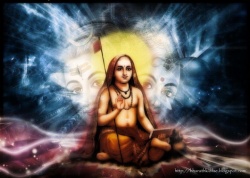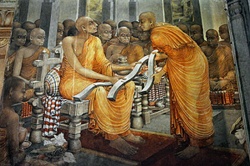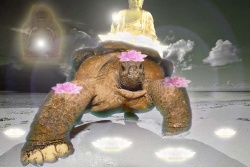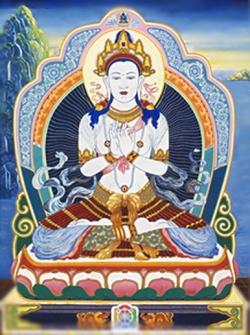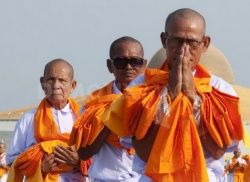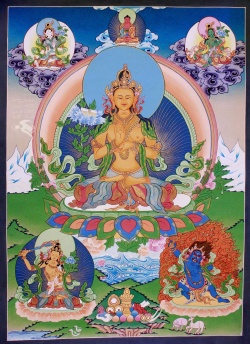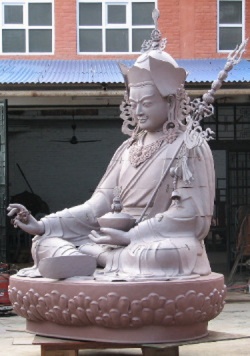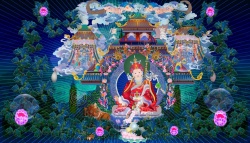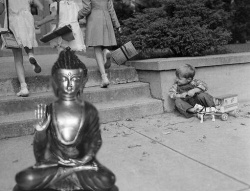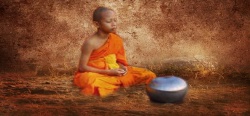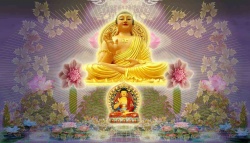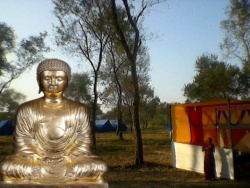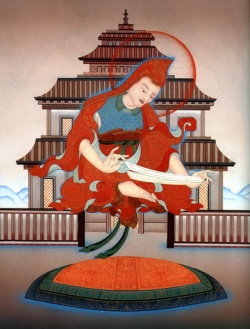Answers To Common Questions About Buddhism
Answers To Common Questions About Buddhism
Zhao Puchu
I began to write this book over thirty years ago. Owing to the heavy load of work, I could only write intermitently. In addition to the five chapters as they appear now, I intended to write three more chapters dealing with the history of relations between China and other countries in the Buddhist sphere. Since the Buddhist Association of China has undertaken to compile and write on this topic, there is no need to duplicate their work here.
When I finished writing the first chapter, it was published in installments in the Joural of Modern Buddhism. I used the pseudonym, "Yin Shui" (drink water), derived fromt the text Suramgama Sutra that reads "One perceives whether the water is cold or warm only when one drinks it." A friend of mine asked why I chose such an insignificant title. I replied, "I prefer to make a fuss about trifles rather than underplaying a big issue, not to mention completely ignoring significant subjects." The title of the Enligsh version of my book is in conformity with my wish.
A few years ago a young monk translated my book into Japanese. In the preface, which I wrote at his request, I referred to a story connected with the subject of this book. In 1957, I accompanied a Cambodian monk to see Chairman Mao Zedong. Before the guest arrived I had the opportunity to chat with the Chairman. He told me, "There is a formula in Buddhism: Zhao Puchu is not Zhao Puchu (in the sense of Paramattha), but Zhao Puchu by name. Is this true?" "Yes." I replied. He added, "Why, then, do you affirm it before negating it?" "It is not affirmation before negation," I said, "but simultaneous affirmation and negation." Then the guest arrived and the conversation was interrupted. Later when I worked on Chapter II of this book, I recalled that unfinished talk. I think the idea of the voidness of nature because of Dependent Origination (Paticcasamuppada) in the book might constitute what I would have said to the Chairman at that time.
I have read a book written by Li Yingqiao, one of Chairman Mao's bodyguards. According to this book, when Chairman Mao was taking a walk with Li in Yan'an one day, Mao said to him, "Let's go see a Buddhist temple, shall we?" Li said, "What's the point? It is nothing but a symbol of superstition." "One-sided, one-sided your thinking is. It culture." This also reminds me of a letter to me froom Mr. Zhou Jianren after the end of the Cultural Revolution, in which he told me that in the early period of the turmoil, Mr. Fan Wenlan had sent word to him that he was making up for a missed lesson by reading Buddhist books. Fan said that Buddhism in China has lasted about twenty centuries, it had such a profound influence on Chinese culture that one can hardly understand the cultural history of China without some knowledge of Buddhism. Finally, in 1987, I visited a Buddhist historical site in Sichuan Province and found that anti-superstition slogans were visible everywhere. Therefore, on my return, I wrote a report. Seeing the report Dr. Qian Xuesen wrote to me, "Religion is a part of culture".
It is noteworthy that all three of these men, the first, a great revolutionary, the second, a famous historian, and the third, a great contemporary scientist, shared the same view that Buddhism is a part of culture. Yet there are still many people today whose perception remains like that of Li Yingqiao at that time.
At the very beginning, I was impelled to write this book by the desire to help those interpreters who had difficulty in performing their work due to a lack of knowledge in Buddhism. In recent years, however, I have received kindly consideration and encouragement from many people at home as well as friends from abroad. This indicates that this pamphlet has made more than a negligible contribution towards enhancing the public comprehension of Buddhism and helping foreigners understand Chinese Buddhism.
I am indebted to the translator for her arduous endeavors in accomplishing this task. I sincerely look forward to forthcoming comments on the book from friends and over the world.
Translator's Preface
Answers To Common Questions About Buddhism is the final fruit of a lifetime of study on Buddhism made by Mr. Zhao Puchu. The first three chapters give respectively a succint exposition of the Buddhist Three Gems, i.e. Buddha, Dhamma (Buddhist doctrine), and Sangha (the Buddhist Order). Chapter One gives a historical, rather than mythological, account of the founder and the founding of Buddhism. Chapter Two gives in simple language a profound explanation of Buddhist doctrine, as well as its spread and the compilation of its canonical literature. Chapter Three gives a vivid account of the formation of the Sangha as well as their life and disciplines. The last two chapters are nothing short of a brief history of Indian and Chinese Buddhism. Chapter Four discribes the rise and fall and resurgence of Buddhism in its birthplace--India, while Chapter Five is packed with detailed information, and expresses the innermost feelings of the author. By giving a thorough analysis of the spread, the development and evolution of Buddhism in China, and of the relationship between Buddhism and everyday life, the impact of Buddhism on social intellectual and cultural development, the last chapter contends that we should carry forward the advantages of popular Buddhism, and make it serve contemporary social and cultural life.
In the form of questions and answers, the book addresses and answers practically all the questions raised by Buddhism over the past 2,500 years. The book may be regarded as Zhao Puchu's general survey of Buddhist studies, giving the ordinary public a proper introduction to Buddhism, while giving to the scholars inspiration and points of entry into in-depth study of Buddhism. It also furnishes the foreigners wishing to learn about Buddhism, especially Chinese Buddhism, a comprehensive outline of the field.
The language is vivid yet colloquial, and answers in an enlightening way even those seemingly incomprehensible and abstruse points of Buddhism. Through the apt wording one detects the wisdom of a great philosopher, the sympathy engendered in one with intimate knowledge, the serious and magnanimous approach of a true scholar, and the orthodox stand of the true Buddist, clearly demarcating it from any superstition or heresy. This translation was begun in 1996 at the request of the China Institute of Buddhist Culture. At that time, I had no idea what a challenge this work would prove to be of my knowledge of Buddhism, my Chinese skills and my English level. In order that the limitations of the translator do not detract from the splendors of the original work, over the course of translation I consulted a large number of reference books, strove to ensure that translations were made on a sound basis, and for most technical terms, sought out the original Pali (or Sanskrit) terms, as well as those English forms most sanctioned by usage.For the convenience of the reader wishing to learn English or Pali Buddhist terms, I compiled a Pali, English and Chinese glossary (see appendix). When dealing with more complex ideas, I tried through reading works in the original Pali, English or Chinese to arrive at a clear grasp of the ideas and the intentions of the author before setting pen to paper. The present translation is the culmination of work over three years and many revisions, and while it has been checked by the author, and earned his praise, I am aware that there remain many areas that fall short of total satisfaction. I earnestly beseech the readers indulgence and criticism.
Over the course of translation and its revision, I have benefited from the help of many experts. In order that the translation would not loose its original flavour, from the very first I have consulted a range of foreign experts, including some who know neither Chinese nor Buddhism; some who do not know Chinese but know Buddhism, as well as some who know both Chinese and Buddhism. Here I wish particularly to thank Michael Crook, Helen Wiley, and Tisssa Kariyawasam. If the translation brings satisfaction, it is they who have helped it do so. At the same time, through the course of translation, I consulted translations of this work, in other languages as well. For the hard work of these translators, I would like to extend my heartfelt respect. And throughout the work, the constant trust, encouragement and support of Mr. Zhao Puchu and the China Institute of Buddhist Culture has made it a learning experience for me. For this, I am sincerely grateful to Mr. Zhao Puchu and the Institute of Buddhist Culture, who gave me this opportunity to better myself.
This translation is the fruit of the labour and wisdom of many people. I make no claim to the credit--this is a point I wish to make clear. Zhao Tong Dec.1999
Editorial Notes
1. This book is laid out as a bilingual book with Chinese original facing its English translation, and it is arranged according to the number of the questions. Most Buddhist terms in this book are given in both the original Pali and English Translations. Some Buddhist terms in Pali or Sanskrit were given in Chinese original text, and have been rendered into Pali in this edition in compliance with Mr. Zhao Puchu's own wishes. The reason for this change is that Buddhist texts appeared earlier in Pali than in Sanskrit. The Pali language was popularly used in Magadha State in ancient India where the Buddha gave most of his sermons, and some scholars believe the Buddha taught in Pali. In the period of Asoka (3 century BC), Ven. Mahinda was dispatched to Sri Lanka as a missionary by his father, King Asoka, and he took the oral Pali Tripitaka there. This was later recorded in Sinhalese script Pali in the first century BC and handed down to this day. This Pali Tripitaka has been preserved unaltered during 2000 years and has become the most complete, systematic and oldest Buddhist canonical treasure in the world. Sanskrit had been used to record Brahman Classics in ancient India, it was referred as a refined speech. No complete Buddhist Tripitaka has survived today.
3. The following abbreviations are used in the text: S. (Sanskrit), P. (Pali).
4. A glossary of Pali terms is given with both English and Chinese translations in numerical order by chapter and question. ________________________________________ Contents Author's Preface Translator's Preface Editorial Notes Chapter I. The Buddha and the Origin of Buddhism Chapter II. The Essence of the Buddha Dhamma and the Buddhist Canonical Literature Chapter III. The Sangha and the Buddha's Disciples Chapter IV. The Development, Decline and Resurgence of Buddhism in India Chapter V. The Spread, Development and Evolution of Buddhism in China 1. The Introduction of Buddhism into China and the Translation of Buddhist Scriptures 2. The Emergence of Various Buddhist Schools 3. Buddhism in Minority-inhabited Regions of China 4. The Impact of Buddhism on Chinese Thought and Culture 5. Carrying Forward the Advantage of Popular Buddhism Appendix Buddhist terms in Pali, English and Chinese Chapter I The Buddha and the Origin of Buddhism ________________________________________ The Buddha and the Origin of Buddhism
Q: What is Buddism? A: Buddhism, in a general sense, is a religion with its canonical literature, rites, customs, Sangha Order (congregational organization) etc.; more specifically, it is the Buddha's teachings, and with this specific meaning it should be termed the Buddha Dhamma.
Q: What is "Dhamma"? A: "Dharma" in Sanskrit ("Dhamma" in Pali) means "retaining one's own nature, such that it can be recognized". That is to say, everything has its own attributes and appearance (S. prakrti and laksana, P. pakati and lakkhana) and maintains its own properties, by which people can perceive it for what it is. For instance, water maintains its property of wetness and acts according to its fixed track, so people recognize it as water when they see it. Conversely, when something is devoid of wetness and obey different rules from water, there then can be no concept of water. Therefore, Buddhism views everything as "dhamma". The term "all dhammas", "each dhamma" appearing in Buddhist canons indicate "all things" or "universal existence". According to this interpretation, the discourses delivered by the Buddha based on his own empirical comprehension of dhammas are also "Dhamma" since they hold true to the principle of "retaining its own nature, such that it can be recognized."
The Buddha and the Origin of Buddhism
Q: Is the Buddha a deity? A: No, the Buddha is not a deity. He was a man who lived in the sixth century BC. He had his own given and family names, his given name was Siddhattha (S. Siddhartha) and his family name Gotama (S. Gautama). As he belonged to the Sakya clan, people also called him Sakyamuni, meaning a sage of the Sakyas. Q: Why is Buddha called "Fo" in Chinese? What does it mean? A: "Fo" is the abbreviation for "Fuotuo" which was used to translate the word "Buddha".(The characters used for "Fuotuo" were pronounced "buda" at the time of translation.) Buddha means "an enlightened one" or "an awakened one." The term "Buddha" existed in India from the earliest times, but Buddhism has attributed three additional connotations to the term. They are as follows: 1.enlightenment (Sambodhi, which means thoroughly realizing the properties and appearance of all dhammas as they are); 2. perfect enlightenment (Samma-sambodhi, which means not only enlightening oneself but also equally and universally enlightening others); 3. supreme or paramount enlightenment (Anuttara samma-sambodhi, which means the wisdom and achievement have reached the highest and the most perfect sphere in enlightening both oneself and others).
Q: Are there any other Buddhas besides Sakyamuni? A: Buddhism claims that there were people who attained Buddhahood in the past and there will be people to become Buddhas in the future. It is possible for everybody to achieve enlightenment. Therefore, "All living beings have Buddha-nature, everyone with the Buddha-nature may attain Buddhahood."
Q: Is the Chinese term: "Rulai Fo" identical to Sakyamuni or is he somebody else? A: "Rulai" was translated from the Sanskrit word "Tathagata". "Ru" means "suchness" (tathata), or "according to the reality" (Yathabhutam), i.e. the ultimate reality of all dhammas, while "lai" means "come". "Rulai" (Tatthagata) is interpreted in the Buddhist scriptures as "coming by the path of Tathagata" or " coming according to the reality". Tathagata is a general term and another name for "Buddha". Thus Gotama Buddha can be called Gotama Tathagata, and Amita Buddha can be called Amita Tathagata.
Q: Are not Amita Buddha and Gotama Buddha one and the same? A: No, Amita Buddha or Amitabha is the Buddha of another world. The Chinese term "Amituofo" is the transliteration from Sanskrit of "Amitabha", meaning "boundless light".
Q: What is the meaning of "Namo Fo"? Why is it pronounced as "Namo Fo"? A: "Nanmo" is the transliteration of Sanskrit "Namo". The Chinese characters Namo were used since their pronunciation was similar with "namo" in the ancient time when this term was introduced into China. Such a pronunciation is still preserved now in parts of China's Guangdong and Fujian provinces. "Namo" means salutation or homage. Even today, when Indians meet they say "Namaste" to each other, that is to say "Homage to you".
Q: What is known about the life of Sakyamuni? A: Well, Sakyamuni lived around the sixth century BC, equivalent to the Spring and Autumn Period in China, and was a contemporary of Confucius. He was the eldest son of the King of Kapilavatthu. His father was named Suddhodana; his mother Maya. Queen Maya gave birth to Prince Siddhattha on the way to her parents' home while taking a rest under a tree in Lumbini Grove, since, according to the custom prevailing in India at that time, women should go back to their parents' home for child bearing.
Q: Are they any vestiges of Lumbini Grove remaining today? A: During the seventh century AD, Tipitakacariya Xuan Zang (Hsuan Tsang) of China visited Lumbini Grove. According to his account, he saw the stone pillar erected there by King Asoka about 800 years before, marking the birthplace of the Buddha. The site at that time, however, was in a state of desolation, the pillar having been struck by lightning and the top having fallen down onto the ground. Subsequently, the birthplace of Buddha sank into oblivion because nobody could read the letters on the pillar. It was not until 1897 when Asoka's pillar was re-discovered and archeologists deciphered the inscriptions that the ravaged ruins of Lumbini Grove were excavated. Some ancient settlements were also excavated in the vicinity of that site, part of which may have belonged to the old city of Kapilavatthu. Today, the government of Nepal has proclaimed it as Holy Land and undertaken necessary reconstruction and protection.
Q: How was Sakyamuni educated in his childhood? A: Queen Maya died soon after giving birth. Young Sakyamuni was brought up by his aunt (his mother's sister) Princess Prajapati. As a child he began to learn literature, philosophy, arithmetic etc. from Brahmin scholars and gained a broad and profound knowledge. He also learned martial arts from warriors and became a master at riding, shooting and fencing. Because of his great intelligence and striking features, his father, King Suddhodana, hoped that he would become a universal ruler (Raja Cakkhavattin, a King who could unify the whole world) and perform meritorious services after he succeeded to the throne.
Q: Why didn't he succeed to the throne later on? A: Prince Siddhattha in his childhood developed the habit of meditating. Many phenomena he observed touched him strongly and made him think deeply: e.g. the hungry, thirsty and exhausted farmers working under the scorching sun, panting and sweating cattle being flogged as they plough, the struggle among snakes, insects, birds and beasts under the law of the jungle, weak and ugly old people, the moaning and suffering sick, the dead in funeral processions with their families and friends weeping behind. All these presented him with a problem: how to deliver the world from suffering. Neither the Vedas he had read nor the knowledge he had acquired, nor his future throne and power could solve this problem. Therefore, he harbored the idea of renouncing the world in his early days, and finally he relinguished his throne.
Q: How could his father agree to his renunciation? A: Having found out what his son had in mind, King Suddhodana tried many ways to detain him, especially by surrounding him with worldly pleasures. When Siddhattaha was only 16 years old, King Suddhodana arranged for him to marry Princess Yasodhara from a neighboring state. Yasodhara bore him a son named Rahula. But all this was in vain. He finally slipped out of the capital city in the still of a night.He entered a forest, shed his princely clothes and, shaving his head and beard, became a wandering mendicant. Regarding his age at the time of renunciation, there are two different accounts--one says nineteen, and the other twenty-nine.
Q: What about his life after he renounced the world? A: Having tried in vain to persuade him to return, his father chose five men from his clan to accompany him. They were Kaundinya, Bhadrika, Vaspa, Mahanama, and Asvajit (P. Kondanna, Bhaddiya, Vappa, Mahanama, Assaji). Prince Siddhattha and his followers successively paid visits to three famous scholars and learned from them, but none of them could satisfy his quest. When he realized that no real path of deliverance (or absolution) was to be found in the philosophical thought of that time, he left for a forest on the banks of the Neranjara river, now the Lilaian, and lived there with other ascetics. In his search for emancipation, he went through suffering and pain for six years. However, since it proved fruitless, he began to understand that austerities were to no avail. So he went to take a bath in the Neranjara River, cleaning off all the dirt of six years. Then, after accepting the milk gruel offered by a herdwoman, his strength returned afresh. When his five followers saw this, they thought he had abandoned his faith and spiritual efforts, so they left him for Benares City (P. Baranasi) to continue their ascetic practices. The Prince then went alone to a Pippala tree and made a seat with auspicious grass (kusa) under the tree. Sitting down with his legs crossed and facing the east he vowed, "Now should I fail to attain supreme enlightenment, I would rather have my body decompose than rise from this seat." In such a manner, he commenced meditating on absolution, and finally one night defeated the moral affliction and Mara's temptations (kilesa and Mara), achieved complete enlightenment, thereby becoming a Buddha.
Q: Are there any vestiges remaining of the site where Sakyamuni became Buddha? A: The site where Sakyamuni attained Buddhahood has been known as the Place of Enlightenment or Budddhagaya ever since. The Pippala tree there, as well as that kind of tree in general later became known as Bodhi tree. Bodhi means enlightenment. Buddhagaya is situated in the southern suburbs of Gaya City in Bihar Pradesh of India today. In the course of more than twenty centuries, the Bodhi tree was twice chopped down and once blown over, but always sprouted again. The present Bodhi tree is a great grandson of the original one. At the plot where Buddha set under the tree is a stone-carved diamond pedestal (Vajrasana). To the east of the tree is a majestic thupa (S. stupa) temple known as Mahabodhi Arama with a history of over 18 centuries, and nearby are a number of traces of Buddha and ancient carved stones and architecture. In 1956, the government of Bihar Pradesh appointed an international advisory committee to supervise the construction and administration of the Holy Land. The Buddhist Association of China, at its invitation, sent two delegates to that Committee. Q: Would you please give a brief account regarding his life after Sakyamuni attained Buddhahood? A: There are different versions regarding the age at which Sakyamuni attained enlightenment, some quote it as thirty and some as thirty-five. For fifty (or forty-five) years after that, until the end of his life at the age of 80, he never stopped preaching his doctrine. He traveled widely, preaching to the public the truth he had perceived. At the outset, he went to Benares (P. Baranasi) to look for his five departed followers and preached the truth to them. The first sermon of the Buddha is called "The initial turning of the wheel of Dhamma" (S. Dharmacakra pravartana, P. Dhammacakkappavattana) in Buddhism.
Q: What does "Turning the wheel of Dhamma" mean? A: Cakka (wheel) was a wheel-like weapon used in wars in ancient India. There was an old legend in India that the raja (king) that conquered the world would be the Rajacakkavattin, i.e. "The wheel-turning king". At the time of his birth, a wheel appeared in the sky, prophesying that he would be unconquerable in the future. In Buddhism the wheel is used as a metaphor of the Dhamma preached by the Buddha. Once the Buddha's Dhammacakka emerged, all the wrong thinking and evil things would be smashed and vanish. Hence the preaching of Dhamma is called Dhammacakkappavattana (turning the wheel of Dhamma). The Buddha's initial turning of the wheel of Dhamma took place at Sarnath (Deer Park) in present day Benares. Through the recent excavations, quite a few valuable relics have been discovered at Sarnath, including King Asoka's stone pillar, stone-engraved images of the Buddha's first turning of the wheel of the Dhamma dating from the fourth century AD etc. Even the ruins of the ancient thupa temple were unearthed. Buddhist temples, museums and a library now standing there were built over the last few decades. There are four places regarded as the holy places of Buddhism: Sarnath where the Buddha initially turned the wheel of Dhamma, Lumbini Grove where the Buddha was born, Buddhagaya where the Buddha attained enlightenment, and Kusinara where the Buddha passed away. It is worthy of note that modern scholars excavated and repaired the holy places and other historical sites mainly on the basis of the records of the eminent ancient Chinese pilgrims like Fa Xian (Fa Hsien), Xuan Zang (Hsuan Tsang) and others.
Q: Why is the site of the Buddha's first sermon looked upon as more important than other sermon sites? A: The Buddha's initial turning of the wheel of Dhamma at Sarnath was a great event in Buddhism. From that time, Buddhism was established; and after that, the Three Gems (Tiratana) came into existence.
Q: What are the Three Gems (Tiratana)? A: The Three Gems are the gem of Buddha, the enlightened one, the Gem of Dhamma, the teachings given by the Buddha, and the Gem of Sangha, the Order of the Buddha's monastic disciples. These three are called gems (ratana) because they can lead people to stop doing evil and to perform kindness, to free themselves from suffering and to gain happiness. The title of "The Three Gems" also shows the great value placed on them. When the Buddha initially turned the wheel of Dhamma, Kondanna and others, five of them in all, followed the Buddha, renounced lay life and became the Buddha's disciples, thus forming the Sangha Order. Therefore, the three Gems have been cherished since that time.
Q: What is the meaning of "abiding by the Three Gems"(Ti-saranan gacchami)? A: Ti-saranam gacchami means that one abides by the Three Gems with one's heart and sould. Those who have gone to and relied on the three Gems are Buddhists.
Q: Were there many people who came and followed the Buddha during his lifetime? A; Yes. On the way from Sarnath to Magadha State after the Buddha's first sermon, many people were converted to follow him and his teachings. Among them were three brothers, Brahmins, by the name of Kassapa. They had been Zoroastrians, but converted and brought along with them more than one thousand of their followers to convert to Buddhism. After the Buddha arrived in Rajagaha, the capital of Magadha, many more people converted, including some who become prominent disciples, like Sariputta, Mahamoggallana and Maha-kassapa. Afterwards, when Buddha returned to his native land, a number of his relatives:is younger half brother Nanda, his cousins Ananda and Devadatta, his son Rahula and others became monastic disciples. Among them there was a barber named Upali who had served the royal family, and later became a famous master of Buddhist disciplines (Vinaya Bhanaka). Buddha's aunt Prajapati also followed to become the first female monastic disciple of the Buddha. Besides, even more devotees converted to the faith without renouncing the home life. Therefore, Buddha's disciples consist of Bhikkhu (monks), Bhikkhuni (nuns), who form the Buddhist monastic Order; and Upasaka, Upasika, who are the male and female lay followers; together they are known as the four groups of disciples.
Q: Where did Sakyamuni travel and preach during his life? A: According to historical records and excavations, Buddha's own footprints mainly covered central India. His disciples, dispersed in all quarters, might have gone further afield. There are also legends in Sri Lanka and Burma about the Buddha visiting and leaving his footprints. During the Buddha's lifetime, he resided for the most part in Rajagaha, in the state of Magadha and Savatthi in the state of Kosala. Outside Rajagaha was a bamboo forest, donated to the Buddha and his disciples by King Bimbisara, which later came to be known as Bamboo Grove Monastery (Veluvanaramaya). In Savatthi, there was a garden given to the Buddha jointly by a rich merchant, Sudatta, and Prince Jeta of Kosala. This garden was known later as Jeta Grove Monastery (Jetavanaramaya or Jetavana Anathapindikassa-arama). Since the Buddha used to travel between the two places, both became important sites for the propagation of his doctrines. Gijjhakuta Hill, situated south of Rajagaha, was another place frequented by the Buddha and his disciples for preaching. Prior to his death, the Buddha went northward from Rajagaha to Vesali (Bihar Pradesh in modern India). Then he turned northwest, and finally arrived at Kusinara (now Kasia in Uttar Pradesh, India) where he passed away (Parinibbana). In modern times, excavations have uncovered the site of his cremation, and discovered a stone-carved image of his nibbana as well as other relics. The Government of India in commemoration of the 2500th anniversary of the Buddha's Nibbana (S. Nirvana) has done some essential repair and construction in the holy place.
Q: What is "Nibbana"? A: This will be fully explained later, it may be simply interpreted as death.
Q: What were the circumstances before and after the Buddha's Nibbana? A: Buddha had been very sick when in Vesali. After the Rainy Season Retreat (Vassa) in Vesali he went with his disciples towards the northwest. On the way he took food offered by the blacksmith Cunda and became violently ill. Finally he reached the bank of a river in Kusinara, after taking a bath he lay on his right side with his head resting on his right hand, on a hammock placed among four pairs of sala trees. Subsequently, all the recumbent (Sleeping) Buddha statues or the statues of the Buddha's Nibbana have been modeled in this posture. Buddha informed his disciples of the approach of his Nibbaba, and all his disciples watched over him. At night, a Brahmin scholar named Subhadda came to see the Buddha. When Ananda tried to stop him the Buddha called Subhadda to his bedside and preached a discourse for him, so Subhadda became the last disciple of Buddha's lifetime. From the time he left Vesali on the journey, the Buddha preached to his disciples many times and at midnight when he was about to die, he told them for the last time, "You should not think that you no longer have a teacher. Rather you should let the teachings (Dhamma) be your teacher. Be diligent in striving for salvation, never be indolent." After the Buddha's death, his body was cremated. The remains were divided into eight portions by Magadha, the Sakya, and other states and then enshrined in thupas constructed in the eight states. By the third century BC a portion of Buddha's Sarira enshrined in Buddhagaya in Magadha was taken out by King Asoka and was divided into many portions to be stored in thupa in different places. In 1898, archeologists discovered a Sarira thupa on the southern border of Nepal when they excavated an ancient location of Kapilavatthu. Inside the thupa they found some stone vases, urns and other articles. One of the vases was kept in an urn made of layers of iron and Crystal. In the vase there was a golden flower with the Buddha's bones placed on it. The inscription on an urn indicates that this is the Buddha's Sarira enshrined by the Sakyas.
Q: What is sarira? A: Sarira means the remains of the dead, but this term is generally confined to the remains of the Buddha and other virtuous priests only.
Q: What is the function of a thupa? A: Thupa (S. stupa), rendered into Chinese as "Ta", "Tabo" or "Sudubo", means "tower" or "tomb". It is usually used for keeping sarira, though some are built for commemorative purposes.
Q: Is there agreement over the year of the Buddha's Parinibbana? A: With regard to the year of the Buddha's Parinibbana, the Buddhists in Southeast Asia generally put it in the year 545 BC, so in 1956 and 1957 many countries ceremoniously observed the 2500th anniversary of the Buddha's Parinibbana. In China, however, there are different opinions about the year of the Buddha's passing away, the generally acknowledged year being 486 BC, 59 years later than the Theravadin calendar of Southeast Asia.
Q: What is the date of the Buddha's Parinibbana? A: In China, the 15th of the second month of the lunar calendar is commonly accepted as the Date of the Buddha's Parinibbana, the 8th of the fourth month as the Buddha's birthday, and the 8th of the twelfth month as the Day of the Buddha's enlightenment. In South and Southeast Asian countries, however, the full moon day of May of teh Gregorian calendar (corresponding to the 15th of the fourth month in the Chinese lunar calendar) is the Buddhist Holy Day called Vesakha (S. Vaishakya), which is regarded as the Day of Buddha's birth, enlightenment, as well as Parinibbana.
Q: Frome what you have said we have learned the brief outline of the life of Sakyamuni Buddha. Would you now please give some historical background on the origin of Buddhism? A: This is rather a difficult question, firstly, because there is a lack of material on Indian history, secondly, I haven't studied this area very deeply. Yet I would like to share what information I have, as well as clues and leads in my mind for your further reference, research and judgment.
Q: Good. I think all religions and ideologies are products of history. It would be helpful to the understanding of Buddhism to learn something about the social circumstances of that time. I hope you can paint a brief sketch of its main points. A: Let us beg:in with the situation of that time. Do you know there was a region called the Middle Kingdom (Madhya Desa) in ancient India? Q: I am afraid I don't. In what part of India was it located? A: About 3500-4000 years ago, with gradual migration from central Asia into the Indus Valley, the Aryans conquered the original inhabitants and settled there. They assimilated the aboriginal civilization and founded a number of states. For a long time afterward, this area was a political and cultural center of Brahmin civilization and of the Aryan people, thus this region was called the Middle Kingdom (Madhya Desa). As to the vast areas of the eastern and southern Ganges Valley, these were called uncivilized "frontier" areas. Hoever, by the time of Sakyamuni, a tremendous change had taken place. The states in the original Madhya desa began to decline, while those in the south-eastern frontier began to prosper. Among them was Magadha, the newly emerging dominant state where Sakyamuni resided for the longest time and taught most extensively. The center of civilization by this time had shifted to the new cities: Rajagaha in Magadha, Savatthi in Kosala and Vesali in Vajji, among them Rajagaha was particularly important.
Q: Apart from being powerful and prosperous, were there any particular characteristics in respect to social, economic and cultural spheres in these newly-emerging states? A: According to my preliminary study, there are three conditions which are worthy of notice: 1. The increasing ethnic conflicts; 2. The development of social productivity in the economy; 3. The emergence of a new anti-Brahmanist trend of thought. All these three were reflected in the caste system.
Q: What is the caste system? A; The caste system was created with the entry of Aryans into India. The word "caste" is used to translate the Sanskrit word "Varna" (P. Vanna). Its original meaning was "color" or "quality". According to their theory, white-skinned Aryans were a superior race; the dark colored Dravidians and other aborigines were inferior races. At first, this system was used to distinguished between Aryan and non-Aryan peoples. Subsequently, with the developing division of trades and occupations, the caste distinction formerly used for separating Aryans from non-Aryans also found reflection among Aryans themselves. Hence the division of four castes: the highest caste was Brahmana, the class of priests who administered religious rites, and educational and cultural affairs (some later became Kings). The next was Ksatriya, the class of kings and warriors who administered military and political affairs; the third was Vaisya, composed of merchants, artisans, and peasants engaged in farm work; and the fourth was Sudra, composed of farm laborers, herdsmen, servants and slaves. The first three castes were Aryan and the last one non-Aryan. Each caste had its own hereditary occupantions and were not permitted to inter-marry, and in particular, any mixing between Sudras and other castes was strictly prohibited. There were special laws governing the offspring of Sudra males and females of other castes, for instance, the shameful title of Candala was given to the child born of a Sudra male and a Brahmin female. The status of Candala was the most degraded and since they were not allowed physical contact with others, they were known as the "untouchables". From generation to generation, such people took the humblest jobs such as corpse-carriers, butchers, executioners and the like. The caste system was not only enacted in laws but also unshakably regulated by religious doctrines and tenets. In Madhya Desa, the caste system was most strictly enforced under the powerful influence of Brahmanism.
Q: Did the caste system exist in the newly emerging countries too? A: With the extension of Aryan influence, these states could not but be affected by the Brahmanic culture. Although the caste system entered there, it encountered quite a lot of obstacles. Firstly, the original inhabitants were in the majority in these states. Secondly, miscegenation between Aryan and non-Aryan races was relatively common. Thirdly, in order to consolidate the Aryan domination in those areas, quite a few aboriginal chiefs were inducted into the caste of Ksatriya through embracing rituals. Under the caste system, there were always rivalries between the ruling castes, Brahmanas and Ksatriyas. This was particularly strong between the non-Aryan Ksatriyas and the Brahmanas who held the superior position. Research shows that most people of Magadha came from miscegenation of Vaisyas and Sudras, therefore, they were regarded as an inferior race--semi-aryan and semi-barbarian--by Brahmanic code. It is said that King Asoka of Magadha who later on unified India had Sudra blood. In such an environment any theories against the Brahmin ideas of caste system would easily be accepted and welcomed. The doctrine advocated by Sakyamuni saying that "all four castes are equal," mirrored the resentment of people in the newly emerging states towards the caste system.
Q: Did the Sakyas belong to the Aryan race? A: Concerning Sakya's ethnic origin, there are different opinions. Some hold the view that it was of the Mogolian race, and others, Aryan. But as far as the geography of that time is concerned, Kapilavatthu was located in a remote area and was a small state (some believe it was a dependency of Kosala). It is more likely that its royal family was not of the Aryan race. Besides, in Buddhist scriptures there is more than one reference to Sakyamuni having a golden purple body, thus providing further grounds for arguing the Sakyas were not a white Aryan race.
Q: Can it be said that caste contradictions at that time were simply a reflection of ethnic contradictions? A: Not exactly. As I see it, it also reflected the contradictions brought about by the development of social productivity at that time.
Q: Was Indian society at the time of Sakyamuni a slave society? A: Recent excavations in the Indus Valley show that as early as 3500-2750 BC, the aborigines there (probably the Dravidians) already had a remarkable urban civilization. They had city planning, with sewerage, two or three storied brick buildings, and public or private baths. Along the streets, there were stalls and shops. A textile industry as well as a ceramics industry existed. This fact strongly refutes the suggestion of Western scholars that the Indian civilization was brought in by Aryans. As a matter of fact, it is the nomadic Aryans who accepted the higher civilization of the original inhabitants. In the light of the excavations , the aboriginal society at that time was a slave society, and it may be concluded that they had already considerably advanced agriculture. As to the period from when the Aryans settled down, up unti the caste system was set up (about 1,000 years), it remains to be studied whether it was still a slave society. According to the Brahman codes, Sudras were not slaves, only part of them were slaves who were worked as servants instead of producing workers. So, it is very difficult to determine whether it was a slave society or not.
Q: In your opinion, what was the prevailing social system at that time? A: It is recorded in the Buddhist scriptures that there was a fixed time each year during which the king presided over a ploughing ceremony in the fields, and the people tilled for him. This agrees with the clause of the Brahmin codes, which stipulates taht the Sudras who lived off their own labor should pay taxes to the king through offering their labor. According to the notes made by the ancient Chinese translators, Ksatriya originally meant "land owner". It may be inferred from this that by the time the caste system began to be well established, India had entered into a society of serfdom ruled by feudal lords. By the time of Sakyamuni, more changes had occured in the newly emerging states. The Buddhist literature suggest that commerce at that time was flourishing with large-scale trade caravans and mercantile fleets, thus merchants had solid economic strength. For instance, a very rich merchant named Sudatta, who made a gift of a garden to the Buddha, was of such great wealth that he compared riches with the prince of Kosala by paving the whole garden with gold. Handicrafts flourished too, with fine division of labor. Small enterprises of industry and commerce operated freely and played an important role in productive activities. At that time there emerged tax-paying free farmers as well as tenant farmers. It is conceivable that, in the newly emerging states where the majority was of the mixed castes of Vaisyas and Sudras, Ksatriyas might not have been serf-owners, but representatives of a newly emerging landlord class. As early as 1,000 BC ironware had appeared in India, and by this period, iron farm tools were widely used, and agricultural productivity was greatly increased. Under such economic circumstances, partitioning by feudal lords was unfavorable to the development of commerce, handicrafts and of agriculture in particular. History shows that the centralized construction of water conservancy and irrigation works was of importance in king Asoka's unification of India. Even during the Buddhad's lifetime, 200 years before Asoka, people had already cherished the ideal of "one world unified by the wheel turning king" (Raja Cakkavattin). In his childhood, the Buddha's father and compatriots hoped he would become the wheel-turning king. The Buddha, inspite of forsaking his throne, also held the ideal of a wheel-turning King. The idea of the wheel-turning king was indeed a reflection of the people's common aspiration to have a centralized government to replace the state of division by the feudal lords. This desire inevitably came into conflict with the caste system.
Q: What was the relationship between Sakyamuni and Brahmins, and between Sakyamuni and Ksatriyas? A: Sakyamuni publicly opposed Brahmanic doctrines, so he was subject to numerous attacks by the Brahmins during his lifetime. Nevertheless, a large number of Brahmin scholars and followers shed their original beliefs and turned to the Buddha. The Brahmanas, in response to Buddhism, issued the Manus Code (Manu-Smrti), which, while upholding the caste system, made some amendments to it. Although the Manu Code didn't overtly attack Buddhism, the subsequent Manuals of Public and Domestic Rites (Sarvadarsana Samgraha) expressed an explicitly offensive attitude against Buddhism. As to the relationship between the Buddha and the Ksatriyas, as you know, Buddha came from the Ksatriya caste. The kings of those states where he traveled and preached, such as Bimbisara of Magadha, Prasenajit of Kosala and others were his faithful followers and strong supporters. At a later time after Buddha, King Asoka more energetically promulgated the Buddha Dhamma. It should be concluded that the Ksatriyas of the newly emerging states had great esteem for and staunch faith in Buddha. It is worth notice that in the Buddhist texts, whenever mention is made of the four castes, Brahman is put after Ksatriya. That is contrary to the traditional order in which Brahmin came the first. (i.e. Brahmana, Ksatriya, Vaisya and Sudra) From this break with tradition, one can see the Buddha's depreciation of the Brahmins' position.
Q: What was the relationship between Sakyamuni and the common people? A: Sakyamuni's style of teaching was close to the common people. Instead of the elegant language of the Brahmins, he used vernacular language. As mentioned earlier, Sakyamuni accepted a Sudra named Upali to be his disciple to whom the Buddha's brothers and son had to pay homage since their ranks in the Sangha were lower than his. The Buddha and his disciples accepted on equal footing the offerings contributed by the Candalas, or the untouchables, with whom other people were reluctant to make physical contact. The Buddha contrived to meet a Candala and preach to him when he was too shy to come and see him. In the same way the Buddha treated all the unfortunates. Among his disciples were beggars and prostitutes. The Buddha, on one occasion, rejected an invitation from a king and went to take a dana offered by an unfortunately degenerated woman. In ancient Indian society, the status of women was akin to that of slaves. The fact that the Buddha admitted women into the Sangha Order as his monastic disciples was considered a great revolution in religious history.
Q: Although he had sympathy with the unfortunate and suffering people, isn't it true that the Buddha didn't advise them to revolt against their rulers? A: True, the Buddha didn't instruct people what action to take against the rulers, and although on the one hand, it maybe said he taught forbearance in real life since he mainly taught people how to eliminate their inner worries and attain deliverance and said to them that desisting from evil and doing wholesome deeds in the present world would bring happiness to future life as effect; on the other hand, his thought played a positive role in society at the time because he repudiated the theory of Brahamin theocracy, proclaimed the equal position of all beings and revealed the truth of impermanence of everything (anicca).
Q: What was the situation in the ideological domain in India at that time? A: Similar to the Spring and Autumn and Warring States Period in Chinese history, there was also a period of "a hundred schools of thought in contention". Generally speaking, there existed two major ideological trends: one was the school of orthodox Brahmanist thought, and the other, various schools of heretical anti-brahman thought. Buddhism belonged to the latter.
Q: What were the fundamental ideas of Brahmanism? A: Brhmanism was polytheism with monotheistic leanings. It worshpped various deities of nature, offered sacrifices and prayers for blessings and warding off calamities, but believed in Brahama as the superior lord who created the entire universe. Brahama gave birth to Brahmanas from his mouth, Ksatriyas from his shoulder, Vaisyas from his abdomen and Sudras from his feet. Thus, the social standing of the four castes, noble or humble, was decided according to this. And thus people had to abide the will of Brahma and keep faith in Veda. Ordinary people had to serve Brahmins, and strictly obey the caste system. With the development of Brahmanist doctrines, on one hand Brahma was recognized as the noumenon of the universe or the ultimate principle of origin of the universe in the abstract sense, on the other hand, viewed from the individual, Atta (Atman, Ego) was considered teh dominator and noumenon of the individual, the personal body as well as one's actions, thus the phenomena of the external world also arise from Atta. Hence an inference: Brahma and Atta should not be two but one and the same. So what people had to strive to reach was a state of harmony between Atta and Brahma through self-cultivation, in this way, they could avoid the suffering of samsara and attain ultimate emancipation.
Q: How many anti-Brahmanic schools were there at that time? A: Buddhist texts mention as many as 96 anti-Brahman schools, six of which were outstanding and whose founders were known in the texts as the Six Teachers. One among the six was Nigantha Nataputta, the founding father of Jaina. The other five were Purana Kassapa, Makkhali Gosala, Ajita Kesakambala, Pakudha Kaccayana and Sanjaya Belatthiputta. Of all these schools only Jaina still exists and has texts one can research, the others have no proper records, but fragments of information can be gleaned from the books of the rival schools which challenged their doctrines. Some of them were sceptcis denying the relations of cause and effect; some stood for carnal desires; while others advocated ascetic practices; and still others were materialists who believed that human beings were composed of four Mahabhuta (i.e. the four elements of earth, water, fire and air) which would decompose and vanish after death with no prospect of future life.
Q: What was the relationship between Buddhism and other religious schools or sects? A: Buddhism not only repudiated Brahmanist creads but also opposed various non-Brahmanic schools. However Buddhism, Brahmanism and other religions had some common ideological sources. Although it adopted certain ideas from other schools Buddhism rendered new interpretations according to its own theories of Dependent Origination (Paticcasamuppada) and Kamma. For example, "Cause and effect of three periods of time" (Hetu-phala of tayo addha) teaches that actions in the past life lead to the present affect, and actions in the present life will produce an effect in future life; and the theory of "Cycles of rebirth in six worlds" which teaches that on the basis of one's own wholesome or unwholesome deeds one might be reborn in heaven as a deity, or on earth as a human being, or become an asura--a bellicose deity-like creature, or an animal, or a ghost, or be born in hell; all sentient beings circulate perpetually up and down, just like a rolling wheel, through the six realms (gatis) of heaven (deva-gati), human world (manussa-gati), asura realm (asuratta), hell (naraka-gati), ghost realm (peta-gati) and animal world (Tiracchana-yonika), in endlessly repeated cycles of rebirth or reincarnation (samsara); and the theory of the blending components of four elements (cattari mahabhuta) which are earth, water, fire and air. Buddhism also accepted some traditional notions about astronomy and geography. With regard to gods of Brahmanism, Buddhism did not deny their existence, only degraded their status to that of sentient beings and believed that they also couldn't escape the sufferings of samsara. As for Brahma, Buddhism deemed it a deity in the deva-gati who might fall into hell. We can return to these questions later. Chapter II The Essence of the Buddha Dhamma and the Buddhist Canonical Literature
Q: What are the essentials of Buddha Dhamma?
A: As mentioned before, the purpose of Sakyamuni's renouncing the world was to strive for a way of deliverance from the sufferings of birth, old age, illness and death. Many contemporaneous religious schools in India also strove for the ideal of final deliverance. Simply put, the essentials of Buddhist doctrines may be summarized as the Four Noble Truths (Cattari-ariyasaccani): the Suffering of all existence (Dukka-sacca), the Cause of suffering (Samudaya-sacca), the Extinction of suffering (Nirodha-sacca) and the Path leading to the cessation of suffering (Magga-sacca). In fact, all the numerous and voluminous Buddhist texts do not go beyond the Four Noble Truths. However, the faundamental principle on which the Four Noble Truths are based is the Theory of Dependent Origination (Paticcasamuppada). All Buddhist Doctrines flow from this fountainhead--the Theory of Dependent Origination.
Q: What is the meaning of Dependent Origination? A: Dependent Origination means taht all dhammas arise through causes or conditions (hetu or paccaya). In brief, all things or phenomena arise out of mutually dependent relations and conditions. Nothing exists without interdependent relationship and conditions. Hetu and paccaya, generally speaking, are cause and condition. The Buddha defined "Dependent Origination" as follows: When this exists, that exists. Because this arises, that arises. When this does not exist, that does not exist. When this ceases, that ceases too. These four sentences express the coexistent relationship, both simultaneous and non-simultaneous (sequential).
Q: What is a simultaneously interdependent relationship? A: Let me illustrate this with a plain example, the relationship between teacher and student: If there are teachers, there must be students, and if there are students, there must be teachers; without teachers, there are no students, and without students, therea are no teachers. This is a simultaneously interdependent relationship.
Q: What is a non-simultaneously interdependent relationship? A: Take, for example, the relationship between seed and sprout: With the previous existence of seeds, sprouts can come into existence as a consequence; likewise, the coming into existence of the sprouts depends on the previous state known as seeds. This is a non-simultaneously interdependent relationship. From another perspective, the cessation of the state of being seeds coincides with the coming into being of the sprouts. Here teh phenomena of the birth of the sprout and the extinction of the seed also form a simultaneously interdependent relationship. Inconclusion, all phenomena (dhammas) exist necessarily in certain interdependent relations, whether simultaneous or non-simultaneous. Nothing can be said to exisit in the absolute or of itslef.
Q: Is non-simultaneous interdependent relationship identical to causality? A: According to Buddhist doctrine, all interdependent relations are causality. In the case of non-simultaneous interdependent relationship, the seed is the cause, and the shoot the effect. This is non-simultaneous causality. In the case of simultaneously interdependent relationship, if the teacher is the subject, then the teacher is the cause and the student the effect; if the student is the subject, then the student is the cause and the teacher the effect; this is simultaneous causality. Of course, these are simple examples, in fact, causality is extremely complicated. From one point of view, a certain cause produce a certain effect, while from another angle, the very same cause may lead to a different effect. For instance, A may be B's teacher in terms of teacher-student relationship; at the same time, he may be C's father in terms of father-son relationship; then may be D's husband in terms of husband-wife relationship. So if A is taken as the cause, then B, C, D and all others are the effects. If all the others are causes, then A is the effect. From this, we see one cause with a multitude of effects. If all the others are causes, then A is the effect. From this we see a multitude of causes with one effect. In reality, there is no absolute cause, nor absolute effect. The universe is thus a boundless net knitted by uncountable sequential causalities in terms of time, and mutually dependent relations in terms of space.
Q: It is said that on the Pagoda (Saririka-thupa) of the Buddha's Tooth Relic in the Western Hills of Beijing, Buddhist texts pertaining to the doctrine of causality were inscribed on the bricks and water-dish crest. Is this true? A: Yes, that thupa was first built in Liao Dynasty. On its walls are carved the Gatha of Dependent Origination (Gatha means verse or ode) which reads: "All dhammas proceed from causes and conditions (Hetu-paccaya), they will cease with the cessation of their conditions, my teacher, the Great Samana, thus teaches frequently." On its water-dish crest (kalasa) the Sanskrit version of this Gatha was inscribed. In fact, this Gatha was generally inscribed not only on this pagoda, but on all ancient Buddhist pagodas, as tribute to the Sarira. Thus this Gatha is called the Dhammakaya Sarira Gatha, since the Buddha had said: "Those who see Dependent Origination, see the Dhamma; those who see the Dhamma, see the Buddha." Hence the importance of the doctrine of Dependent Origination in Buddhism. In recent years, when an ancient thupa was renovated in Burma, the Pali version of this Gatha was also found inscribed on the bricks.
Q: Who was the author of the Gatha of Dependent Origination? A: It was uttered by the Buddha's disciple Assaji. "Victory of Horse", who was one of the first five Bhikkhus. One day, when Bhikkhu Assaji was begging with his alms-bowl, he ran into Sariputta, the great Brahmanic scholar. The latter was arrested by his venerable countenance which was out of the common run, so he inquired of Assaji who was his teacher and what doctrine he was professing. Thereupon, Bhikkhu Assaji uttered this Gatha. Sariputta was delighted to hear this and went to tell Moggallana on his return. Then both of them became followers of the Buddha. There are several Chinese translations of this Gatha. "My teacher, the great Samana" referes to Sakyamuni. In general, Samana may be simply rendered as ascetics (or mendicant friars) who renounced the home life. At that time, all ascetics regardless of religious sect (except in brahmanism) were called samanas.
Q: Was the Theory of Dependent Origination confined to Buddhism exclusive of other religions at that time? A: Yes. Buddhist scriptures elaborate eleven implications of Dependent Origination. They say that all things come into being 1. without creator, 2. from causes, 3. free from sentient beings, 4. dependent upon other conditions, 5. without actor, 6. with the nature of impermanence, 7. extinguishing in every instant (khana), 8. with causes and effects continuously connected without interruption, 9. with various causes and effects falling into different types, 10. with cause and effect leading into each other in harmony and in compliance with each other, 11. with cause and effect functioning in order without confusion. All these are different from the doctrine of other religions.
Q: Would you please explain briefly the eleven implications? A: The eleven meanings may be summed up into four cardinal points: 1. There is no god-creator, 2. There is no ego, 3. Every thing is impermanent.
Q: What does "no god-creator" mean? A: It means to deny that there is a lord of creation who created the entire universe, this is the first of the eleven doctrines above. If it is accepted that "All dhammas arise from hetu-paccaya", it would be inconsistent to recognize the existence of a separate creator. Every cause (hetu) is generated by other causes, and every condition (paccaya) is generated by other conditions. Each cause has its own preceding cause, each condition has its own conditions. Viewed vertically, there is neither beginning nor end, and viewed horizontally, there is neither boundary nor limit. Thus one comes to the conclusion that there is no absolute cause. Believers of the Theory of Dependent Origination should deny not only the personified creator who gave birth to Brahmins from its mouth, but also the existence of any rationally conceived creator of the cosmos. On the other hand, though believers of Paticcasamuppada deny the existence of any absolute initial cause, they also oppose the point of view that everything is fortuitous. They maintain that no phenomenon emerges without cause, it is subject to inevitable laws--the laws of causation. This is what is meant by "Everything arises from causes".
Q: From what you are saying, Buddhism seems to be atheist, but why are there so many gods enshrined in Buddhist temples? A: As I have said earlier, Buddhism does not deny the deities of Brahmanism, but regards them as kinds of sentient beings. Some deities were afterwards brought into Buddhism as guardians of Dhamma. This is on the one hand. On the other hand, we must acknowledge the fact that Buddha was deified later. However, according to Buddhist doctrine, the Buddha is not a creator, nor can he decide weal or woe, joy or suffering of human beings, though he has superhuman wisdom and ability. Buddha is also subject to the law of causality.
Q: What is meant by "there is no ego", or "egolessness"? A: "Free from sentient beings", 'dependent upon other conditions" and "without actor", all elaborate the theory of Egolessness. "Sentient being" is "Satta" in Pali, which includes human beings and all sentient creatures. Brahmanism and other schools maintain that every satta possesses an immortal and determinant Ego or soul (atta). The Theory of Dependent Origination holds that sattas are nothing but the aggregation of various material and spiritual elements. As far as the constitution of body is concerned, satta is composed of the Six Great Elements,namely: earth, water, fire or heat, air , space and consciousness. The first five elements are responsible for the mechanism and functions of the body--with earth as bones and flesh, water as blood, heat as warmth, air as breath, space as all sorts of body cavities. With the last element, consciousness, various mental activities become manifest. If we look at psychological constituents, satta are composed of five aggregates, viz. corporeality (rupa), feeling or sensation (vedana), perception (sanna), mental formations (sankhara) and consciousness (vinnana). The word "khandha" means heap or group. All kinds of phenomena are classified into different groups which are named khandhas. In brief, rupa refers to all parts of corporeality which includes the Five Roots or five physical sense organs of human beings, namely, eye, ear, nose, tongue and body; and the five objective sources of sensation--Visible objects, sound, odor, taste and tangible objects. The remaining four khandhas -- vedana, sanna, sankhara and vinnana constitute important spiritual factors. vedana is feeling or sensation (feeling sad, happy, or neither; P. dukkha, sukha, or adukkha-m-asukha). sanna means perception (to perceive the appearance of things, eg. blue, yellow, red or white; long or short; square or round; suffering or happy). sankhara means mental formations (it is so called because it is seen as the driving force of physical and mental activities). vinnana means the ability of judgment and inference. According to the above analysis, Buddhism holds that satta is not a fixed single (independent) entity, but a composition of various factors which arise and cease with their hetu-paccaya every instant (khana). Hence there is nowhere an independent and permanent satta or Ego, dominating body and mind. This is a simple explanation of Egolessness.
Q: Excuse me, another question here. According to your explanation, is the Buddhist notion of the constitution of satta a form of dualism? A: On the whole, Buddhism divides the constituents of satta into two categories, spiritual and material. Combination of the two brings about satta, which, in Buddhist terminology, is called namarupa (name and form). nama refers to the mental factors, i.e. vedana, sanna, sankhara and vinnana of the five khandhas, or in other words, the vinnana dhatu (mind) of the six maha-bhuta (great elements). rupa refers to the material factors consisting of earth, water, fire, wind and space, all of which can not arise independently, but must change and integrate with each other. In brief, namarupa is the combination of body and mind. From this respect, some regard it as dualism, some as parallelism (spiritual-physical parallelism). While some others say namarupa is neither dualism nor parallelism since Buddhism maintains that all spiritual and material elements can not exist as independent units. Thus, how this matter should be viewed remains to be studied. What is evident is that it is by no means materialism.
Q: What is the meaning of "no actor"? A: "no actor" means that there is nothing coming and going between a cause (hetu) and its effect (phala). Believers of the theory of Dependent Origination hold that cause give rise to effect but deny that cause turns into effect. Taking, for example, the passing of light or fire from one lantern to another, the flame of lantern B is engendered by that of lantern A, it is not that, the flame of A transferred to B. Thus, though Buddhism holds to the doctrine of reincarnation within the six-fold path, Buddhism denies that there is a soul moving or transferring from one animate being to the seed of another. This idea is an extension of the principle of Anatta (egolessness) and will be elaborated later.
Q: What is "Impermanence" (Anicca)? A: All phenomena in the universe exist in mutually dependent interrelationships, such that when this arises, that arises; when this ceases, that ceases. There is no permanent existence at all. Therefore, all phenomena are impermanent in nature, arising and ceasing from instant to instant. This is what is meant by the "nature of impermanence" and "extinction in every every khana" mentioned in the eleven implications of Paticcasamppada, and also meant by the canonical saying: "Impermanent, are all component things; subject are they to birth, and then decay." "All Sankhara" denotes all things or phenomena. The word "Sankhara" means flux and change. Since all phenomena are in fluid and changing, they are named "Sankhara". The term itself implies the meaning of impermanence. The words "birth" and "decay" actually cover three meanings: origination, destruction and cessation, or four meanings: origination or arising, maintenance or existence, destruction or decay and cessation. Each of the four denotes a characteristic or a state of a phenomenon: the birth of a phenomenon is called origination, the moment when it exists and functions is called maintenance, the moment when it functions but begins to decay is called destruction and the perishing of a phenomenon is called cessation. A khana is a very short moment. According to the description in Buddhist texts, the flicking of a finger spans 60 khanas. "Extinguishing in very khana" means that origination, maintenance, destruction and cessation are all completed within one khana. Some people ask " why do we speak of 'instantaneously arising and ceasing' when the life-span of a person is usually about a few decades?" The Buddhist answer is that a human being's life from birth to death is a process consisting of a succession of khanas. A human life-span, on the whole, also goes through origination, existence, decay and extinction, i.e. birth, old age, sickness and death; but each constituent part consists of continuous arising, existence, destruction and cessation, khana by khana. Buddhist scriptures hold that the human body is completely renewed every 12 years. An entity's arising, existing, decay and ceasing or a world's origination, maintenance, destruction and cessation actually consist of instantaneous originations and cessations. Buddhist theory holds that all phenomena, without exception, originate and cease in every khana, and that any admission of permanent or unchanging entity, which is called the eternity belief, is wrong.
Q: If I may ask a quick question: Is Buddhism itself also subject to the law of "impermanence"? A: Yes. According to the Buddha, Buddha Dhamma covers three successive periods: First, the Period of True Dhamma, i.e. the period of arising and flourishing of Buddhism; Second, the Period of Image Dhamma, i.e. the evolution period, in which Buddha's images began to appear; Third, the Period of Termination or the period of decay. Buddha even discussed the circumstance of Dhamma extinguishing in future. "All dhammas are impermanent", Buddhism itself is no exception.
Q: What is meant by "cause and effect continuously connected without interruption"? A: All dhammas are produced by Hetu-paccaya. Though impermanent, constantly arising and ceasing, they are continuously connected without interruption, just like flowing water. The preceding one passing away is followed by the succeeding one, causes producing effects in continuous series without interruption. This is looking at dhammas in a vertical sense in time. Horizontally, there are infinite differences among the varied types of causes and effects. Despite the complicated relationships between various types of causalities, they are bound by orderly rules without the least confusion. Each category of causes produces effects of the same type. For instance, a good cause leads to a good effect. Causes give rise to concordant effects, and effects correspond to teh causes. One type of cause can't give rise to another type of effect, for instance, if one sows melon seeds, one reaps the fruit of melons, and not beans. Buddhism believes that the law of causality is determined and unalterable even by Buddhas of the successive epochs (past, present and future). This is the simple explanation of "causes and effects continuously connected without interruption", "various causes and effects falling into different categories", "cause and effect transferring in harmony and in compliance with each other" and "cause and effect functioning in order without confusion". Again, Buddhism also opposes the view that after its cessation, a phenomenon can not arise again, and terms this "Annihilation-view". As to Buddhist analysis of cause, condition and effect, there are theories such as Six Causes, Four Conditions and Five Effects, which I shsall not discuss in detail here.
Q: Regarding the Theory of Dependent Origination mentioned above, are there any suttas and treatises available for further study? A: There are many suttas and abhidhamma texts which discuss the Theory of Dependent Origination. For example, the fore-mentioned Eleven Meanings of Paticcasamuppada were quoted from "Fenbie Yuanqi Chusheng Famen Jing" which is worth reading. Also, relevant parts of Abhidharmakosa-sastra (Abhidharma Storehouse Treatise) translated into Chinese by Xuangzang, and the Mahaprajna paramitasastra (Treatise on the Great Perfection of Wisdom) translated into Chinese by Kumarajiva are also instructive.
Q: After your explanation of the Eleven Meanings of Dependent Origination, based upon the four cardinal points of "no creator, egolessness, impermanence and succession of cause and effect", a basic understanding of the theory of Dependent Origination is achieved. Can this be said to be the Buddhist interpretation of universal existence or the Buddhist cosmology? A: The four cardinal points are virtually summed up in two points--"Impermanence" and "Egolessness". "Impermanence" means the continuity of arising and ceasing, which includes the notion of "arising and ceasing from instant to instant", as well as "continuity of cause and effect". "Egolessness" means no dominating power either inside oneself or of the universe. So the meaning of "no creator" is virtually included in the concept of "Egolessness". "All phenomena are impermanent, all dhammas are devoid of self" sum up the Buddhist interpretation of universal existence. It can also be called the general law of all dhammas. That is the reason why the doctrines of "Impermanence" and "Egolessness" are referred to as the Seals of Dhamma.
Q: What is the meaning of Dhamma-lakkhana? A: Lakkhana means mark or seal. An imperial seal certifies the authenticity of documents, allowing for passage without hindrance. Here, it is used in analogy for the principal doctrines of Buddhism. If any doctrine is in line with the "Seals of Dhamma", it can be regarded as authentic teaching of the Buddha. (If it has been mastered, all Dhammas will be grasped without obstruction.) That is why they are called the "Seals of Dhamma." If, after "All phenomena are impermanent, all dhammas are devoid of self", we add "Nibbana is serene", we have what are called the Three Seals of the Dhamma. With the addition of "All defiled dhammas lead to suffering", we have what are designated as the Four Seals of the Dhamma.
Q: Could you please explain the meaning of "All sasava dhammas lead to suffering"? A: Asava means distress or mental affliction. The Buddhist belief is that, because ordinary beings do not understand the truth that all dhammas arise and cease conditionally, with the nature of impermanence and egolessness, they greedily cling to things which are impermanent, and persistently seek for "me" or "mine", in spite of the dhammas of egolessness. This is called illusion which leads to mental affliction, so it is also named mental affliction (kilesa). There are many kinds of afflictions, such as lust or greed (raga), anger or hate(dosa), delusion (moha or avijja, ignorance of the truth of Impermanence and Egolessness). These three are regarded as the three poisons. Together with arrogance (mana), skepticism or doubt (vicikiccha), and wrong views (miccha-ditthi, such as the belief in permanence or sassata-ditthi, the belief in discontinuity or uccheda-ditthi), they make up the six fundamental afflictions (kilesa). Kilesas give rise to various kammas. Kamma denotes actions of the body, speech and mind. Kilesa and kamma lead to future rebirth of the body and mind either as a deity, or a human being, or a being in hell, or a ghost or an animal. There again afflictions arise, kammas are recreated, and body and mind are regenerated. This cycle of life and death (samsara) is endless, and constitutes suffering. In terms of human life, there are, generally held, eight kinds of sufferings (duhkha)--sufferings of birth (the pain suffered in the womb as well as during birth), old age, illness, death, separation from loved ones, association with hated ones, inability to obtain what one desires, and clinging to the five aggregates (khandhas). (Clinging to the five khandhas is affliction which gives rise to corporeal things, feeling, perception, mental formation and consciousness, the five aggregates in turn give rise to kilesa, and thus are called grasping khandhas. The five khandhas are in the instantly changing fluid which is filled with the sufferings of birth, old age, illness and death. So the five khandhas are suffering.) In sum, as the Buddha says that there is infinite suffering in the world, which is neither self-generated, nor dispensed by some god-creator, nor does it arise by chance. The suffering arises out of causes and conditions. As stated above, kilesas give rise to kammas, kammas give rise to sufferings of birth and death. This is the Buddhist explanation of the Dependent Origination of suffering. For a comprehensive analysis, there are "Twelve Links of Dependent Origination".
Q: Please give a brief account of the "Twelve Links of Dependent Origination". A: The Buddhist theory of Dependent Origination is centered around the problem of human life. There are, generally held, ten or twelve Links of Dependent Origination. The twelve Links are: Ignorance, Mental Formation, Consciousness, Name and Form (or corporeality and mentality), Six Sense Organs, Contact between sense organs and sense objects, Sensations, Desire, Clinging, Coming into Existence, Birth, and Old Age and Death. Let us explain them briefly: 1. Old Age and Death: This is the starting point which to observe an individual's life. What is the origin of aging, death, sorrow and worring? It is 2. Birth. If a person is not born there are no old age and death, nor sorrow and worrying. Though the conditions for birth are numerous, the most important one is 3. Process of coming into existence (Bhava, meaning existence). In brief, bhava is a kind of latent force created by one's wholesome and unwholesome kammas of body, speech and mind which determine one's future. Given the force of kamma, birth and death are the inevitable outcome. What is the condition for Bhava's arising? It is 4. Grasping or Clinging (Upadana). Upadana means craving and clinging, craving for visible objects, for sounds, odors, tastes, and tangible objects, clinging to the possession of lovely things. Such is grasping. Because of this self-centered grasping and clinging, activities of body, speech and mind are produced. Grasping arises from 5. Desire (Tanha). Tanha can be simply explained as the desire for existence or survival. It is the driving force of the activities of life. It is this desire for life that leads to grasping and clinging, which (grasping and clinging) bring about the activities of body, speech and mind, which form the force of kamma that results in birth and death. Therefore, Tanha, Upadana and Bhava together are said to be the causes of birth and death. The above explains the cause and effect relationship between illusion, kamma and suffering. In order to further investigate the origin of the desire for life, it is necessary to explain the relationship between 6. Sensation (vedana), 7. Contact (phassa) and 8. Six Sense Organs (salayatana). Sensation refers to the feelings associated with the objective existence which can be classified into three groups: pleasant (sukha vedana), unpleasant (dukkha vedana) and neither pleasant nor unpleasant (upekkha vedana). When pleasant and unpleasant sensations are experienced, the desire for existence is stimulated and given impetus. Sensation is the response to the stimuli of the outside world, thus it depends on contact (phasssa) between the sense organs and sense objects.Contact is thus the starting point of the mental coordination of sense organs, sense objects and consciousness. Take, for example, the eye (eye-indriya) contact with the red color (object), when the red color stimulates the eye, the eye-consciousness which is in charge of vision comes into play. With the interaction of organ, object and consciousness, contact with (reaction to) red color occurs. In this way, contact depends upon the six sense organs. The six sense organs are eye, ear, nose, tongue, body and mind, which have the functions of perceiving the six sense objects, namely visible objects, sound, odor, taste, tangible objects and dhamma (Dhamma here refers to the impression left from the first elements, or the object of the mental organ). Furthermore, when investigation is made concerning the origin of the six sense organs, we come to 9. Name and Form (Nama-rupa). The meaning of nama-rupa, as mentioned above, is the composition of body and mind (or the five aggregates). The existence of the six sense organs is dependent upon the whole body and mind, or in other words, nama-rupa is the basis of the six organs. What condition does nama-rupa depend upon? It depends upon 10. Consciousness (vinnana). Consciousness is a part of nama-rupa. But when the nama-rupa is taken as the object of conprehension, consciousness becomes the kernel of the nama-rupa. Consciousness has the functions of recognition and judgment with relation to the objects, which thus make the objects more distinctive, and enhance the abilities of the organs, so that the sensations, perceptions and speculation are governed. Therefore, the unity of body and mind depends upon consciousness, consciousness in turn depends on the body and mind. Consciousness can not stand alone without the functioning nama-rupa because its occurrence is based on the stimuli of the objects to the sense organs and the help of sensations, perceptions and speculations. In conclusion, nama-rupa and vinnana have a relation of mutual dependence. The foregoing discussion was of the ten links of Dependent Origination. With regard to the present activities of human beingss, the ten links of Dependent Origination would be quite coprehensive. However, to explain the endless cycles of birth and death, two more links, Mental formation and Ignorance must be added. Together with the above ten, they constitute the twelve Links of Dependent Origination. 11. Mental Formation (Sankhara) has the same meaning as 3. Existence. When considering the Kamma created by body, speech and mind in the present, it has a potential power to lead to the future fruit that is known as "bhava" (coming into existence). Whereas, when considering the ripe fruit (result) of today, what was formed by past kamma (or actions) is known as sankhara (formation). Consciousness and the name and form are the ripe fruits of today, depending upon the past formations. Owing to the cycles of past "formations" with its beginning unknown, habit becomes second nature. Just as there is a latent power governing human beings' actions, so the phenomena of birth and death, suffering and worrying occur endlessly. Sankhara is turn depends on 12. Ignorance (Avijja). Ignorance referes to being unable to see things as they actually are, or unable to see the reality of impermanent and selfless dhammas which arise when the conditions arise, cease when the conditions cease. An ignorant person especially does not understand the fact that one's own body and mind are merely formed by causes and conditions, while he holds the idea that there is an eternal, unique and dominant self. Because of the affirmation of "self" (atta-abhinivesa), and thus has the afflictions of greed, hatred and ignorance, which result in various wholesome and unwholesome kammas. Therefore, the root cause of the sufferings of birth and death of human beings lies in Ignorance (Avijja). To sum up, the twelve Links of Dependent Origination are no more than the relationships between illusion, kamma and suffering. Ignorance and mental formations are the result of the illusions and kammas from the endless past, which have incurred the present bitter fruits of consciousness, name and form, six sense organs, contact, and sensation. Desire, grasping and becoming existence are the present illusions and kammas, which will lead to the future bitter fruits of birth, aging and death. All these mentioned above are implied in the words "All asavas are suffering", which also covers "the Truth of Suffering" and "the Truth of the origin of Suffering"--two of the four "Noble Truths".
Q: Could you now please explain the meaning of "Nibbana is serene"? A: "Nibbana is serene" is the opposite to "All asavas are suffering". The term Nibbana means no flux or no-defilement (anasava) that is the elimination of the cause and effect of suffering, and the cessation of the twelve Links of Dependent Origination. The basis of the twelve links is the principle of "When this exists, that exists. Because this comes into being, that comes into being." The cessation of the twelve links follows from the principle "If this does not exist, that does not exist, if this ceases, that ceases." Sufferings of old age, death, worrying, and sorrow are dependent upon the condition of birth, so the cessation of birth can result in the cessation of the sufferings of old age, death, worrying and sorrow. Likewise, the cessation of desire, grasping and becoming existence results in the cessation of old age and death. Ant so, ultimately, the cessation of ignorance results in the cessation of mental formations or the cause of all bitter fruits. When the cessation of ignorance, mental formations, consciousness and so on finally results in the cessation of old age and death, then Nibbana has been attained. To be more explicit, as soon as the complete has been reached, ignorance will be turned into undefiled and pure wisdom (suddha-nana), through which the truth and reality of all dhammas can be seen. This is Nibbana, which is also called Nibbana with corporal remainder (sopadhi-sesa-nibbana). The meaning of Nibbana is perfect peace or tranguility, or an eternally happy and joyous state in which wisdom, happiness and virtue are perfectly achieved. Buddhists view such a sate as only attainable by holy ones, thus can not be judged by experienced conceptions like existence, non-existence, coming and going etc. It is an inconceivable state of emancipation. As I mentioned above, Nibbana can be interpreted as passing away. Actually, Sakyamuni attained Nibbana and became a Buddha at the age of 30, yet his corporal body remained as the residual fruit of his former illusion and kamma. This is Nibbana with remainder (sopadhi-sesa-nibbana). It was not until his death at the age of 80, that he entered Nibbana without remainder (Nirupadhi-sesa-nibbana).
Q: How can the realm of Nibbana be reached? A: The Nibbana discussed above is the Truth of the Extinction of Suffering (Nirodha-sacca). Your question on how to reach the realm of Nibbana falls under the category of the Truth of the Path Leading to the Extinction of Suffering (Magga-sacca). Magga-sacca takes Nibbana as its goal, the elimination of the basic distresses of birth and death as its objective and uses as its method the Threefold Learning (Ti-sikkha), which consists of morality or moral precepts (Sila), concentration (Samadhi) and wisdom (Panna). 1. Morality aims at preventing faults in the three kammas of body, speech and mind. There are three levels of rules to follow: the five precepts, the ten precepts and the complete precepts for the higher ordained (upasampada). The five precepts are followed by both lay believers and monastic disciples, that is abstinence from taking life, from stealing, from illicit sexual conduct, from false speech and from intoxicants. The ten precepts are followed by novices (samaneras) who have just renounced lay life. (Novices are usually under the age of 20 and will get higher ordination to become monks or nuns at the age of 20.) The complete precepts are followed by monks and nuns (bhikkhus and bhikkhunis). At the beginning of the establishment of the Sangha Order, there were no fixed rules set for the whole Order. Afterwards, precepts were laid whenever problems arose. By the time of the Buddha's Parinibbana, there were more than 200 rules. The Bhikkhu precepts now number 227 in Theravadin countries, 253 in Tibet and 250 in Han inhabited regions of China. They are mostly the same, with slight differences in grouping of certain items. There are 348 rules for bhikkhunis in the Han regions. 2. Meditation or concentration (Samadhi) is a peaceful and tranquil state of mind neither drowsy nor perturbed. It is a necessary practice for general religious practitioners in India, especially for Buddhists in their cultivation. With concentration, the practitioner can distance himself from coarse distinctions of rapture and joy in the body and mind, depart from sense desire (kama), and gradually develop ease and peace of body and mind, and finally place mind or thought in any chosen state, tranquil, stable and undisturbed. Such meditation can lead to the acquisition of a pure and correct wisdom. Regarding meditation, there are four stages of trance (cattari jhanani) and four higher stages of non-material trance (cattaro arupa-samadhi) within this world; and three kinds of meditation (tayo samadhi) etc. beyond this world. Through meditation or concentration, 3. wisdom can be acquired. Wisdom enables one to distinguish the self-nature (sabhava) of all dhammas from their common characteristics (samanna), to fully understand the theory of the Four Noble Truths, and thus has the function of dispelling illusions (pahinakilesa) and attaining truth (adhigama). The Threefold Learning of morality, concentration and wisdom are emphasized in the practice of the thirty-seven ways to enlightenment (bodhipakkhiya-dhamma) which are the 4 Foundations of Mindfulness (satipatthana), the 4 Right Efforts (padhana), the 4 Roads to Power (iddhi-pada), the 5 Spiritual Faculties (indriya), the 5 Mental Powers (bala), the 7 Factors of Enlightenment (bojjhanga) and the 8-fold Path (magga). I won't discuss each in detail here, but I will say something about the 8-fold Path: 1. Right View is to see manifest in every dhamma the theories of Impermanence, Egolessness, Dependent Origination and the Four Noble Truths and make them as one's own knowledge; 2. Right Thought; 3. Right Speech; 4. Right Bodily Action means to be guided by the right view in daily life and behavior, so the body, speech and mind are in a conformity with the law of Dhamma; 5. Right Livelihood means to make one's living in proper ways and oppose the vicious life of supporting oneself by swindling and defrauding others of their properties; 6. Right Effort is to strive after the goal shown by the right view without let-up in actions of body, mouth and mind; 7. Right Mindfulness is to always keep the Right View in mind, bring it to mind frequently and never forget it; 8. Right Concentration is to practice under the guidance of the Right View, to enter the state of pure and undefiled meditation.
Q: According to the Four Noble Truths described above, it seems that Buddhism has no positive ideal and takes no positive measures towards the world, can we say Buddhism is a world-weary philosophy? A: Concerning the attitude of Buddhism towards the tainted world,, one can say that Buddhism is world-weary. But still, Buddhism, which originated from dissatisfaction with the temporal life, cherishes a kind of ideal for the human world. It is recorded in the Ekottarikagama that when talking abou the social life under the rule of the Wheel Turning King (Raja cakkavattin), Buddha says that, at that time, the land will be level and bright as a mirror, the crops abundant; trees hanging with sweet and delicious fruits will grow everywhere; the weather will be fine and seasons favorable; the people, healthy and happy without much sickness and worry, will be rich and satisfied, having abundant food to eat; when they go to relieve their bowels, the ground will open automatically and close afterwards; gold, silver and treasures scattering everywhere like tiles and stones; people, old and young, will be on an equal footing and hold the same opinions; they will greet each other cheerfully and in kind words, speaking with the same language without difference. From this passage one can see a kind of ideal similar to that of the Great Harmony dreamed of by the Chinese people in ancient times. Efforts made to realize this ideal society are aimed at "glorifying the country and benefiting the sentient beings." Such an idea was particularly developed by Mahayana Buddhism. But due to the limitations of circumstances at the time, there were no political and social measures advanced by Buddhism.
Q: What is Mahayana Buddhism? A: Mahayana and Hinayana are the two major sects of Buddhism.
Q: What are the differences between Mahayana and Hinayana? A; The major difference is that Mahayana stresses altruism (conduct for benefit of others), whereas Hinayana stresses salvation for oneself. Mahayana has scriptures different from those of HInayana, and has augmented and developed Buddhist doctrines as well. Here are a few points: Firstly, in the Truth of extinction of suffering, Mahayana further maintains the possibility of "active nibbana". According to this theory, with the extinction of the twelve links of origination, it is not the dhammas arising and ceasing based on causes and conditions that cease, but only the ignorance and moral afflictions not in conformity with Dependent Origination that are eliminated. Since "between nibbana and the temporal world, there is little difference", upon reaching the realm of the Buddha's perfect enlightenment, one can live beyond the cycles of birth and death and never enter extinction, so one can always work ceaselessly for the cause of "glorifying the country and benefiting the sentient beings" in the conditional world, while abiding peacefully in the nibbana state anywhere at any time. Secondly, the Theory of Dependent Origination expounds the theory that one dhamma arises with all other dhammas as its conditions, and in reverse, itself is a cause for others. Thus a single person stands in relationship of homogeneity with other beings, just like the homogeneous relationship between one drop of water and the ocean. Hence the saying "All beings are my parents", and "regard all beings as one's only son". This produces a heart of great loving-kindness (metta) and compassion (karuna). Metta means identifying oneself with all others' joy and happiness, and Karuna means sympathy with others' grief and sorrow. With such a heart, one should idefatigably serve all beings. Mahayana Buddhism especially advocates this "pusa" outlook of life, and particularly encourages the conduct of "Six Perfections" and "Four all-embrancing virtues".
Q: What is "pusa" (S. Bodhisattva, P. Bodhisatta)? A: Pusa is short for "putisaduo", the Chinese translation of Bodhisatta. Briefly, any one who cherishes the lofty aspiration to deliver oneself and all beings from misery and sufferings, and attain ultimate happiness (salvation of oneself and of others), and to release oneself and all beings from ignorance into perfect enlightenment (self-enlightenment and enlightenment of others) is called in Chinese "Pusa", i.e. Budhisatta.
Q: What are the Six Perfections (Paramita)? A: The Sanskrit or Pali word "Paramita" literally means "gone to the other shore", that is to cross from this shore of moral affliction to the other shore of enlightenment. Six Paramita are six ways to the other shore. The first Paramita is Liberality or Charity (Dana), which is of three kinds: giving material things to others including worldly possessions, even one's own head, eyes, hands, feet and life, known as material Dana; another one, giving protection to all beings and to free them from terror, called the free-from-fear givings (abhaya Dana); the third, to give all beings the truth, is the Dhamma Dana. The second Paramita is morality or abiding by the precepts (sila), this also consists of three categories, (namely,) to avoid evils, to cultivate and accumulate wholesomeness and to benefit sentient beings. The most fundamental sila for Boddhisattas is to benefit sentient beings, i.e. all being done is for the public interest, while the other precetps are subordinate to it. The third Paramita is Patience, which means that in service of sentient beings one should be able to endure slander, abuse, attack, the sufferings of hunger and cold etc., "Do what is hard to do, bear what is hard to bear", and never give up the vow to save beings. The fourth Paramita, Effort or Energy (Viriya), is to make every effort and strive constantly for salvation not only for oneself but for all other beings and enlightenment not only for oneself but for all other beings. The fifth is Meditation or Contemplation. The sixth, Wisdom, is to practice meditation and to gain knowledge for the sake of enlightening oneself and other beings.
Q: What are the four All-embracing Virtues (cattari samgaha-vatthuni)? A: Samgaha-vatthu are teh qualities that ensure public unity. The first is liberality or charity (Dana). The second, kindly speech (peyyavajja), is to speak kind words in a kind manner. The third, beneficial conduct (attacariya), means to serve the public welfare. The fourth, equality (samanattata), is to live the same life as the ordinary people. These four are the means whereby Bodhisattas carry out their work among human beings.
Q: In order to benefit the public welfare and to identify with others, is it necessary for a bodhisatta to study various kinds of worldly knowledge? A: For the interest of human beings, it is necessary for a bodhisatta to study extensively and to be well informed. Buddhism requires bodhisatta aspirants to learn the Five Vidya (S. Vidya or P. vijja, meaning knowledge), these are: 1. sabda-vidya, viz. phonology and philology; 2. silpakarma-vidya, viz. all technology, techniques, crafts, arithmetic, calendar, etc.; 3. Cikitsa-vidya, viz., medical science and pharmacology; 4. Hetu-vidya, viz. logic; 5. Adhyatma-vidya, viz. Buddhist studies. The five vidyas are the realms that mut be mastered by scholars. "To be broadly learned, and sincerely compassionate" are the requirements for bodhisattahood. Mahayana Buddhism particularly calls for learning whatever is difficult to learn, and all that should be learned.
Q: Please tell us more of the features of Mahayana Buddhism. A: Next, I'll talk about the theory of the empty nature of all dhammas, which follows from the notion of Dependent Origination. It holds that all dhammas are simply the cooperation of relative causes and conditions, therefore, there is no substance in them. In other words, all dhammas are nothing but the phenomena of cooperation of causes and conditions, apart from phenomena there is no noumenon as their dominator. When I said previously that "There is no ego within all dhammas", I was speaking of the absence of "self" (atta) of human beings. And now I add the absence of self of all dhammas. The former is to deny self in human beings, and prove "non-substantiality in beings", while the latter is to deny the self in dhammas, and prove "non-substantiality in dhammas".
Q: Somewhere in the Buddhist scriptures, it says "matter is none other than emptiness, emptiness is none other than matter." What does this mean? A: It just means that all dhamas are sunnata by nature according to Dependent Origination. Rupa, meaning matter or substance, is one of the five aggregates, namely, rupa, vedana, sanna, sankhara and vinnana. Every material phenomenon is a product of the combination of causes and conditions, though it has its own form and functions, it has no perpetual and unchangeable entity inside as its dominator. Hence it is empty. This emptiness does not refer to the empty space beyond matter (or the emptiness outside an object), nor does it refer to the emptiness after existence (or the emptiness after the extinction of an object). In other words, emptiness is not apart from matter, but "the object itself is empty." Now since mater arises according to the law of Dependent Origination, it can't possess an unchangeable material existence in each material object, hence "matter is no different from emptiness". And since dhammas have no material existence, so can arise upon the meeting of adequate conditions, "emptiness is no different from matter". This is a simple interpretation of the phrase "Rupa is none other than sunnata, and vice versa". Like wise, spiritual phenomena such as vedana, sanna, sankhara and vinnana are also emptiness by nature, for they also arise from Dependent Origination. Emptiness, on the basis of Dependent Origination is the true nature (lakkhana) of all that exists in the universe, i.e. the reality of all dhammas. In Mahayana Buddhism this reality is regarded as the impress or seal of truth. This doctrine is called the "One Seal of Dhamma". All Mahayana doctrines are corroborated with this "One Seal". The aforesaid Buddhist doctrines--"active nibbana" and Bodhisattas' "Six Perfections" and "Four all-embracing virtues"--are all on the basis of the theory of Emptiness by nature in terms of Dependent Origination.
Q: what else can you tell us about Mahayana Buddhism? A: I have mentioned some of the common features of the various sects of Mahayana Buddhism. There are still differences between them, since each sect has its own speciality, however, I will not go into the details here.
Q: Where the Buddhist texts written by Sakyamuni himself? A: No, they were recited and recorded by his disciples after the Buddha's death. In the year of Buddha's Parinibbana, his five hundred disciples headed by Ven. Mahakassapa held an assembly at Saptaparna Cave (P. Sattapanna-guha) near Rajagaha to compile and edit the Buddha's teachings for posterity. At the assembly Ven. Ananda recited the Suttas preached by the Buddha, Ven. Upali recited the Vinaya established by the Buddha, and Ven. Mahakasspa recited, and later supplemented, the Abhidamma which is an exposition and study of the Buddhist creeds. The Sutta, Vinaya and Abhidamma comprise Tipitaka. The word Pitaka originally meant basket for containing things. The compilation of Sutta, Vinaya and Abhidamma into Tipitaka is something like the designation of Jing (classics), Shi (history), Zi (academic schools) and Ji (Miscellany) as the "Four Treasuers" in China. This Buddhist council was termed the First Samgiti. Samgiti is generally rendered as "Jieji" in Chinese, while its original meaning in Sanskrit or Pali is "sangha meeting". The ancient Chinese translators used the word "Jieji" to mean "recital", which implies both the collection of Dhamma, and the assembly of people. The Tipitaka was not written down at that time, so it was passed on by oral recital.
Q: Were there any more assemblies besides the first one? A: Yes. At that time, besides the five hundred bhikkhus who gathered at Saptaparna Cave (P. Sattapanna guha), there were a number of bhikkhus who did not join the Mahakassapa group. Some bhikkhus, headed by Vappa (one of the first five Bhikkhus), assembled at another place not far from the Cave. So the Rajagaha Samgiti is composed of two parts, one compiled inside the cave and the other outside the cave, the two compilations together forming the Hinayana Tipitaka. Tradition holds that the Mahayana Tripitaka was compiled at Cakkavalapabbata by Bodhisattas including Manjusri, Maitreya, as well as Ananda and others. Hinayana Buddhists, however, deny that the Mahayana scriptures are authentic Dhamma given by the Buddha.
Q: What about the Sixth Buddhist Council (Samgiti) held in Burma a few years ago? A: 110 years after Buddha's death, there was a controversy over some of the Buddhist precepts among the monks in Vaisali. Thereupon Ven. Yasa Thero (elder priest) summoned 700 leanred and virtuous elders and they determined that 10 of the issues involved were violations of the Vinaya. This council was known as the Second Samgiti. According to the records of Southern Buddhist canon, 235 years after Buddha's death, in the Asoka Era, many heretics infiltrated into the Buddhist Order and confused Buddhist doctrines. Thereupon, Ven. Moggaliputta Tissa, with the support of King Asoka, convened a Buddhist council with 1000 participants in Pataliputta (now Patna, Capital of Bihar Pradesh, India) to recite the Tipitaka for the purpose of clearing out the heretical adulterations. This was known as the Third Samgiti. According to the Northern Buddhist records, around 400 years after Buddha's death, at the time when King Kaniska of Kusana ruled in west India, 500 Bhikkhus under Ven. Vasumitta composed commentaries for the Tipitaka. These commentaries totaled some three hundred thousand gathas, more than nine million words. One of these was the Mahavibhasa, a very important commentary work. This generally was known as the Fourth Samgiti. About 80 years ago, King Mindon of Burma invited numerous bhikkhus to collate the Pali Tipitaka and engrave the full texts and an account of the collations on stone tablets which are still kept in Mandalay today. This was called the Fifth Samgiti. From 1954 to 1956 the federal government of Burma, in commemoration of the 2500th anniversay of Sakyamuni's Paribibbana, sponsored the Sixth Samgiti, and invited 2500 bhikkhus from Burma (Myanmar), Cambodia (Kampuchea), Ceylon (Sri Lanka), India, Laos, Nepal, Pakistan and Thailand to participate. They worked for two years and meticulously collated various editions from different countries as well as the collation of Pali Tipitaka from King Mindon's Fifth Samgiti and finally they produced the most complete edition of Pali Tipitaka in print. This is called the Sixth Samgiti.
Q: What is Pali? A: Pali is a language used in ancient India, to be more specific, it was a popular dialect in Magadha at the time of the Buddha. The Buddha was said to have preached his sermons in this language, so his disciples also used this language to memorize and recite his teachings. Although it is no longer a living language now Pali has been preserved through the Buddhist scriptures. The word "Pali" means "classics". The ancient Indians were in the habit of reciting and passing on canonical texts orally instead of in writing. According to the History of the Island of Ceylon (Dipavamsa), Buddhist texts began to be written down during the first century BC in Ceylon. By the fifth century AD, Ven. Buddhaghosa, Tipitakacariya from Magadha, came to Ceylon and made a copy of the whole Pali Tipitaka in Sinhalese script. (According to another account, when Buddhaghosa was in Ceylon, he translated a great many Sinhalese commentaries of Tipitaka into Pali) As the original Pali alphabet is no longer in existence, the current Pali Tipitaka of Burma, Kampuchea and Thailand are all recorded in the indigenous alphabets. Recently India too has been engaged in the work of recording and publishing the Pali Tipitaka in the Hindi alphabet.
Q: Are there Buddhist scriptures recorded in other languages besides Pali? A: Yes, there is another system in Sanskrit. Buddhism falls into Southern and Northern traditions. The cannons of the Southern tradition were recorded in Pali, and belong to Hinayana Buddhism, while the texts of the Northern tradition were in Sanskrit, mostly being of the Mahayana Schools, with a few bing Hinayana. Pali was a popular spoken language in ancient India, while Sanskrit a refined one.
Q: Were Chinese Buddhist canons and Tibetan ones translated from Pali or from Sanskrit?
A: The Chinese Buddhist canons were mostly translated from Sanskrit, with a few from Pali. The Tibetan texts seemed to be all translated from Sanskrit.
Q: In how many different languages do the Buddhist texts appear at present? A: Many countries have been translating Buddhist texts into their own languages. In Europe, there are texts in Russian, German, English, French, Italian, Finnish etc., but one of them is complete. Most of these texts are translated from three source languages: 1. Pali, 2. Chinese and 3. Tibetan. Besides a small part preserved in Nepal and Tibet, very few of the Sanskrit canons remain. Thus Buddhist scriptures of the Northern tradition are mostly preserved in China in the Chinese and Tibetan Languages.
Q: Can the Buddhist canons be classified into three systems according to the languages employed? A: Yes, the division into three groups conforms to the actual situation. Buddhist circles today all acknowledge the division into three systems. Generally speaking, Buddhism in Southern countries --Sri Lanka, Myanmar, Kampuchea, Laos, India, Pakistan and Thailand as well as in the minorities of China's Yunnan Province such as Dai, Benlong and Bulang--falls under the Pali system, of Hinayana Buddhism, or more precisely, Theravada Buddhism, as they refer to themselves. There used to be sectarian disputes between Mahayana and Hinayana in the past, but the tendency to blend is increasingly apparent at the present time. Many people advocate that the terms of Hinayana and Mahayana be dropped with a view to strengthening the unity and mutual respect among the Buddhists and peoples of different countries. Hence it is more appropriate to call Southern Buddhism Theravada Buddhism. The Buddhism of the Hans in China, as well as of Korea, Japan and Vietnam belongs to the Chinese system. The Buddhism of Tibet, Inner Mongolia, Tujia, Qiang, and Yugu and other nationalities of China, as well as that of Mongolia, Siberia and northern India belongs to the Tibetan system. The latter two systems belong to Mahayana Buddhism.
Q; How many volumes, or fasciculi, are there in the Chinese Tipitaka? A: There are 1692 books, totaling 6241 volumes. Besides, over 1000 volumes composed by Chinese scholars are collected in the Chinese Tipitaka. In the Ming Dynasty, the Jiaxing edition of the Chinese Tipitaka collected some 5600 volumes of Chinese scholars' writings to add to the Tipitaka as a sequel. In modern times sequels have also been compiled in Japan, which are all drawn from Chinese writings. These total 1750 books, 7140 volumes.
Q; How many editions are there of the Chinese Tipitaka? A: The first block-printed edition of the Tipitaka in Chinese appeared in 971 AD. or the 4th year of the Kaibao Era of the Song Dynasty. In the following 1000 years, through the dynasties of Song, Liao, Jin, Yuan, Ming and Qing, there were more than 20 block-printed editions published. In 1936, a blcok-printed edition of the Tipitaka from the Jin Dynasty 912th century) was discovered at Guangsheng Temple in Zhaocheng county Shanxi Province, so it was named Zhaocheng-edition Tipitaka. When the Japanese imperialists invaded China, they atempted to rob China of this treasure, but thanks to the Eighth Route Army troops, at the cost of the lives of eight soldiers, it was saved and is now kept in the National Library. In Kaiyuan and Wolong Temples in Xi'an, there is a block-printed Qisha edition from Song Dynasty (12th century), of which a photolithograph has been published in modern times. In addition, there are the Southern-edition (block-printed in Nanjing in 1372) and the Northern-edition (block-printed in Beijing from 1410) as well as the thread-bound edition of Tipitaka (commonly known as the Jiaxing Edition) block-printed in the Wanli Era, all of which were made by the government of the Ming Dynasty. Printing blocks of the Tipitaka made during the Yongzheng and Qianlong Eras of the Qing Dynasty (1735-1738) (commonly known as Dragon Collection) are still in existence. Hand-written copies of the scriptures made in the Jin, Wei, Sui, and Tang dynasties which are preserved in the Dunhuang Grottoes of China are valuable Buddhist treasures discovered in the early 20th century, but a great portion of them have been stolen (by foreigners) and taken abroad. About 8,000 volumes are now preserved in the National Library. There are also many stone-engraved Buddhist texts in our country, the most important among them are those stored in the caves of Shijingshan (Stone-carved Scriptures Hill) in Fangshan, Beijing. The engraving of these texts was started by Ven. Jing Wan during the seventh century Ad. in the Sui Dynasty, and was kept up for about 1,000 years. The blocks are all stored in 9 caves, or buried beneath thupa. In 1956, the Chinese Buddhist Association with the support of the government, took all of the blocks out and made seven sets of rubbings in two years. These are being catalogued and studied. In total, there are more than 1000 Sutta, nearly 3500 volumes engraved, and the texts carved in the Liao Dynasty are found by textual research to be based upon the Qidan (Khitan) edition which was long lost. The Fangshan stone-carved scriptures are very rare treasures.
Q: Could you please tell me about the Tibetan Tipitaka? A: The Tibetan Tipitaka consists of two parts: 1. The Proper Collection, called "Bkah-hgyur", Bkah means teachings and Hgyur means translation. So it is a translation of Buddha's teachings, including the Sutta and Vinaya preached by the Buddha. 2. The Appended Collection, called "Bstan-hgyur", Bstan means sastra or commentary. So it is a translation of sastras. Bkah-hgyur consists of 1108 suttas and Bstan-hgyur of 3459 sastras.
Q: Are there any block-print editions of the Tibetan Tipitaka? A: Yes, there are. Early in the 12th century AD the first block-print of the Tipitaka was made in Naitang and is thus known as the Naitang Edition. In 15th and 16the centuries, during the Ming Dynasty, two block print editions were made. In Kangxi and Yongzheng Eras of the Qing Dynasty (17th century), another block-print was made in Beijing, called the Beijing Edition. In the meantime other blocks known as the Dege Edition, Zhuoni Edition, etc. were made in Xikang and elsewhere. In Tibet, a new Naitang Edition was redone between the 8th and 10th year of the Yongzheng Era, about the same as the Beijing Edition, but with certain supplements to overcome its imperfctions. Around 1921, the 13th Dalai Lama had another edition of the Tipitaka made in Lhasa, known as the Lhasa Edition. Recently, a photo-offset reprint of the Beijing Edition of the Tibetan Tiitaka appeared in Japan.
Q: What are the contents of the Pali Tipitaka? A: The Pali Sutta-pitaka (the basket of Buddha's discourses) consists of five parts: 1.Digha-nikaya (Long discourses), corresponding to the Dighagama in Chinese Tipitaka: 2. Majjhima-nikaya (Medium-length suttas), corresponding to the Madhyamagama in the Chinese Tipitaka; 3. Samyutta-nikaya (The Discourses organized according to content), corresponding to the Samyukktagama in Chniese; 4. Anguttara-nikaya (the Discoure Collection in Numerical Order), corresponding to the Ekottarikagama in the Chinese Tripitaka; 5. Khuddaka-nikaya (Minor Anthologies), without complete translation in Chinese. There are only four Agamas of Hinayana Sutta Pitaka translated into Chinese (Agama literally means collection, or collection of Buddha's Discourses). The Pali Vinaya-pitaka (the Basket of Disciplines) consists of 3 parts: 1. Sutta vibhanga (all of the Precepts); 2. Khandhaka (procedures for assemblies and rules for daily life in the Sangha);3.Parivara (interpretation of the rules or appendix). The Pali Abhidamma-pitaka (the Basket of commentaries) consists of 7 parts: 1. Dhamma-sangani (Enumeration of Dhammas or Buddhist Psychological Ethics); 2. Vibhanga (the Book of Analysis); 3. Dhatu-katha (Discourse on Elements); 4. Yamaka (Book of Pairs); 5. Patthana (Book of Causality); 6. Puggala-pannatti (Description of Human Types); 7. Kathuavatthu (Points of Controversy). These 7 Sastras are important works dealing with the states of mind, analysis of the universal existence, the theory of cause and effect, etc.
Q: We have taken up much of your time. You have explained to us the fundamentals of the Buddha's Teachings and the Buddhist canonical works. That is enough for the time being, we'll surely consult you again later. A: I may not have satisfied your requirements, just provided some basic materials.
Chapter III The Sangha and the Buddha's Disciples ________________________________________ Q: Why do some Buddhists need to renounce the lay life? A: Before answering this question, it is necessary to explain the Buddhist doctrine of Panca-yana (Five Vehicles). Yana means a vehicle which can carry passengers to their destinations, far or near. It is used here as a metaphor of Buddha's teachings. The doctine of Panca-sila (Five Precepts: abstaining from taking life from sentient beings, taking things not given, sexual misconduct, false speech, the use of intoxicants) enables the practitioners to be reborn in the human world, so it is called Manussa-yana (human-vehicle). The doctrine of Dasa-kusalani (Ten meritorious acts--avoidance of the ten evils: 1.killing, 2. taking things not given, 3. sexual misconduct, 4. irresponsible speech, 5. speech inciting discord, 6. harsh speech, 7. licentious talk, 8. covetousness, 9. anger and 10. heterodoxy or denial of the hetu-phala doctrine of cause-effect) enables the practitioners to be reborn in heaven, so it is called Devayana (heavenly vehicle). The doctrine of Four Noble Truths (ariya-sacca, namely, the truth of Suffering, of the Origin of suffering, of the Extinction of suffering, and of the Eight-fold Path leading to the extinction of suffering) enables the people to discard wrong views such as ego-illusion, eternity-belief, annihilation-belief etc., and defiled thought such as greed, hatred, delusion and so forth, finally, to attain nibbana (enlightenment). So it is called savaka-yana (voice-hearer vehicle). Voice means the Buddha's teachings. Those who hear the Buddha's teachings, realize the Four Noble Truths and are free from sufferings are called savaka. Before the advent of the Buddha-Dhamma, people who independently came to the realization of the Theory of Paticcasamupada (Dependent Origination) and obtained emancipation, but were unable to speak out their self-enlightened truth were called Pacceka-Buddha (Independently Enlightened One). That is why the Dhamma of Dependent Origination is called the vehicle of self-enlightenment (pacceka-yana). The doctrine of Six Perfections (cha paramita) enables the practitioners to act in the way of Bodhisatta, to undergo the countless difficulties and hardships in cycles of birth and death, and to finally attain Buddhahood. So this teaching is called the vehicle of Bodhisatta.
Q: What is the relation between the doctrine of Five Vehicles (Pancayana) and renunciation of the world (pabbajja)? A: The Human Vehicle and Heavenly Vehicle do not require leaving home. The Pacceka Buddhas (self-enlightened ones), living in the absence of the Buddha Dhamma, led lives of hermits in the mountains and forests, but went through no ceremony of renunciation. As for Budhisattas, some lived at home, and some did not.In their case, it is not necessary to leave home. Whether or not they leave home depend upon the conditions of their maintaining the Buddha Dhamma and benefiting all living beings. For example, at the time of Sakyamuni Buddha, both Bodhisattas Manjusri and Maitreya (P. Metteyya) were Bhikkhus, whereas Vimalakirti, though a great Bodhisatta, was a layman (a scholar studying Buddhism at home). So it is only in savakayana those who seek to achieve Nibbana by becoming Arahats need to leave home and lead a homeless life.
Q: What does Arahat mean? A: Arahat is the status attained by a Buddhist practitioner upon enlightenment. There are four stages to reach this goal: The first stage is to dispel wrong views. That is called Sotapanna (the fruition of stream winning), i.e. the initial fruition. The second stage, Sakadagami (the second fruition of once return), and the third, Anagami (the third fruition of non-return) are gradually reached by casting off erroneous thought according to their different dimensions and subtleties. When the fourth stage of Arahat is reached, both wrong views and erroneous thought have been completely wiped out and Nibbana attained. Such an Arahat is worthy of receiving offerings from man and deity alike. So, one of the meanings of Arahat is "deserving offerings".It is the highest status attained by Savakas.
Q: Why does voice-hearer vehicle (savakayana) require renunciation? A: According to the doctrine of voice-hearer vehicle, due to numerous obstacles it is more difficult to cultivate oneslef intently and purely at home. Such a practitioner can only achieve the initial fruitio of casting off wrong views theoretically, or at most, achieve the third fruition by casting off misleading thoughts of the sensuous world (kamaloka), and he can never achieve Nibbana in this life. A homeless life is free and detached, it is easier to concentrate one's mind and energy on self-cultivation to achieve the state of egolessness and desirelessness. So it is impossible to attain the status of Arahat without renunciation of the home life.
Q: Was the institution of renunciation initiated by Buddhism? A: No, it was not initiated by Buddhism. By the time of the Buddha, religious mendicancy had become common practice in India. But as a prince, Buddha's renunciation set an example to inspire his followers to discard the attachment to home life. Therefore, there are those who renounce home life and become itinerant or monastic disciples, both male and female, as well as lay followers, both male and female among Buddhists. The itinerant or monastic Buddhists are generally called Buddhist monks or nuns (Bhikkhus and Bhikkunis).
Q: Do Buddhist monks and nuns constitute a clergy? A: Buddhist monks and nuns are merely those who renounce the world to cultivate themselves only for the sake of emancipation. They are not intermediaries between the deity and human beings. As a Buddhist monk, he should not and can not bless, or prevent disaster befalling human beings, nor can he grant blessing or exemption from punishment on behalf of any deity.
Q: What style of life should a Buddhist monk (or nun) maintain? A: According to the Buddha's rules, a Bhikkhu should lead a pure and frugal life, and strictly observe the precepts of abstaining from killing stealing, sex (including sex with his former wife), irresponsible speech, speech inciting discord, harsh speech, lewd talk, alcoholic drinks, taking untimely food, (ii.e., taking food after noon), the use of perfumes and adornments, sininging, dancing and watching others sing and dance, sitting or sleeping on high luxurious seats or beds, accepting treasures like gold, silver, elephants, horses, etc. He should not own private property expcept robes, alms bowl, razor, water-filter, needle, and thread and such necessary articles, nor should he do business, fortune-telling, displaying of magic wonders. He must not confine, plunder or threaten others and must observe some other prescriptions as well. During the six daily periods (three for day, i.e. morning, noon, dusk; and three for night i.e. nightfull, midnight and dawn) he should devote all his time to the zealous pursuit of study and cultivation after allowing time for sleeping, alms begging, eating, drinking, sweeping and cleaning, and carrying water.
Q: What are the contents of the study and cultivation? A: The contents of the study of Dhamma and the practice of meditation (bhavana) are simply the 37 requisites for enlightenment (Bodhipakkhiya-dhamma). The basic practice among the 37 is the "Four Station of Mindfulness" i.e. contemplation of the four views: the body is impure, feelings are suffering, mind and mind-objects are impermanent, every dhamma is without self. Prior to the practice of contemplation of the Four Stations of Mindfulness, the beginners should first learn the five systems of meditation, namely, contemplation of impurity (asubha-bhavana), contemplation of mercy (metta-bhavana), contemplation of cause and effect (nidana-bhavana), contemplation of distinction (vibhanga-bhavana), and contemplation of breath (anapana-sati). In sum, there are many ways to practice concentration and wisdom which need not be expanded upon here.
Q: Are Buddhist monks (or nuns) obligated to serve the lay Buddhists in any way? A: Generally speaking, the Buddhist monks and nuns serve as models of moral virtue for the laity; advise them to do good and to avoid evil; preach Buddha Dhamma to them; console the sick and the poor and if necessary, participate in the relief work for people in calamities;be merciful and benevolent to promote the welfare of all beings. Q: As you have said, the practice of renunciation was encouraged in Buddhist circles. Is it then the Buddhist ideal to call for everybody to do the same? A: In terms of Buddhist doctrine and institutions, renunciation should be only for a minority of Buddhists. Firstly, their motives for renunciation and cultivation must be pure and genuine, seeking for deliverance and forsaking worldly craving (tanha) with determination. Secondly, after renouncing the world, they are required to live up to the standard both in doctrines and in conduct. If they have the desire to get married, they should go back to laity voluntarily. Once they break the four fundamental rules (Parajika) against murder of a human being abetting a murder, theft, sexual intercouse and exaggeration of one's supernatural power, they should be ostracized from the Sangha Order. Thirdly, there are many restrictions for renunciation. The candidates, for instance, should have their parents' permission, should be over 20 years of age (for ordination of Bhikkhu and Bhikkhuni), should not be deformed or mentally deficient, should not be escaping criminal penalty or debt liabilities, etc. Fourthly, higher ordination (Upasasmpada) must be recommended, certified and approved by a council of more than ten elder Bhikkhus (Theras), each with 10 years or more of Upasampada. On the other hand, it is much easier to return to laity, one need only inform another monk or nun. The Buddhist community is composed of four groups: male and female monastic orders with the responsibility of maintaining the Buddha Dhamma, and male and female laity with the duty of protecting and bolstering the Buddha Dhamma. Together, they form a dual congregation. Therefore, Buddhism does not require everybody to renounce the lay life. Many of the Buddhist scriptures, particularly those of Mahayana, such as Vimalakirtinirdesa and Upasaka-sila-sutta are eulogies of laymen who undertake Buddhist practice at home.
Q: What are the prerequisites for the followers to practise Buddhism? A: The prerequisites for lay followers are to take refuge in the Three Gems (Tiratana), being firmly convinced that the Three Gems, namely, Buddha, Dhamma and Sangha, are the only resort to turn to and rely on physically and mentally. Nor should they turn to other religions or gods as their refuge. Next, they should observe the Five Precepts (Panca-sila) and Eight Precepts of Uposatha. Uposatha means fasting or abstinence on certain days every month, that is, refraining from: eating after midday; using perfume and wearing adornments; singing, dancing and watching entertainment shows; and sitting or sleeping on high comfortable beds. The dates of fasting are generally set on the 1st, the 8th, the 14th, the 15th, the 23rd and the 29th of the lunar calendar. Taking refuge in the Three Gems (Tiratana), observing the Five Precepts (Panca-sila), practicing Uposatha, striving to do good for others and keeping one's own body and mind pure--all of these are the demands for self-cultivation for lay Buddhists. In reality, some fall below the above standards and some surpass them. Buddha taught a lot of worldly laws (loka-dhamma) to the lay followrers. For instance, he explained in detail to Singalaka (in Singalovada Sutta) how to properly deal with relations between parents and children, between mentor and disciple, between husband and wife, between friends, between master and servant and between Sangha and laity. He also talked to a young man Dighajanu (or Ujjaya) about the four ways of seeking comfort and balance (Cattaro Dhamma), namely, Utthanasampada (perfection of professional training), Arakkhasampada (protection of one's own property, frugality without waste), Kalyanamittata (making worthy friends), and Samajivita (leading a decent life). He also talked to the kings (rajas) of his time about how to deal with problems of domestic politics and good-neighborly relations. The Mahayana codes, on the other hand, discourse generally on how lay Budhisattas should practise the Six Perfections (cha-paramita), Four Embracing Dhamma (Cattari samgaha vatthuni), and so forth.
Q: Admission to the Sangha Order actually is not always as strict as you described above, is it? A: In fact, in certain periods and in certain regions, there has been excessive acceptance of disciples and indiscriminate ordination of Sangha. This has long caused apprehension in the Buddhist circles of China. HIstory shows that the most flourishing periods of Buddhism have not been the times with the largest number of monks. On the contrary, periods with too many monks were usually times of decline of Buddhism. For instance, in the early Tang Dynasty a large number of monks were dismissed. At the time of Dhammacariya Xuanzang, the conditions for renunciation and ordination were very strict. Candidates were required to pass examinations. Even Xuanzang himself had to undergo difficult procedures to fulfill the qualificaitons to be a monk. Yet it was precisely at that time, Buddhism came into its most splendid era. The same was true not only in China, but also in other countries. In the 15th century, for instance, there was a high monk named Dhammasiddhi in Burma who later returned to lay society and became a king. In view of the excessive number of monks, he issued an edict ordering that all monks of the country should be recordained. Owing to his rigorous reformation, the number of Buddhist monks in Burma was reduced from a few hundred thousand to ten thousand or so. All the rest, unable or unwilling to meet the requisite qualifications for being reordained, were forced to leave the Sangha. Buddhism in Burma thus came to a renascence. This instance indicates that Sangha should not be developed unrealistically.
Q: It is said that in some countries, every one is obliged to experience monastic life once in his lifetime, is that true? A: True, it is a custom prevailing in Burma, Thailand and some other countries. So it was formerly in the Dai-inhabited region in China. But it is not a regulation laid down by Buddhism. In these regions, children of seven or eight years of age are usually sent by their parents to temples where they learn to read Buddhist scriptures and lead a monastic life. After a certain period, they can return to the lay life. The duration of their stay in the temple varies from only a few days to a few months, or even a few years. One who has not undergone monasticism during childhood is required to do so for some period during adult life. Unlike the volunteers who determine to renounce the lay life for a long time, these temporary practitioners do not receive pabbajja (junior ordination) as samaneras (novices).
Q: Is it true that Japanese monks may marry? A: Originally, Japanese monks did not have wives and children. In 12th century, Shinran, the founder of Jodo Shinshu (the True Sect of Pure Land) - a branch of the Pure Land Sect, advocated that people could take up Buddhist practice with their wives. This initiated a way of life among monks of getting married and having children. After the Meiji Reformation (1868), the custom of marriage became poplular among other sects of the day. Today with the exception of a few monks of minor sects, who keep celibacy, the overwhelming majority of monks get married, their Buddhist profession passing on to their offspring. Thus the institution of popularizing the Buddhist cause by lay Buddhists came into existence. However, this state of affairs applies to male priests only, while the nuns in Japan today continue to lead monastic life with abstinence as before.
Q: Why are the Buddhist monks termed "Heshang" in China? What does it mean? A: The word "Heshang" was derived from the Sanskrit Upadhyaya, (P. Upajjhaya), meaning teacher or mentor. The word was pronounced as Pwajjhaw or Khosha in the regions to the West of China. From there to the Han-inhabited area it was changed into Heshang. Originally it was an honorable title only for those who were capable to be masters, and not to anybody else. This title at first had not been confined to Buddhist monks but might equally be applied to qualified Buddhist nuns. Later on, this word came to be used to address any male who is leading a monastic life. It is not in conformity to the original meaning.
Q; What is the meaning of "Lama"? A: "Lama" is a Tibetan word, with the same meaning as "Heshang". This word was misused too since it, in its original sense, was not applicable to everyone leading a monastic life. Properly speaking, the title for those who have received ten precepts (pabbajja) is Samanera, while for those who have been given the higher ordination (upasampada) it is Bhikkhu; in the same way, the title for female acceptors of ten precepts is Samaneri and for the female acceptors of the higher ordination it is Bhikkhuni.
Q; In the Han regions, monks are usually called "Seng", and nuns "Ni". Are they correct titles? A: "Seng" is an abbreviated form of Sangha meaning community. Sangha is a congregation of Buddhist monks and nuns, with at least four members. So an individual can not be entitled Sangha but only a Sangha member, just as a single soldier can not form an army, but only be a military man. Both monks and nuns are included in the Sangha, they are Sangha members. It is a mistake to distinguish between monks and nuns in terms of "Seng" and "Ni". As to the term Ni (nun), it derived from the fuffix of Bhikkhuni, being an abbreviation for the Buddhist nuns by the Han People of China. Another common term for them is "Ni-gu".
Q: What is a Dhammacariya? A: Dhammacariya was originally the title of an academic degree, conferred on those with a comprehensive knowledge of Buddha Dhamma and capable of preaching it. It should not be applied to any one else. There are other high degrees: Suttacariya for those who have mastered Suttapitaka, Vinayacariya for those with mastery of Vinayapitaka, and Abhidhammacariya for those with a thorough knowledge of Abhidhammapitaka. Even higher is the Tipitakacariya--the title for those with a comprehensive mastery of the knowledge of all the three pitakas (Tipitaka). Xuanzang and Yijing in Tang Dynasty were both awarded the title.
Q: What is a Living Buddha? A: In Mongolian and Tibetan Buddhism, those who achieve exceptional cultivation and are able to reincarnate (get rebirth) according to their own will are called "hpbrulsku" (Tibetan) or "Hobilghan" (Mongolian) meaning reincarnater or incarnation. In the Han-inhabited regions, however, they are commonly called living Buddhas. The title probably has something to do with the fact that Emperors of the Ming Dynasty conferred the title of "Western Buddha of Great Goodness and Freedom" on Dhammaraja (religious leader) of the Bkak--brgyud-pa Sect who was the ruler of Tibet at that time, and that the same title was conferred on the Dalais by the Emperors of Qing Dynasty. In fact such titles do not make sense according to Buddhist doctrine. Besides, there is no such term as Living Buddha in Tibetan and Mongolian Buddhism. Similarly, the Buddhist Bhikkhus of Dai nationality are called by Han people "Foye" (Buddha). This is a misnomer and is not used by the people of Dai nationality themselves.
Q: What is Sangha-raja? A: In certain countries such as Thailand and others, the Sangha leader elected by the nation is called King of Sangha (Sangha-raja). In Sri Lanka, a Mahanayaka is elected from each Buddhist sect, and a Nayaka from each province or municipality. The Sangha-rajas or Maha-nayakas administer national Buddhist affairs, while the Nayakas administer local Buddhist affairs.
Q: Why is it necessary for monastic Buddhists to have congregations of Sangha? A: For an individual monk or nun, it is necessary to lead a collective life in the Sangha in order to learn from and help each other. Buddhism, as a whole also, needs congregations to undertake the responsibility of "maintaining the Buddha Dhamma". The Sangha has been playing such an important role in the Buddhist cause that it is called one of the Three Gems (Tiratana).
Q: Are there any principles and systems in the organization of the Sangha? A: There are six principles known as "the six points of harmony (or unity)", i.e., harmony or unity among disciplines, harmony of views, of interests, in bodily actions, in speech and in mind. To explain briefly, the six points mean: (the Sangha as a whole is) to observe identical commandments, to hold same views when studying side by side, to share equally in the community's goods, to help each other in daily life, to mutually advise to do good and to avoid mistakes, to fraternally love and respect each other in matters of faith. Through these six, the harmony and unity of the whole Sangha can be reached. In order to carry out the above six principles, Buddha devised a number of rules or regulations for the Sangha.
Q: What are some important rules? A: The most important is the Vinaya rules of Kamma. Kamma originally meant action. Since among Sangha, everything is settled through Sangha meetings, so its complete meaning is "action (or settlement of things) through Sangha assembly". For example, if there is something to be done, all the monks in a certain area should gather together to discuss and make a decision. Those who are unable to attend the meeting due to illness or other engagements have to send word through others to ask to be excused and signify willingness to accpet the decision of the meeting. Prior to the meeting, presiding chairman (master of Kamma) inquires if all monks have come and if any novice or non-ordained (who are not supposed to attend the meeting) are present. The meeting can not be opened until all the monks are present and outsiders excluded. Then the opening address is made and purpose and proposals of the meeting are tabled for the participants to discuss and decisions are finally made by voting. Voting is generally by oral consent. Those in agreement would remain silent, while those in dissent would speak out their opinions. If all remain silent, the proposal is passed. On some matters, decisions are made by going through the procedure just once. For more important issues, the procedure must be repeated twice for a decision to be made. As to even more important issues (such as ordination or punishment), the procedure must be gone through three times for a decision to be made. Finally the presiding chairman says: "Inasmuch as all monks remain silent, the resolution is passed." Another way of voting is to cast chips (using differently colored bamboo chips to signify for or against, equal to casting ballots). Some Buddhist Canons, with full descriptions of these regulations, are the oldest laws on conference in the world, and are an important creation and contribution of Buddhism.
Q: Are there regular meetings of the Sangha? A: A recitation assembly (Uposatha Kamma) is hled evey half-month. The monks assemble to recite the text of precepts (Patimokkha), and to examine, according to Vinaya, everyone's conducts in the past fortnight. The procedure is through confession and exposure by others. At the end of the annual rainy retreat a ceremony known as Pavarana is held. Pavarana means satisfaction with self-criticism and other's exposure. By this means, each expresses repentance for his own faults. It is, in fact, also a meeting for reviewing the monastic life. As to consultation on other matters, meetings are called whenever necessary.
Q: Is it correct to say that Sakyamuni adopted certain institutional aspects of the primitive commune into the Sangha community? A: It is tenable position given its democratic system and the system of financial distribution (equally sharing community property without personal possession). During the early days of the Sangha, Bhikkhus were not engaged in production. However, in Han-regions of China monks are used to being engaged in farm work, and advocate a combination of farm work with Buddhist practice. This is an excellent feature of the Chinese Sangha.
Q: Is the Kamma system still in operation now? A: Both Uposatha and Pavarana systems are still in practice in the southern Buddhist nations. So are other kammic ceremonies, such as the Ordination Kamma. Yet it seems that, for the most part, they are preserved as religious rites. Today in China, there are also some temples which still maintain the systems of Uposatha and Pavarana. But the democratic spirit of the kamma has long been lost owing to the fact that a number of feudalistic systems were introduced into the monasteries during the long period of feudalism, particularly owing to the fact that the monstery rules (Conglin Qinggui) were revised and enforced by the feudal court in accordance with their needs.
Q: What is the meaning of "Conglin Qinggui"? A: The original meaning of "Conglin" is grove or forest. A thickly populated monastery is just like a forest with plenty of trees, so it is called "conglin", meaning great monastery (Mahavihara). "Qinggui" means the rules or regulations daily observed by the monks or nuns in monasteries, which are laid down according to the Vinaya enacted by the Buddha and adapted to prevailing conditions, including climate, geography, social customs, laws and regulations of the state, as well as sectarian characteristics, etc. The earliest monastery rules in China were initiated by Dao'an of the Eastern Jin Dynasty in the fourth century. After that each sect in subsequent dynasties created its own monastery institutions. For example, in the Tang Dynasty a set of codes for monks of the Zen School was created by Master Baizhang. It subsequently was lost. Later on, a "Royal Revised Baizhang Code" was created by an Emperor of the Yuan Dynasty. This was actually in conformity with the need of feudal rulers, and had nothing to do with Baizhang himself. Subsequently this code was enforced by imperial orders through Hongwu and Yongle eras of the Ming Dynasty, and became a universal system observed by all monks and nuns throughout China, in place of all sorts of original monastic regulations and codes. Q: Would you please give some account of the etiquette and life style of a monastic community? A: These were stipulated in detail in the Vinaya text. Many stipulations have been preserved intact by Buddhist communities in southern countries, while in northern countries, owing to climatic, conventional and other differences as well as historical transitions, the monastic life has undergone a lot of changes. Details are not easy to list here. If you have specific questions, we can talk about them briefly.
Q: What is the etiqutte between senior and junior monks? A: In the monastic community, senior or junior does not refer to older or younger in age, but the number of years since ordination. The title "Thera" (Elder) is conferred on Bhikkhus 10 years after ordination, and "Maha Thera" 20 years after ordination. Juniors should salute seniors. Seniors precede juniors while walking along. As to sitting, the upper seats are given to the seniors and the lower seats to the juniors, and juniors should not sit unless asked to sit by seniors. So in southern Buddhist countries, the inquiries about ordination time are necessary for monks when they meet each other. Normally when ordinary bhikkhus meet a Maha Thera, they are required to take off their shoes, and expose their right shoulders, and then make salutation.
Q: What is the etiquette of lay Buddhists towards monks and nuns? A: In southern countries, when a lay Buddhist enters a monastery or a monk's room he should take off his shoes before worshipping bhikkhus. At the bhikkhu's request to sit down, he should take a lower seat or sit on the ground, and he must not sit on the bhikkhu's bed. He should not eat together with bhikkhus at the same table. If a bhikkhu comes to a layman's home, the host should place a piece of clean cloth over the chair, and invite the former to sit down before salutation. Even if a son becomes a bhikkhu, his own parents should likewise salute him. According to the Southern Buddhist customs, whatever the occasion, when a lay Buddhist comes to visit or enters the meeting hall, the bhikkhus never stand up, nor do they return the greatings, or sometimes merely say "good luck". When offerings are given to them, they do the same. LIkewise, senior bhikkhus do not return the greatings from junior bhikkhus and samaneras. In China, bhikkhus may return the greetings from lay Buddhists or junior bhikkhus and samaneras by bringing their palms together in courtesy, and ranking of seats is not strictly observed, except during formal religious ceremonies.
Q: Would you please say something about dietary habits, such as abstaining from taking food after midday, vegetarianism and so on? A: There are two reasons for monastic Buddhists not to eat after midday according to Buddhist regulations, they are: 1. Abstaining from taking food afternoon reduces the burden on the laity since they provide the food; 2. It is conducive to practicing contemplation (bhavana). In Southern countries, this institution is still in common practice today. The strictest adherents only drink water, without taking milk, tea, coconut juice or anything else, while others may drink tea, soda water or fruit juice, as well as take candies after midday. In China, the Han monks of Zen sect have been used to doing farm work since ancient times, and due to their physical work, they have to eat something in the evening. So in most monasteries, this regulation is relaxed, but supper is regarded as part of a "medicinal diet". Even so, many monks continue to observe the rule of abstention from eating after midday.
Q: Can the rules (sila) ever be broken? A: Among the precepts in Patimokkha, apart from the four fundamentals of no killing, no stealing, no sexual conduct and no lying on spiritual attainment, all the rest should be maintained in general, but can be relaxed under certain circumstances. According to the Bodhisatta Rules, all must serve the needs of benefiting sentient beings (Sattvartha-kriya sila). Thus for lay-Boddhisattas, even the Four Fundamentals may be relaxed as required for benefiting sentient beings. "Maintain" and "relax" are the terminology used in Vinaya text. For instance, abstention from eating after midday must be observed in normal times, yet in case of illness, it can be broken if the afflicted need to take food after midday. The Chinese monks have to relax the precept of not eating after midday because they take part in farm work. In the temples of Zen Sect, supper is called "chamber meal", since it was originally provided to the laborers in their rooms instead of in the dining hall.However, in later times, those who did not take part in labor also began to have supper.
Q: The monks of southern countries eat meat. Do they break the Vinaya rules? A; The food of monks in southern countries is obtained by begging from door to door with alms bowls or provided by nearby families in turn, so they eat whatever is offered to them, regardless whether it is vegetarian. In the Bhikkhu's Vinaya, there is no rule prohibiting meat-eating. While in Chinese Mahayana scriptures there are clauses against meat-eating. The Chinese Han monastics, keeping faith in Mahayana Buddhism, accept not only Bhikkhu's precetps but also Boddhisatta silas, so Han monks, nuns and even many lay followers abstain from eating meat. Historically, the custom of vegetarianism among the Han Buddhists became popular with the advocacy of Emperor Wu of Liang (North and South Dynasty). As for the Mongolian and Tibetan Buddhists, though they follow Mahayana Buddhism, they can't live without eating meat since there is a great shortage of vegetables in their regions. Nevertheless, all the Buddhists in southern countries as well as in Mogolia and Tibet highly praise the habit of vegetarianism of Han Buddhists. As to the Chinese word "hun", it refers to things with strong and pungent smells like garlic and onion. They are proscribed by both Mahayana and Theravada Vinayas, which is observed by both Southern and Northern Buddhists in common. It is a mistake to confuse the term "hun" with simply eating meat.
Q: It is said that in southern countries, when the dayakas (lay-Buddhists) offer food to the monks they have to put the bowls into the hand of the latter, otherwise the monks can't take it. Is it true? A: Yes. Because the monks should observe the rule of "abstaining from taking what is not given" (i.e. the rule against stealing). Not only in the case of alms-giving, whatever is offered by laity must be put into the hands of monks, or they can't take it.
Q; It is also said that some monks never touch or hold money with their hands. Is that true? A: Yes. There is indeed such a clause among the precepts for monks, which is to prevent them from keeping private property and giving rise to greed. Today it is still observed by some monks. In southern countries when such monks travel, they are accompanied by a lay follower who can handle money for them. Owing to certain inconveniences, howver, this rule is not very strictly observed today even in the southern countries.
Q: Could you please say something about the clothing of monks? A: According to the Buddhist rules, monks should possess three robes: a large, a medium and a small. The small one, made of five strips of cloth, known as Five-strip robe in China, is for doing manual and cleaning work. The medium one, made of seven pieces of cloth, commonly called seven-strip robe in China, is the normal form of dress. The large one, usually made of nine to twenty five strips of cloth, commonly called "ancestral robe" in China, is the ceremonial dress for traveling or visiting elders. The three suits are collectively called jiasha (kasaya). Kasaya originally was the name of a tincture used to die robes, because the Buddhist monks had to dress in dyed robes of mixed color, or Kasaya color, to avoid five pure colors of indigo, yellow, red, white and black. The kasaya color, which was said to be reddish in ancient Chinese translations, and saffron in the southern Buddhist canons, is presumably a mixed color of red and yellow. The Chinese Buddhist scriptures record that, with the division of Buddhist sect in India, the colors of robes of different sects varied from each other, some being red, some yellow, and some indigo. However, according to the Buddhist master, Ven, Paramattha, who came to China in the sixth century from India, be robe colors of different sects were basically red with minute differences. Today in Burma, Sri Lanka, Thailand, Kampuchea, Laos, India and Nepal the robes of monks are all yellow in color, with slightly different shades. As to the robes worn by the Han monastics in China, the ceremonial robe is red, the five-strip and seven strip robes are generally yellow. Of the Mongolian and Tibetan ones, the large robe is yellow and the medium, worn at ordinary times, is close to red. Because of the cold climate in the north, the three robes are not warm enough, so monks in China wear an additional suit underneath the kasaya called common garb, which is simply ancient Chinese layman's clothing with a slight variation. The color of common garb was stipulated by an Emperor of the Ming Dynasty, that is, for monks who were practicing meditation, it should be teabrown; for the Dhamma-preaching monks, it should be blue, and for the monks of Vinaya Sect, it should be black. After the Qing Dynasty, there were no official regulations. Yet, with the restoration of the temples of Vinaya School in early Qing Dynasty by Vinaya master, Ven. Jianyue, the common garb of the rank and file monks of this sect were yellow. Burmese monks particularly avoid wearing black since a group of heretic monastics in ancient Burma who dressed in black committed many crimes, were later strictly banned. Mongolian and Tibetan monks also avoid black clothes.
Q: What about the practice of tonsure for Buddhist monks? A: According to Buddhist regulations, a shaved head, dyed garments, and ordination are the prerequisites for gaining the monkhood. The purpose of the tonsure and dyeing of garments is to signify giving up beautificaiton and leading a frugal and austere life. The monks generally do not wear beards, excepting some monks in China who shave their beards upon ordination, but believe that beards can be kept afterwards. No monks in southern countries grow beards. Regarding buring dot-scars on the top of head at the time of ordination, the monastics of other nationalities do not have such regulations, it is only the Han monks who do. This tradition may be related with Brahmajala Sutta-Bodhisatta Sila which mentions burning one's own body (or parts of body) in dedication to the Buddha. In the Tang Dynasty there was already a custom of scarring the top of the head with moxa cone. This was said to have become common practice during the Yuan Dynasty, when the alien rulers tried to distinguish the false monastics from the genuine ones in an attempt to prevent the law-breaking people from fleeing into the Sangha. This explanation remains to be verified.
Q: Now that you have told us about the monastic lifestyle, could you please tell us about some of the chief figures in the Sangha at the time of Buddha? Who were the most distinguished disciples of Sakyamuni? A: There were ten distinguished disciples: Sariputta, Moggallana, Mahakassapa, Subhuti, Purana, Maha kaccana, Anuruddha, Upali, Rahula and Ananda. Each of them had a special distinction. For example, Sariputta was known as the chief in wisdom; Moggallana, the chief in psychic power (abhinna); Upali, the first in observing vinaya rules, and Ananda, the chief of learning (bahu-ssuta). Sariputta and Moggllana, the two foremost disciples in the Sangha, were most highly regarded by the Buddha. They died before the Buddha's passing away. After Buddha's Parinibbana, it was Mahakassapa who acted as the leader of the Sangha, and then Ananda.
Q; There generally are two images standing at each side of the Buddha's statue in the Buddhist monasteries. Who are they? A: If the images are one old and one young, the old is Mahakassapa, and the young Ananda. If they look about the same age, one is Sariputta and the other Moggallana. However, these images exist only in Han Buddhist temples, while in temples of southern tradition, Buddha's image is enshrined alone, unaccompanied by disciples.
Q: Are there any relics of the Buddha's disciples remaining today? A: Sir Alexander Cunningham, an Englishman, (Director of the Indian Archeological Bureau) excavated several ancient thupas in 1851 at a locality named Sanchi, 549 miles northeast from Bombay, India. In one of the thupas, they found two large stone caskets with the names of Sariputta and Moggallana engraved respectively on the covers and their divine skeletons inside. The skeletons were stolen by the British and preserved in the Victoria and Albert Museum in London. After the independence of India, through negotiations with Britain, they were returned and once again enshrined at Sanchi. In Sanchi, not a well-known place then, a wealth of Buddhist relics have been discovered in modern times. A big thupa built under King Asoka's edict in the third century BC still exists today in good condition, and is said to be the only one surviving among the 84,000 thupas Asoka built. On the four sides of the thupa are exquisitely engraved stone gates. Owing to the discovery of numerous valuable relics, particularly of the sariras of the two great arahats, Sanchi has become one of the most important Buddhist holy sites in India today.
Q: In the Han Buddhist temples, usually the images of eighteen Arahats can be seen. Who are they? A: In fact, there should be sixteen arahats, or sixteen ayasmas (Arahat is transliterated into Chinese as Aluohan, or simply Luohan). According to the Buddhist canons, under the Buddha's instructions, sixteen of his disciples would not enter into Nibbana. In Nandimittavadana written by Ayasma Nandimitta of Siharatta (now Sri Lanka) in the 2nd century AD, the names of the sixteen arahats and localities of their residences were recorded. After the book was translated into Chinese by Dhammacariya Xuan Zang, the sixteen Arahats were held in universal esteem by the Chinese Buddhists. By the time of Five Dynasties, with the growing popularity of paintings and sculptures, representation of sixteen arahats was gradually superseded by representations of eighteen arahats. Presumably the painters intended to add Nandimitta and Xuan Zang, the writer and the translator of nandimittavadana into the list. However, when later generations put the names of Arahats on the paintings, Nandimitta was mistakenly listed as the seventeenth resident Luohan, and the name of the first Arahat was repeated as the eighteenth. Though this mistake was already found out in the Song Dynasty, the formulation of Eighteen Luohans became widespread in China, probably because of the many inscriptions and paintings made by famous calligraphers and painters as well as men of letters such as Guan Xiu, Su Dongpo, Zhao Songxue and others. Q: In many Chinese Buddhist temples, there are images of 500 Luohans. Who are they? A; In ancient India, the figures 500, 84,000, etc. were often used to indicate multitudes, just as the ancient Chinese were in the habit of using 3 or 9 to denote large numbers. 500 bhikkhus, 500 disciples and 500 arahats frequently appeared in the Buddhist canons. Frequent as they were, they do not mean definite figures. Along with the veneration to the Sixteen Arahats, however, the images of 500 Luohans, too, began to appear in paintings and sculptures during the period of the Five dynasties, and before long Halls of 500 Luohans were built in a number of temples. Subsequently, the 500 Luohans were given names without any basis. With regard to the statues of 500 Luohans appearing in many temples in recent times, many of them were created out of craftsmen's imagination, or adapted from fairy tales, so they appeared grotesque, and inconsistent with the dignified posture requeted by Vinaya which should be duly upheld by the Buddha's disciples.
Q: In Buddhist temples, there are many images of Bodhisattas. Who are they? A: In Han Buddhist temples, the Bodhisatta images enshrined are mainly Manjusri, Samantabhadra, Avalokitesvara (or Guanyin), and Ksitigarbha.
Q: You have said before, any one who aspires to deliver himself and others and to awaken himself and others can be called Bodhisatta. Why then are the four worshipped like deities? A: The ideal of releasing not only oneself but also others and of awakening not only oneself but also others is known as the lofty aspiration, or "bodhicitta". All men who begin to be imbued with bodhicitta may be called Bodhisattas, but they remain as worldly men until they acquired certain attainments. This involves many steps from making the great vow to gaining Buddhahood, there are the Three Virtuous States, the Ten Excellent Positions or stages (dasa-bhumi) and the Fifty-two Stages. From the day of arising of bodhicitta, one should practice the Three Studies (Tisikkha) of discipline (sila), concentration (samadhi), and wisdom (panna), carry out the Six Perfections (paramita) and the Four Fundamental Virtues ( cattari sangaha-vatthuni), and go through countless cycles of birth and death until finally achieving Buddhahood. Manjusri and the others have reached the highest state of being Bodhisatta, or Samma-sambodhi Bodhisatta. The Mahayana scriptures particularly eulogize the great wisdom of Manjusri, the great conduct of Samantabhadra, the infinite compassion and pity of Avalokitesvara and the great vow of Ksitigarbha. Therefore, the four Great Bodhisattas command particular veneration of Buddhists. In China, In China, Wutai Mountains is regarded as the sermon place of Manjusri, Emei Mountains as that of Samantabhadra, Putuo Mountains as that of Avalokitesvara and Jiuhua mountains as that of Ksitigarbha. They are known collectively as the Four Famous holy Mountains, an indication of the significant positions of the four Bodhisattas in the hearts of Chinese Buddhists.
Q: Are the Four Holy Mountains also well-known in the world? A: Wutai Mountains as the preaching place of Manjusri was recorded in Mahayana Buddhist scriptures, so in ancient times, it was worshipped by quite a few eminent monks from India and Central Asia. There was even an old legend in Nepal saying that the Kathmandu Valley (where the capital of Nepal is located) used to be a large lake. It was Manjusri, after he arrived there from Wutai Mount, China, who cleaved apart a mountain, drained off the lake water, and settled down with his followers, thus founding the State of Nepal. That is why the Nepalese people hold Manjusri and Wutai Mountains in particular affection. As to how Putuo Mountains became the preaching place of Avalokitesvara and how Jiuhua Mountains became taht of Ksitigarbha, these are said to be related with the Buddhist monks from Japan and Korea.
Q: In the front hall of the Han Buddhist temples, there is usually enshrined a statue of a monk with a smiling face. Who is he? A: He is Maitreya Bodhisatta. According to Buddhist prediction, long after the extinction of the teachings of Sakyamuni Buddha in the far tuture, Maitreya Bodhisatta would become Buddha and preach in the world. For this reason, he has been held in universal esteem as well. In Chinese history, there were instances in which peasants were called to rebel under the pretext that Maitreya was born, for example, the Maitreya Cult of the Yuan Dynastty and the like. As to the statue of the smiling monk, however, it is not the true image of Maitreya, but the image of a monk named Qici of the Five Dynasties period. He usually carried a bag made of a piece of cloth on his shoulder, so he was known as the Cloth-bag Monk. He was said to be an embodiment of Maitreya. That is why later people chose his form to be enshrined as Maitreya. Some belive that this tradition may have developed under the influence of the Maitreya Cult which originated in Fenghua, Zhejiang Province, since this area was the home town of the Cloth-bag Monk. So it is logical to infer that the image of the Cloth-bag Monk spread under the influence of the Maitreya Cult.
Chapter IV The Development, Decline and Resurgence of Buddhism in India
Q: Please give me a general introduction to the history of Buddhism in India. A: During the 1600-odd years after the Buddha's passing away, Buddhism in India underwent a process of schism, development and decline in organization and thinking. Finally it vanished from India in the 12th century AD.
Q: Buddhism still exists in India today, doesn't it? A: Yes, it does. But the Buddhism of India today was retransmitted from Sri Lanka in the late 19th century. About 700 years before this, Buddhism disappeared from India.
Q: What were the important stages in the 1600-odd-year history of Indian Buddhism? A: In the development of its doctrines, Indian Buddhism can be divided into 5 periods: first, the primitive period of Buddhism--the first 100 years or so after after Buddha's Parinibbana; second, the period of Nikayas' Schism--about 400 years following the first; third, for about 4 centruies after that--the period when the Mahayana Yogacara School flourished (in the later part of this period, the Tantric School became popular); fifth, for the final 3 centuries roughly --the period of the prevalence of the Tantric School.
Q: What was the primitive period of Buddhism like? A: In this period, Buddha's disciples generally maintained the facilities and conventions of Sangha life as they were in Buddha's lifetime, and practised the fundamental creeds of the Four Noble Truths and the Eight-fold Path on self-cultivation with little dissention. Thus this period was, in Buddhist terms, the period of harmonious unity. But the so called "harmonious unity" was merely a general consensus which did not mean there were no differences in thought and opinions. Take the First Buddhist Council for example, which was held at the beginning of the period, in which there were disagreements over what the "lesser and minor precetps" (khuddanukhuddaka sikkhapada) were and whether or not they should be abolished. As a matter of fact, most Bhikkhus were unable to take part in the Samgiti, and even some of the chief disciples scattered everywhere were unable to attend because of time and distance, and they were sure to have had proposals for additions or revisions to the Dhamma which resulted from the Council. For example, Purna (P. Punna, one of the ten eminent Disciples) declared, "The Dhamma I had heard from Buddha in person must be upheld too", though he had agreed with the Vinaya and the Dhamma recited at the Samgiti. When he discussed the disciplines with Maha-kassapa, they differed on eight rules, for example, the precept against "keeping food in a monastic bedroom", he thought that the rules were enacted by the Buddha first and then were loosened; while the latter thought that the rules were reinstituted after being broken. Eventually each of them followed his own way. In the Buddhist archives, there were also records about Vappa (one of the first five bhikkhus) holding another Samgiti outside the Cave. These facts show the discrepancy in the unity at that time. The Buddha, during his lifetime, preached different teachings to different people at different times. It is conceivable that his disciples might have had different understanding due to their different occasions of listening and had different comprehension owing to the differences of their nature, specialties and methods of self-cultivation. After the First Council, the Mahatheras (senior monks) led their followers to do missionary work separately in different areas. With the disciples succeeding their own masters, each group eventually formed its own lineage of succession. The Dhamma and Vinaya passed on by each group, thus, had differences as well as similarities. Each tradition naturally gained its own sphere of influence according to geographical divisions, and its own distinctive features relevant to the local circumstances in the course of time. In the area of theory and doctrines, some tended to be liberal and progressive, adopting the general ideas of the Buddha's teachings and being elastic in observance of disciplines: while some were obstinate and conservative, strictly abiding by dogmas without even slight deviation; and some were between the two. Such a situation was going on and inevitably led to Nikayas' schism.
Q: What was the situation in the period of Nikayas' Schism? A: The Buddhist community was initially divided into two major sects: Theravada and Maha-samghika. This happened about 100 or more years after the Buddha's death. The direct cause of the schism was the controversy over the issue of sila among monks. It was said that there was a bhikkhu from Baranasi (Kasi) named Yasa, who traveled to Vesali in the east and saw the Vajjian monks inducing the laity to donate money to the Sangha so that they could buy their necessities. Considering the acceptance of gold and silver a violation of the rules in the Vinaya, Yasa raised an objection, but as a result he was excommunicated by the Vajjians. Thereupon, he went to various places in the west and appealed to orthodox bhikkhus to assemble at Vesasli. As a result, the verdict of the assembly declared the conduct of Vajjian monks to be unlawful. (According to Theravada records, apart from receiving alms of gold and silver, they committed another nine offenses.) This was the Second Samgiti or the Council of the Seven Hundred, since there were 700 participants in the assembly. Most of the Vajjian bhikkhus refused to obey the decision and held another Samgiti which was attended by ten thousand monks. This contributed to the schism in the Buddhist Order.
Q; Why was this sort of assembly which passed judgment also called samgiti? A: Because both assemblies engaged in the recital of Sutta (Pitaka) and Vinaya (Pali). The Samgiti of 700 lasted for about eight months, the duration of the "Samgiti of 10,000" was resumably not very short, though there are no records. It can be seen that the parties sought not only to resolve the issue of acceptance of gold and silver, but sought to validate their ideas by revising the Sutta and Vinaya. Comparative study of the two vinayas of these two sects shows that the Mahasamghika-vinaya was simpler and more accommodating, whereas the Sabbathivada-vinaya was more comprehensive and strict; the Mahasamghika-vinaya cut out some of the minor precepts and loosened some rules (including alms begging for gold and silver), whereas the Sabbathivada-vinaya took a diametrically opposite position. Obviously, the second Samgiti was the inevitable outcome of the development of the contradictions inside the Buddhist Community in the 100 years after the First Samgiti. As most of the participants of the Samgiti of 700 were orthox Theras, the sect formed by them was named Theravada. Today, Buddhists in southern countries call themselves Theravadins for they inherited their teachings from this tradition. Since the Vajjian Bhikkhus held the assembly of 10,000, the sect of this majority was known as Mahasamghika.
Q: Was the dispute between the two sects confined to the matter of discipline? A: At first, the dispute was confined to discipline, but its chief cause was the different approach to the cultivation and study between the two sects. The Theravadins strictly observed and maintained the Vinaya prectps, engaging themselves in study and practice bhavana, and paying much attention to their own spiritual cultivation, while the Mahasamghikas sought for large-scale learning, and engaging in propagating the Buddha Dhamma and guiding the masses. These two different orientations not only led to the dispute over the commandaments but also impelled subsequent variant developments in Buddhist doctrines and philosophy at different times.
Q: Were there any other schisms after the Second Samgiti? A: The first split resulted in Therevada and Mahasamghika, these were known as the two basic sects. Later on, as Buddhism spread far and wide in the course of time, there were different traditions in different localities, thus changes in propagation and institutions inevitably occured to meet the needs of the local conditions and customs. This gradually resulted in the emergence of various schools of Buddhism. From the Second Samgiti to about four centuries after the Buddha's passing away, the two basic sects of Theravada and Mahasamghika were successively divided into 18 or 20 subgroups. There are different traditions regarding the sequence, time, and names of each schism. The largest branch directly split from Theravada was Sabbatthivada (S. Sarvastivada), the other rather important subgroups were Vajjiputtaka and Mahimsasaka. According to Mahasamghika tradition, the Vibhajjavada was the first to split from Theravada. It adopted some Mahasamghika ideas and became an independent sect, standing apart from both Theravada and Mahasamghika. However, according to Theravada tradition, the Vibhajjavada was a variation of Theravada. The three sects which broke away from the Mahasamghika in early times were Ekavyoharika, Lokottaravada and Gokulika. Afterwards, the Cetiyavada was the largest sect that split away from Mahasamghika.
Q: Were there significant differences in the doctrines of various sects? A: There were considerable differences between the doctrines of Theravada and Mahasamghika. As to the subgroups, they generally had only minor differences from their basic sect. The doctrine of Theravada could be represented by Sarvastivada's as it was the earliest and largest sect among Theravadins, and bequethed a wealth of canons of Abhidhamma Pitaka. Of the Mahasamghika, on the other hand, few works were preserved, only some of its doctrines being known through certain historical accounts.
Q: Would you please explain some of the doctrines of Theravada and Mahasamghika? A: I cite a number of issues for discussion. First, pertaining to the interpretation of dhamma (all things). Before dealing with the issue, two terms should be defined. 1. Conditioned Dhamma (Sankhata Dhamma): Anything which comes into being, or ceases from being, by causes and conditions (hetu-paccaya) is called Conditioned Dhamma. 2. Unconditioned Dhamma (Asankhata Dhamma): Items that do not depend on other causes and conditions for their existence, which exist in and of themselves without arising and cessation are Unconditioned Dhammas, such as Nibbana and Space (Akasa). (Every thing arises and ceases within space, while space itself exists bearing the nature of infinity, free from hetu-paccaya.) Both Sarvastivada and Mahasamghika held that Unconditioned Dhamma exist. As to the Conditioned Dhammas arise and cease depending on causes and conditions, the past has no real existence since it has ceased, nor has the future, as it is yet to be born, only the present dhammas existing in an instant (Khana) have real existence and function. Sarvastivada believed that all Conditioned Dhammas, if they have not arisen and existed, can not arise at all even given necessary conditions, just as the tortoise can not grow hair and the rabbit can not grow horns. Therefore, the ultimate essence of every Dhamma constantly exist, only the manifestations vary: those functions which have not yet manifested are called the future, those functions which have already manifested are the past, those which are functioning are the present. So this sect holds that the essence of the dhammas exists at all times (past, present and future), the dhammas of the three times really exist. Although the essence of dhamma is there, the arising of its function depends on the aggregation of various dhammas as well as their causal relations, and it is by no means able to function independently. Inasmuch as the self-essence of dhammas can not function by itself, there is no "ego" (atta) as a permanent dominator. This is the theory of non-substantiality of ego and substantiality of dhamma, while the Mahasamghikas held a theory close to non-substantiality of both ego and dhamma. Secondly, pertaining to the conception of the Buddha, the Mahasamghika held the view that what was born, lived and died in the human world was Sakyamuni Buddha's phenomenal body (Mimmana-kaya) rather than his noumenal body (Sambhogakaya), the Buddha's noumenal body came into being with the accumulation of merits over a very prolonged period; that the Buddha's body (rupa-kaya), length of life and power were boundless, the Buddha tirelessly teaches and rescues all beings,all of his words are teachings in a modified form, the Buddha's every utterance is a sermon covering all dhammas. The Sarvastivada on the other hand, denied the thesis that Sakyamuni was the temporal body of the eternal Buddha, asserting that not all words of the Buddha were teachings and that Buddha didn't preach all dhammas with every utterance. Thirdly, in their conceptions of the Savaka and the Bodhisatta, the Mahasamghika stressed the Bodhisatta's power of metta-karuna to enlighten sentient beings, and attached less importance to the Savakas. The Sarvastivada did not believe there was any difference between the liberation attained through the Buddha, and that attained through Savakas and the Pacceka-buddhas, though they admitted the differences in the capability and path of cultivation among them. Besides the above, there were differences in their perceptions of certain problems and on the method of cultivation, which I shall not enumerate here.
Q: Did any other important events take place during the period of schisms in Buddhism? A: One of the most important events in the history of Buddhism took place in this period, namely, King Asoka's promulgation of Buddha Dhamma. Prior to King Asoka, the spread of Buddhism had been confined to the Ganges Valley in Central India. Owing to King Asoka's efforts, Buddhism became a world-wide religion, spreading over not only the five parts of India (Eastern, Western, Southern, Northern and Central India) but also extending to many countries in Asia, North Africa and Greece.
Q: What kind of man was King Asoka? A: Asoka (meaning Sorrow-free) was the King of Magadha in the 3rd century BC. His grandfather, Chandragupta, was a famous national hero in ancient India (on the basis of his name, some suggest that he was of the Chandra Caste. King Asoka was known as Chandrasoka). Chandragupta, who lived in Magadha in the 3rd century BC, was exiled to Northwest India. At that time, Alexander the Great invaded India, occupied the region of the Five Rivers (Punjab), and threatened the Ganges plain. Chandragupta rose in opposition, rallying the northwestern people to drive the Greek invaders out. Returning to Magadha he overthrew the Nanda Dynasty to become the first Monarch of the Maurya Dynasty of Magadha. During his reign he unified Central, West and North India, and made Magadha a mighty empire. In 273 BC., the talented and bold strategist Asoka succeeded his father Bindusara to the throne. He carried forward his ancestors' aspirations and feats, and accomplished the unification of the whole of India for the first time in Indian history. Yet, when he witnessed the tragic scenes of the war in his conquest of the Kalinga Kingdom he repented greatly and decided to undertake no further military campaigns, becoming a staunch follower of Buddhism. On the one hand, he carried out the political ideal of raja-cakkavatti (universal king), set up huge irrigation projects, built the international road from Magadha to Iran, and developed the domestic economy and international trade. On the other hand, he vigorously disseminated Buddhism. He established a high official post, entitled "Saddhamma Minister", to be in charge of religious affairs and charity. He dispatched these officials together with missionaries to propagate Buddhism in various places. Both his son Mahinda and daughter Sanghamitta (Buddhist bhikkhu and bhikkhuni respectively) were sent in turn to the State of Lion (now Sri Lanka). In his lifetime Buddhism expanded as far as Burma in the east, Sri Lanka in the south, and Syria, Egypt and Greece in the West.
Q; An ancient Chinese tradition holds that at the time of the First Emperor of Qin, known as Qinshihuang, 18 Indian monks, headed by Shilifang, came to China on a mission. Is that true? A: It is not recorded in the official Chinese history, but it is possible that King Asoka dispatched a group of missionaries to China, as Emperor Qinshihuang and King Asoka were contemporaries. At the time of Asoka's grandfather, a document had already mentioned Chinese silk products (in Sanskrit, words relating to silk, such as Cinapatta, meaning bundle of silk, and Cinasukka, meaning silk clothes, bear the root "cina" as their component). Thus it can be seen that even before Emperor Qinshihuang there had been intercourse between China and India.
Q: What was the reason for King Asoka's promulgation of Buddhism? A:Magadha was the base area where Sakyamuni proclaimed Buddhist teachings. From the outset, Buddhism was supported by the kings of Magadha and its neighboring countries, Asoka's grand-father Chandragupta was one of them. This was a reflection of the conflict between teh Ksatriyas (P. Khattiya) (kings) and Brahmanas (priests) in India at that time.In my opinion, it also reflected the confrontation of the newly emerging landlords and merchants with the rule of the local lords in the new-born nations of the Ganges Valley at the time. History suggests that the kings of the Maurya Dynasty were themselves great merchants skilled in the conduct of business. The rule of the hereditary local lords supported by the Brahmin theocracy and the caste system seriously hindered the construction of the irrigation system in agricultural areas and the smooth running of domestic and foreign trade. Therefore, Buddhism which stood against theocracy and the caste system and stood for equality of all sentient benigs was supported by the masses of people, and especially favorably received by the newly-emerging landlords and merchants. On the other hand, the rulers of the Magadha Empire viewed the Buddhist tenets of compassion and forebearance as helpful, not harmful, to the consolidation of unity at home and the development of friendly relations with other nations. When he saw the consequences of Alexander's militarism and the stubborn resistance he experienced during his conquests, King Asoka learned that he had to change his military campaign into a more moderate one, so he decided on the Wheel of Dhamma (Dhammacakka) as his political weapon. Q: What was the impact on learning and culture of King Asoka's propagation of Buddhism? A: The spread of Buddhism at that time played a far-reaching role in the cultural exchange among Asian countries and between the Orient and Greece, Syria, Egypt etc. In the course of his pilgrimages to the Buddhist holy places, King Asoka had engraved many stone pillars and inscribed on mountain cliffs many decrees of Dhamma (decreeing policies and teachings according to the Buddha Dhamma). Many remain even today and more are discovered from time to time, providing every important information about ancient history.
Q: Did King Asoka's promulgation of Buddhism have an effect on the emergence of the Buddhist sects? A: At the time of Asoka, Buddhism was probably already divided into four sects. Since each of the sects sent missions to various places and were, therefore, influenced by different circumstances, variations in forms and in doctrines appeared in each of them. Such a variety in turn gave rise to further growth of sects.
Q: Would you please say more abou the Third Council (Samgiti) held at the time of King Asoka? A: As to the proceedings of the Third Samgiti, I have already mentioned it while talking about the Buddhist Cannons. According to the Southern Buddhist accounts, King Asoka's spread of Buddhism took place immediately after that samgiti. Recently, the ruins of a magnificent monastery built by King Asoka have been excavated at Pataliputta (King Asoka's capital, Patna of today). Inside the monastery was an auditorium (pasada) with 100 stone pillars as well as many monastic chambers and pools. Some believe that this was the very site where the 3rd Samgiti was held. However, there was nothing recorded about the 3rd Samgiti in the northern Buddhist classics.
Q: What great events took place after King Asoka's time? A: For more than 300 years after King Asoka's propagation of Buddha Dhamma, Buddhism took a firm hold in all nations in Central Aisa and extended eastward to China, spreading in increasingly wider areas. However, within India itself, Buddhism met adversity. In less than half a century after King Asoka's death, the Maurya Dynasty was replaced by the Sunga Dynasty. King Pusyamitra, who usurped the throne with the aid of a Brahmin Imperial preceptor, upheld Brahmanism and rigorously suppressed Buddhism by destroying stupas, viharas, and slaughtering Buddhist monks and finally plunged Indian Buddhism into a dark age. Fortunately, the reign of the Sunga Dynasty was confined to Central India only, so its anti-Buddhist movement didn't spread to South and Northwest India. At that time, most of the Buddhists took refuge in the Northwest, and some to the South, thus they could promote the flourishing of Buddhism in the North as well as its development in the South. The ruler of that time in North India was King Milinda (a Greek) of Bactria, who was converted to Buddhism by Bhikkhu Nagasena. The dialogues on Buddhism between Milinda and Nagasena have been preserved to this day, the Chinese translation being entitled Nagasena Bhikkhu Sutta and its Pali version Milinda Panha. The well-known Buddhist art of Gandhara also began at that time and gradually flourished.
Q: What was Southern Buddhism like at that time? A: References to Southern Buddhism at that time are scarce. What we have learned is that the mission sent to South India by King Asoka was of Mahasamghika, so the doctrines of Mahasamghika prevailed in the South and were accepted by the local Dravidians, who were emerging there. In 28 BC, the Andhra (P. Andhaka) Kingdom founded by the Dravidians overthrew the Kanva dynasty (the successor of the Sunga Dynasty) in central India, and occupied its territory. Consequently, Buddhism picked up slightly in Central India. At the same time that the Andhakas gained dominance in Central India, the Kusanas overthrew the Bactria Dynasty in Northwest India, and founded the Ksana Dynasty. After that the history of India entered into a period of Northern and Southern dynasties until its reunification by the Gupta Dynasty in the 4th century AD. Scarcely any details are known about Buddhism in the South in that period. On the other hand, Buddhism in the North reached its peak in the 2nd century AD under the reign of King Kaniska.
Q: Who was King Kaniska? A: Historical records about King Kaniska are few, but he was known as "the Second King Asoka" for his patronage and upholding of Buddhism. It was said that his early life followed the same lines as that of King Asoka, with widespread bloodshed, and that later he was converted to Buddhism by the Bhikkhu Parsva. Architectural ruins show that, in Kaniska's era, many stupas, viharas and sculptures of the Buddha were built and magnificent progress made in the arts. For example, the form of the stupa evolved from the traditional Indian domed style (like an inverted alms-bowl) to the 5-storied terraced tower, while in sculpture the Greek and Indian styles were blended to form a new distinct style that brought the Gandhara Buddhist arts to a climax. King Kaniska also invited the great Buddhist writer Assaghosa from Central India to Kasmira, which helped bring about a brilliant development of Buddhist literature. The flourishing of Buddhism at the time is evidenced by a number of facts. One of King Kaniska's greatest contributions to Buddhism was the convocation and support of an important council. It was said that he inquired of a number of people about the Dhamma and received different answers. Considering the varied opinions and being unable to come to a conclusion, he followed Bhikkhu Parsva's advice to summon 500 learned bhikkhus headed by Vasumitta to Kasmira to compile and edit the Tipitaka with commentaries, which resulted in 300,000 stanzas totaling more than 9,000,000 words, and took 12 years to complete. Among these works was the Mahavibhasa-sastra, an important work of Sarvastivada which has two versions, new and old, in Chinese translation.
Q: What about the development of other Buddhist sects in this period besides the Sarvastivada? A: At that time, in the Kasmira area, the Sarvastivada Sect was the most flourishing one, while other sects also developed considerably. The Mahayana doctrine, which was related to the Mahasamghika and opposed to the Sarvastivada, prevailed in various parts of India and had extensive influence in intellectual circles. Assaghosa, who was held in esteem by King Kaniska, was imbued with Mahayana ideas. This period may be called the era in which the Mahayana doctrines came into maturity after a protracted incubation. However, the high point of Mahayana Buddhism was not reached before the appearance of the great master Nagarjuna, who came shortly afterwards.
Q: Who was Nagarjuna? A: Nagarjuna, a South Indian who lived in the 2nd-3rd centuries AD, was a first a Brhmanic sholar and later converted to Buddhism and became a monk. He received the Mahayana sutras from an old bhikkhu in the Himalaya Mountains, after which his wisdom was boundless. His eloquence persuaded many philosophers at the time. He thought that although the Buddhist scriptures he had read were profound, they left much to be expounded. So he got more Mahayana texts to read and wrote quite a number of theoretical treatises to elaborate upon the meanings of the scripture. His philosophy quickly spread over all parts of India, thus the flourishing era of Mahayana Buddhism came into being.
Q: What are the main elements of Nagarjuna's philosophy? A: What Nagarjuna argued for was "the ultimate reality of all dhammas". As mentioned before, with regard to the cognition of the existence of all things, the Sarvastivadins believed that the self-nature (sabhava) of all dhammas exists eternally, with their functions arising dependent upon causes and conditions. Nagarjuna held the contrary view that all conditioned dhammas are nothing but phenomena originating out of the concordance of causes and conditions, without perpetual, unchangeable and independent self-essence. For instance, a forest, being composed of many trees, has no identity of itself apart from the many trees, "forest" is only a term without self-substance or self-nature. Therefore, Nagarjuna said: "All dhammas arising out of hetupaccaya, I regard as Sunna (emptiness), or a false name, or the meaning of the Middle Path (P. Majjhima-patipada, S. Madhayama-pratipad). There is no dhamma which does not arise from hetupaccaya, so all dhammas are nothing but Sunna." "Sunnata" is the ultimate reality of all dhammas.
Q: Is this theory a kind of skepticism negating everything? A: In order to make a judgment, further explanations are needed: 1. The thory that all dhammas are sunna is based on the interdependent causality of all dhammas. Therefore it does not refute the law of causation. 2. The above-mentioned emptiness (sunna) is not in the sense of nothingness. It is considered, in the ultimate sense, as neither existent nor non-existent, neither arising nor ceasing. All empirial conceptions such as existence and non-existence, arising and ceasing, coming and going etc. are irrelevant, since to see the reality is beyond the power of our sensation and differentiation. It is said to be neither existing nor empty, neither arising nor ceasing, and all dhammas are sunna( emptiness), therefore "sunna means unobtainable". 3. In regard to the understanding of worldly things, Nagarjuna propounded the double Truth, or Two Levels of Truth, referring to the two aspects of everything: the phenomenon is referred to as "conventional truth" (relative truth) and the noumenon (essence) is referred to as the first truth (absolute truth). In terms of the Conventional Truth (Sammuti-sacca), there exist countless phenomena in the universe, which present the multitude of differences, the variety of appearances, all kinds of functions, all manifestations arising and ceasing, coming and going, identity and diversity, right and wrong, gain and lose etc., all kinds of phenomena and causality can be distinguished, hence exist. However, in terms of the First Truth, despite the multitude of manifestations, the entity itself is empty and unobtainable. Existence and nonexistence (bhava and sunna) are united in terms of dhammas which arise out of cause and conditions, so the Conventional Truth and the First Truth are "different, yet not different". This is the theory of "yielding the ultimate reality (paramattha) without breaking with the empirical concepts (pannatti)", and is Nagarjuna's meaning of the Middle Path.
Q; What development was made in Mahayana Buddhism after Nagarjuna? A: Nagarjuna's disciple Deva was a competent successor and propagator of this theory, who also wrote many books, chiefly refuting heresies (Buddhism termed all non-Buddhist religions and philosophies heresies). For this he was murdered. Yet, the Mahayana doctrine flourished all the more. In the meantime Sarvastivada, Sautrantika and the other sects, which were all along in opposition to Mahayana also made headway. Mahayana Buddhism and the other sects, due to their debates and mutual challenges, all developed their own doctrines. By the Gupta Dynasty in the 4th-5th centuries AD, another new Mahayana school--Yogacara came into beings. Together with the original school--Madhyamika, they made up the two main trends of Indian Mahayana Buddhist thought.
Q: Could you please give a brief overview of the Gupta Dynasty? A: The Gupta Dynasty was founded by Candra Gupta in central India around 320 AD., and can be compared to the glorious Maurya Dynasty in Indian History. His son, King Samudra Gupta, the second monarch in the lineage, unified five Indian states, making the country a very strong power. The third ruler of the Gupta Dynasty, Candra Gupta II, further expanded westward, and developed overseas trade and communications as far as Egypt and elsewhere. Along with the flourishing of politics and ecomony, culture and scholarship in India also displayed dazzling brilliance. The sculptures of Buddha images of this period are regarded as the consummation of Indian sculpture. Remarkable achievements were also made in the sphere of arts and literature. It was during the reign of Candra Gupta II that the Chinese Monk, Ven. Fa Xian, visited India in the early 5th century. In his work Records of the Buddhist Countries, he gave an account of the grand spectacles he saw and heard in person. Meanwhile, in respect of religious philosophy,Brahmanic theology showed a great development, and other schools like Samkhya, Vaisesika (P. Visesika), etc. thrived too. Buddhism in this time also made important advances with the emergence of many great scholars, the two brothers Asanga and Vasubandhu who created Yogacara system being the most eminent among them.
Q: Who were Asanga and Vasubandhu? A: Asanga, born in North India, was originally a Sarvastivadin monk. According to a legend, being dissatisfied with Sarvastivadin doctrine, he ascended to the Tusita Heaven, (where Bodhisattva Maitreya resided,) to consult Maitreya about the Sunnata theory of Mahayana and gained a thorough comprehension of it. (Another story says that Maitreya descended from Heaven to preach Dhamma to him.) He then brought out Maitreya's Five Sastras, and wrote many works to expound the Mahayana thought. Some scholars hold that the Maitreya who instructed Asanga was probably a Mahayana scholar from the Yogacariyas (those Sarvastivadins who engaged in jhana were known as "Yogacariyas" or "Jhayins") rather than the Maitreya of the Tusita Heaven. Vasubandhu, a younger brother of Asanga, was also a Sarvastivadin scholar at first and later converted to Mahayana under Asanga's influence. He advocated Asanga's doctrine enthusiastically and was honored with the title of Thousand-volume Abhidhammika due to his great many works.
Q: What are the main points of Yogacara doctrine? A: Yogacara doctrines have a very comprehensive content, encompassing a wide range of spheres. Here I shall only say a little about its cosmology. On this question, Yogacara School built up and developed the Theory of the Reality of All Dhammas. It holds the view that the reality of dhammas has two sides: on the one hand, self-nature (sabhava) cannot be said to exist, yet on the other hand, all is not nothingness. Only with such a conception can one realise a detachment from existence and non-existence, and arrive at the Middle Path. Yogacara maintains that the nature of all dhammas falls into three levels (Trisvabhava): that all dhammas arise from causes and conditions is the Paratantra-svabhava (the nature of being dependent in origin); that ordinary beings attribute to the dhammas produced by cause and conditions all kinds of illusory imaginations and judgments (false imaginations in their minds which do not correspond to reality), is the Parikalpita-svabhava (the nature of regarding the seeming as real); that the completely true nature, or tathata (the absolute reality) can be attained by eliminating the illusory inventions is the Parinispanna-svabhava (the absolutely true nature). The above three can be illustrated with a metaphor: Parikalpita is like one walking at night and mistaking a rope by the road for a snake, there seems to be a snake but actually there is not. Paratantra is like the rope with its substance arising from cause and conditions, which is only the hypothetical existence. The perfectly true reality resembles the jute, the substance of the rope, which is real in an ultimate sense. Further observation through the three natures shows that there are another three natures presenting non-existence (Trividha-nihsvabhavata): 1. The parikalpita inventions are not real, this is the nature of non-existence in form (laksana-nihsvabhavata); 2. The worldly things that ordinary beings take to exist are just produced by causes and conditions, this is the nature of non-origination (utpatti-nihsvabhavata); 3. The reality of all dhammas is empty and unattainable, this is the nature of emptiness in the highest sense (paramartha-nihsvabhavata).
Q: How does the Theory of Tri-svabhava and Trividha-nihsvabhavata compare with Nagarjuna's Double Truth? A: The theory of Trividha-nihsvabhavata and Tri-svabhava is also based on the theories of Dependent-origination and the nature of emptiness. However, Nagarjuna's theory that all is nothing but emptiness explains only one side in terms of Trividha-nihsvabhavata, while Yogacara simultaneously stands for tri-svabhava as well and elaborates this in detail. Yogacaras adopted a great deal of Sarvastivadin terminology and fit them together to analyze and explain the classification and relation of all dhammas, pointing out in particular that all dhammas are mere transformations of consciousness and should be understood through the investigation of the Dependent-origination. This is what is meant by "All dhammas are nothing but consciousness" (Vijnapti-matrata), which is not mentioned in Madhyamika system.
Q: Since Buddhism believes that consciousness arises from the combination of sense organs (indriya: e.g. eye, ear etc.) and sense objects (visaya: e.g. colors, sound etc.), how can the theory of Vijnapti-matrata hold true? A: The Yogacaras believe that the color seen by the eye, the sound heard by the ear, the scent smelt by the nose, the flavor tasted by the tongue, and the hardness, wetness, warmth and action felt by touch do not constitute the things themselves, but are the mirror images of the five forms of consciousness transformed on the basis of the interaction between five faculties and external substance. Thus consciousness (vinnana) has two functions: the objective function which gives rise to changing images entitled "the conception of objects", and the other, the subjective function which discerns the images called "the capability of signifying". All our sensations are simply our differentiation of the subjective function from the objective one within consciousness itself.
Q: This can only expain our subjective reflection of the objective world, but not the principle of consciousness only (Vinnanavada). Because, according to Yogacaras, the object of perception must be preceded by the existence of external matter, and the subject of perception must be preceded by the existence of the object of perception. In other words, it is true that consciousness originates from the combination of sense organs and environment, both of which exist independently of consciousness. Conversely, it is impossible for consciousness to exist without faculty and environment. A: Besides the six consciousnesses the Yogacaras developed another two consciousnesses: the seventh, manas and the eighth, Alaya-vinnana. Manas translates as "mental consciousness" and is the root on which the sixth consciousness depends. It has the single function of maintaining a constant presence of the ego-sense, which gives rise to varied mental activities in people, including love and hate, distinguishing of good and bad, right and wrong, this and that, etc., when they come into contact with external matter. Alaya-vinnana means "storehouse consciousness", which can preserve the "seeds" of all dhammas from loss and deterioration. "Seed" used here is a metaphor which, in its true sense, refers to ability or latent force. There are two types of seeds in Alaya. One is the conceptual type of seeds or what we call "concepts" in modern terms. The objects perceived by the seven senses leave traces in Alaya-vinnana, in the way that clothes perfumed with incense retain a fragrance. So this is called, in a Yogacarin term, Vasana, meaning perfuming, the result of which is seeds in the form of latent forces. The other type is the Karmic Seeds accumulated through the former kusala and akusala kammas possessed from mental volition. These two types of seeds in Alaya give rise (parinama) to the five sense faculties (indriya), the external world (bhajana-loka) and the preceding seven forms of consciousness. (Thus both the five organs and the external world arise from Alaya-vinnana, being the perceived Alaya.) Such a genesis of sense-faculties, mind and universe is known as Abhisamskara (presenting activity). The Abhisamskara again perfumes the conceptual and karmic seeds to reach the future maturity (vipaka) of the faculties, mind and universe. This is the Yogacarin theory of genesis from Alaya-vinnana.
Q: Buddhism does not acknowledge the existence of soul. But is it right to say that Alaya is a soul in another guise? A: There is controversy over this question in Buddhist circles. Even certain Yogacarin scholars in later times only referred to the six forms of consciousness while omitting the 7th and 8th ones. However, those who stand for Dependent Origination on Alaya believe that Alaya-vinnana is not an eternally unchangeable one but an ever-changing flux. It is thus different from the general meaning of soul. It would be wrong to regard the Alaya-vinnana flux with its rapid and subtle changes as indicating the existence of a eternal ego or soul, just as it would be wrong to take a waterfall for a piece of white cloth hanging down when seen from a distance. Actually, this misconception is Manas (ego-centered mind). The Yogacarin theory also aims to eliminate the ego-grasping (P. atta-gaha, S. atma-graha) and to turn the defiled consciousness (sasava-vinnana) into pure wisdom (anasava-panna).
Q: What else did the Yogacara School accomplish apart from establishing a complete idealist system of thought? A: The Buddhist science of logic--Hetuvidya--had also made considerable achievement by the Gupta Era (5th century AD). Special contributions were made by the Yogacarin scholars in this area. The further developments were attributed to Dinnaga in the 6th century and Dhammakitti in the 7th century, both of whom were great Yogacarin scholars.
Q: Are there any other Mahayana schools of thought in India besides Madhyamika and Yogacara? A: Madhyamika and Yogacara are the two that evolved into full-fledged academic schools of thought in main-stream Mahayana doctrine in India, though there were controversies pertaining to doctrines between the two sects and new trends of development within each of them. Besides, there were also doctrinal substreams different from the two major ones and this remains to be discussed later.
Q: What happened after the Gupta Dynasty? A: In the later period of the Gupta Dynasty (end of the 5th century) the Ephtalites (Some take the Ephtalites to have been Huns, but this may not be correct. The Ephtalites were also known as the White Huns, but were not the same as the Huns) came down to the south from Amu Daria River, occupied the northwestern part of India and set up a kingdom. Buddhism in this area was severely disrupted. Eventually, with the collapse of the Gupta Dynasty and many invasions by other races, India was plunged into a phase of disunion or disintegration. In the meantime, an eastern Indian kingdom invaded Central India and also disrupted Buddhism in this part. Thus it was not until later, when King Siladitya of the Vardhana Dynasty in Central India defeated his enemies and unified Central India, that Buddhism made a slight revival. The Nalanda-sangharama which had been in construction in the Gupta Era was further expanded, becoming increasingly larger in scale during the Vardhana Dynasty. Mahayanin scholars used to assemble there for lectures and studies, making it the highest educational institution of that time in India. The one hundred years from the mid-6th century to the mid-7th century was the Golden age in the history of Nalanda. When Dhammacariya Xuan Zang from China went there to study (in the 30's of the 7th century AD), Abhidhammika Silabhadra of Yogacara School and Abhidhammika Jnanaprabha of the Madhyamika School were both teaching there. King Kiladitya used to hold Panca-varsikamaha (mass meeting) in his capital Kanyakubja (P. Kannakujja, today's Kanauji) to debate philosophical doctrines, such was the splendid atmosphere of Buddhist teaching at that time.
Q: What happened after that? A: With the death of King Siladitya, Central India once again fell into a chaotic situation. The kingdoms in all parts of India turned to Brahmanism, and Buddhism gradually declined. However, in eastern India, the Pala Dynasty which arose in the mid-7th century and lasted till the end of the 11th century believed in and patronized Buddhism. They ruled over the territory to the east of Magadha, with Nalanda-sangharama in their domain. They built another temple, Vikramasila, on a larger scale near Nalanda. During this period, Tantric Buddhism developed gradually and flourished after the 9th century, while Buddhism in general declined in the academic sphere.
Q: How did Tantric Buddhism arise? A: Tantric Buddhism, or the Mantra-dharani Sect, or Tantrayana (meaning Esoteric Buddhism, in contrast to other Mahayana sects which are termed Exoteric Buddhism or Pakasaniyayana), was said to have been founded by Nagarjuna after he obtained secret scriptures when he opened up the Iron Pagoda in south India. In fat, ever since the time of Nagarjuna, elements of Tantrayana (dharani) have been creeping into the Mahayanin classics, but it was not until long after Nagarjuna that independent Esoteric Buddhism came into being.
Q: What is Mantra-dharani? A: Mantra-dharani means mystical incantation. According to the Tantrayana theory, these are words of wisdom demonstrating Buddha's own grasp of the truth, as well the genuine language capable of demonstrating the reality of dhammas. Therefore, this language is named Mantra, meaning "true language". Dharani means "keep holding". Each word or sound of the secret incantation always contains the infinite truth of Dhamma, and possesses infinite might and wisdom. Through reciting the incantation, one can achieve far quicker and greater results than through the practice of the Exoteric sects. The Esoteric School emphasizes the practicing of rites. According to certain rituals, the practitioners set up mandala, offer sacrifice, assume postures (mudra) with hands or body, recite mantras and meditate etc., so as to unite their own physical, oral and mental kammas with those of the Buddha (whose functions are so subtle as to be unimaginable, and therefore called the three Mysteries), thereby quickly attaining wisdom (nana) and psychic power (abhinna), or even sudden enlightenment. To practice Mantra-dharani also helps avert calamities, enhance happiness, overpower one's opponents, etc. Q: Why is it that many statues of Esoteric School take the form of multi-headed and multi-handed figures, some of them having horrible appearances, even inhuman in form? A: All statues of the Esoteric School denote definite meanings. For example, the image of Avalokitesvara's four or six arms denotes Bodhisatta's Four All Embracing Virtues (catusamgaha-vatthuni) and Six Transcendent Virtues (cha-paramita) and the Almighty Virtuous Vajra's 34 arms plus body, tongue and mind represent the 37 conditions (Bodhipakkhiya-dhamma) leading to enlightenment. Again, the lotus on Buddha's pedestal stands for nekkhamma-citta, the crescent (moon) for Bodhi-citta, the sun's disk for the wisdom leading to sunnata-nana (the awareness that all is emptiness), The various kinds of instruments held in their hands represent different vows, merits, etc. of Buddhas and Bodhisattas. The fierce faced ones are generally the images of Vajra deities with tremendous might representing their ability to over power demonic forces. Besides these, there are many other images of devas.
Q: Did The Esoteric School assimilate much from the content and forms of Brahmanism? A: Yes, historically, Buddhism was at first opposed to Brahmanic doctrines and sacrificial ceremonies. When Buddhism became the national religion of the Maurya Dynasty, it was the exclusive teaching of the day. However, soon after, with the changes of dynasties it met with rejection. In the subsequent years, despite the support rendered by certain local dynasties, it continually suffered from adversity. For the sake of accommodating itself to prevailing circumstances and customs, Buddhism was obliged to take certain "expedient measures" to facilitate the propagation of its doctrine. In the meantime, Brahmanism in spite of its political superiority, could not but be affected by the development of Buddhist philosophy and called for a reform of its theory. Therefore, it became a natural tendency that the two adversaries were affected by each other even while repelling each other. By the time of the Gupta Dynasty, with the creation of the Theory of Brahma-atma Identity, Brahmanism expanded and augmented its influence. In the late 7th century, the Brahmanic scholars, Kumarila and Sankara, absorbed Buddhist theories to develop its theology tremendously, so Brahmanism began to flourish with a new face (Western scholars refer to Brahmanism after this period as Hinduism). In contrast, owing to a shortage of intelligent apologists, Buddhism fell into an inferior position and became increasingly marginalized. Meantime, it is true that the Esoteric School, which emerged in response to these conditions, took many "expedient measures" in its ceremonies and assimilated a lot of Brahmanic elements, and endowed them with its own interpretations. Nevertheless, its doctrine continued to be based upon the theory of Emptiness and Selflessness.
Q: What happened to Buddhism in India finally? A: Beginning from the mid-7th century, Turks following another religion invaded Northwestern India from Central Asia. By the 2nd half of the 10th century they gradually advanced to the Panjab area and began aggression to the central areas. Wherever they went, indigenous religions of India were devastated. By the 11th century, during the Pala Dynasty and the following Sena Dynasty, the invaders' forces gradually reached all parts of Eastern India. The Buddhist high priests dispersed and took refuge in Tibet via Nepal, Kasmira and other places. Finally, the royal family of the Sena Dynasty also changed their creed and important education institutions like Vikramasilavihara were demolished one after another, with very few monks remaining. Buddhism disappeared from India soil soon thereafter. This took place at about the end of the 12th century.
Q: Would you say something about the revival of Indian Buddhism in modern times? A: At the end of the 19th century, a lay Buddhist of Sri Lanka named Dhammapala visited the Buddhist holy-land in India on pilgrimage. Witnessing the spectacle of desolation in those places, he embarked himself on the task of rehabilitating Indian Buddhism. Buddhist organizations with their activities were started anew in India. In recent decades Buddhists from China, Burma and Japan have successively built a few monasteries in various holy places in India, such as Buddhagaya (Bodhimanda), Mrgadava (Sarnath), Kusinara and elsewhere. Some Indian people gradually converted to Buddhism and some even went to Sri Lanka to take monasticism and receive ordination, but only in limited numbers. In 1956, all of a sudden, a large-scale movement to convert to Buddhism sprang up among the "untouchable" masses, and it was a great event in the modern history of Buddhism. It was made possible by Dr .B. R. Ambedkar, leader of India's untouchables, who at a mass meeting held in Oct. 1956 at Nagpur announced his conversion to Buddhism, and proclaimed the Buddhist doctrine that "human beings are not created by God" and that "all living beings are equal". Half a million untouchables taking part in the meeting responded to his call, and at the same time announced their conversion to Buddhism by giving up the Hindu creed. Ambedkar died abruptly in Dec. 1956, yet the movement to convert to Buddhism did not come to an end, but conversely brought forth a towering and tumultuous wave spreading all over India, with tens of thousands of people converting to Buddhism en masse. According to World Buddhism magazine of May 1962, 20 million out of 70 million untouchables in India have converted to Buddhism, and the movement is still keeping its momentum today.
Chapter V The Spread, Development and Evolution of Buddhism in China ________________________________________ I. The Introduction of Buddhism into China and the Translation of Buddhist Scriptures
Q: When was Buddhism first introduced into China? A: It is difficult to ascertain the exact time of the introduction of Buddhism into China. In the early years of its introduction, its followers were few and may not have been noticed by the upper bureaucracy and historians. In the year 2 BC, Yi Cun, the envoy of Great Kusana (a kingdom established by a powerful minority ethnic group after its migration from Gansu, China, to Central Asia), arrived in Chang'an (present day Xi'an), capital of the Han Dynasty. He recited Buddhist teachings to a high-ranking scholar named Jing Lu. This is the earliest record of the introduction of Buddhism into China. We may presume that 120 years before this, with the opening up of communications with the Western Regions by Emperor Wu of the Han Dynasty, Buddhism, which had spread from India to Central Asia, was probably already being carried eastward by travelers. According to another tradition, at the time of Emperor Qin Shihuang (who reigned 246-210 BC, contemporaneously with Asoka in India, who reigned 272-226 BC), 18 Indian samanas--Sri Fang and others--came to Xianyang (near present day Xi'an). After the Third Buddhist Council, held in about 250 BC during the reign of Asoka, Buddhist missions were sent to various countries, so it is quite possible that a mission came to China. Besides, some identify the word "Xianmen" which appears in Song Yu's Ode of Gao Tang and the Biography of Shi Huang in the Annals of History with the word "Samana". Yet this is hard to verify since there are no extant translations or other books on the matter.
Q: If there are so many views concerning the first introduction of Buddhism into China, why is it widedly held to have been at the time of Emperor Ming of the Han Dynasty and his search for Dhamma? A: According to historical records, in the 7th year of the Yongping Era (64 AD), Emperor Ming of the Han Dynasty sent 12 emissaries to the Western Regions in search of Buddha Dhamma. In 67 AD, they returned to Loyang together with two Indian monks, Kasyapa-matanga and Dharmaranya and also brought scriptures and statues of the Buddha back with them. They began to translate parts of Buddhist scriptures, one of these translations is believed to be the existing Sutta of 42 Chapters, an abridged version of the Agama. At the same time, the first Buddhist temple in China was built in the capital, that is the Baima (White Horse) Temple which is still standing today. It was named after the white horse that carried the scriptures and statues of the Buddha to China at that time. In view of this tradition, even if the introduction of Buddhism into China predates Emperor Ming of the Han Dynasty, it can be said that Buddhism as a religion was first accepted and upheld by royal court and began to lay its foundations in scale in China during Emperor Ming's reign. In 73 AD, Ban Chao was sent as an envoy to the Western Regions, afterwards 36 kingdoms of this area were subjugated and communication with the Western Regions was made easy. Zhang Heng (78-139 AD), the famous scientist and writer at that time, mentioned "Sangmen" (samana) in his work Ode to the Western Capital, which shows that the existence of Buddhist monks had already become a social phenomenon, attracting the attention of men of letters and learned scholars.
Q: Is it possible that Buddhism spread to China not only by land route from the West to Central China, but also by sea to Wu an Chu (middle and lower Yangtse) area? This is suggested by the fact that the Prince of Chu, Liu Ying, who was Emperor Ming's brother, was an adherent to Buddhism. A: I agree with this view. According to historical records, it would seem that Buddhism was more widespread in the Chu area than in Central China.
Q: When did native Chinese monks first appear in China? A: Native Chinese monks appeared quite early in China. The earliest on record was Liu Jun, Marquis of Yangcheng, who got Emperor Ming's permission to adopt monasticism. However, the monks in the early days merely adopted monasticism by following their masters, shaving their beards and hair, and abiding by certain rules, there war yet no ordination system according to the Vinaya rules. Not until 250 AD, when Dhammakala from Central India established a regular ordination altar at Baima Temple in Loyang to transmit the precepts, did China have genuine bhikkhus. Owing to the absence of foreign bhikkhunis in China, women who renounced the world at first merely shaved their hair. Later on, their ordination was presided over by senior monks. A full system of ordination was not in place until 429 AD, when 19 bhikkhunis headed by Devasara or Tissara came from Sri Lanka. It was then that fully ordained bhikkhunis came into existence in China.
Q: When did the translation of Buddhist scriptures begin in China? A: The propagation of Buddhism in China was closely associated with the translation of Buddhist scriptures. As mentioned before Kasyapamatanga and Dharmaranya began the translation of the "Sutta of Forty-two Chapters" at the time of Emperor Ming of the Han Dynasty, together with some other Suttas. These were the earliest translations.
Q: Were there other famous translators later in the Han Dynasty? A: Among the translators at the initial stage (2nd-3rd centuries AD), we must not omit such names as An Shigao of Parthia (around present day Iran), Lokasema of Kusana, Samghavarman and Samgiti of Semeg-kand Kingdom (in today's Kirghizstan), as well as Dharmaraksa, a Chinese monk of Kusana extraction, who was one of the earliest monks to go to the West in search of Dhamma. In addition, Zhu Shixing also went to the Western Regions in 260 AD to search for Dhamma. Owing to their endeavors, a large number of Savakayana and Mahayana scriptures were translated into Chinese.
Q: Were there any differences in the scriptures translated by these translators? A: The translations fall into two main systems: one was the Hinayana School represented by An Shigao, primarily focusing on the Agama and Dhyana teachings; and the other was the Mahayana School represented by Lokasema, concentrating mainly on the Mahaprajnaparamita-sutra and the Sukhavati creed. The two schools existed side by side.
Q: What was the effect of these early translations on the later development of Buddhism? A:Translation at that time was in the initial stage. Due to various limitations, it was not yet possible to carry out well-planned and systematic translations. As a result, only a few of the scriptures were translated completely, and a consistent style of translation was yet to be formulated. Nevertheless, they rendered a valuable service as pioneers, helped to establish Buddhism in Chinese intellectual circles and extend its influence.
Q: Since the introduction of Buddhism into China, a great number of people have been engaged in the study and propagation of Buddhism. Who were some of the important figures in Chinese Buddhist circles that contributed to the development of Buddhism in China? A: The popularization of Buddhism in China dates from the 4th century AD. Ven. Dao An, a leader in Chinese Buddhist circles, was an important figure playing a very active role at that time. He was one of the earliest zealous propagators who sent his followers to various parts of the country to preach the Buddha Dhamma, and was the founding-father of the first Sangha institution in China. He made every effort in search of precepts to supply the deficiency in Vinaya Pitaka, and regularized rules and rites for monks and nuns to follow throughout the country.(For example, upon taking up monasticism, Chinese monks and nuns adopt the surname "Shi" (Sakya) in place of their former surnames. This was first advocated by Ven. Dao An himself.) He collected and collated the texts already translated, and made the first bibliography of Chinese Buddhism---Jinglu (Bibliography of the Suttas). He energetically promoted and rewarded translation work and for the first time summarized the experience of translation. Under his guidance, many important scriptures were translated and quite a number of scholars and translators were gathered and trained, which provided favorable conditions for the subsequent large-scale translation work of Kumarajiva.
Q: The establishment of Buddhism primarily rests upon Vinaya rules. What other texts of Vinaya were translated after Dao An? A; The earnestness which Dao An and his Disciples exhibited in search of disciplinary rules gave great impetus to the enrichment of the Vinaya Pitaka. In his lifetime, Dao An collected a large number of books of disciplinary code (Patimokkha) and translated some of them. Unfortunately these have been lost. Afterwards, with the help of Punyatara and Dharmaruci from Kasmira, Kumarajiva translated the Sarvastivada Vinaya which was widely disseminated by Kumarajiva's teacher Vimalaksa in the Jiangxi region. Buddhayasas (another Kashmiri) translated the Dharmagupta Vinaya in 410 AD. Sanghabhadra, who came to China from Sri Lanka with a mission sent by Ven. Buddhaghosa, translated Samantapasadika (the Vinaya commentary). Also in order to search for Vinaya rules, Ven. Faxian (Fahsien) toured throughout India in the early 5th century, and became a great Dhammaseeker and traveler of ancient China. His immortal Travelogue and other achievements might overshadow his initial motive of seeking for Vinaya as well as his other accomplishments in this respect. He brought back, in addition to many other books, the Mahasamghika Vinaya and Mahisasaka Vinaya. The former was translated into Chinese by Faxian himself with help from Buddhabhadra of Kapilavastu (a part of Nepal today), the latter, by Buddhajiva (from Kashmir) after Faxian's death. Another great Dhamma-seeker, Yiying, of the 7th century also traveled abroad with the same aspiration of studying the Vinaya texts. He brought back and translated 11 works of the Sarvastivada School, thereby completing the Vinaya-pitaka to a great extent. Thus, the Vinaya-pitaka translated into Chinese includes the Dharmagupta Vinaya in 61 volumes, the Sarvastivada Vinaya in 157 volumes, another version of Sarvastivada Vinaya of 61 volumes, together with the texts of Kamma, Patimokkha as well as commentaries on the various Vinayas, a total of about 500 volumes now exist. In addition, Chinese high monks wrote more than 500 volumes of treatises about Vinaya which are also extant. As to the lineage of Bhikkhu precepts in China, during the period of the North and South Dynasties (3rd-4th centuries AD) Dharmagupta Vinaya prevailed in the North, Sarvastivada Vinaya in the South. When the Sui Dynasty united the whole of China, the North dominated over the South in politics and also in Buddhist disciplines, thus the Dharmagupta Vinaya of the North has dominated since the Sui Dynasty. In the Tibetan Buddhist areas, the Sarvastivada Vinaya has always been in practice, while in the Dai-inhabited areas the Theravada Vinaya spread. This is of the same origin as the Dharmagupta Vinaya, and identical with that of Sri Lanka, Burma and other Theravadin countries.
Q: Your talk above gives a fairly clear picture of the translation and spread of Vinaya Pitaka. Could you please talk about the large-scale and systematic translation of the Sutta Pitaka and Abhidhamma Pitaka? When and with who did the work begin? A: The large-scale systematic translations of Sutta and Abhidhadmma Texts of Buddhism should date back to Kumarajiva in the early 5th century.
Q: What were the special characteristics of Kumarajiva's translations when compared with previous attempts? What effect did they have on Buddhism, on Chinese thought and culture subsequently? A: Kumarajiva's translation work enjoyed unprecedented favorable conditions, being supported by the government (Yaoqin Kingdom) and assisted by a large group of volunteer monks with high learning under the influence of Dao An. However, his great achievements were mainly owing to his profound knowledge and perseverance. This brilliant master, who was born in Northwest China (Kucha in Xinjiang), of mixed Chinese and Indian blood, is the pride of both Chinese and Indian peoples. He and the later Dhammacariya Xuanzang were the two giants in the cause of translation. The 300-odd volumes of canonical works translated by Kumarajiva are not only the treasure of Buddhism but also an important literary heritage, having tremendous influence on the philosophical thought and literature of China. Under his teaching and guidance, thousands of intellects were fostered, enabling the enormous leap forward of Buddhism at the time.
Q: You have said Kumarajiva's translations were systematic. Would you tell me about his system? A: In the area of Buddhist studies, the most important contribution of Kumarajiva was his introduction of the books of the Madhyamika School founded by Nagarjuna. Owing to his effort, the Sutta and Abhidhamma texts of this school, such as the Mulamadhyamaka-karika, the Satasastra, the Dvadasamukhasastra, the Vimalakirti Nirdesa, the Saddharma-pundrika-sutra, the Mahaprajnaparamita-sutra, the Culaprajnaparamita-sutra and the Vajrachedikaprajnaparamita-sutra etc., as well as the Mahaprajnaparamita-sastra (the commentary on the Mahaprajnaparamita-sutra) were introduced into China, thus laying a solid foundation for the Dharmata School in China. Secondly, Kumarajiva translated the Satyasiddhi-sastra, an important book of the Savakayana, which was initially spread along with the three sastras of the Madhyamika School (or four sastras if we include the Mahaprajnaparamita-sastra). Later this evolved into an independent school, known to posterity as the Satyasiddhi masters, which reached its climax during the period of North and South Dynasties. This sect of the Savakayana was closer to the Mahayana tradition.
Q: Were there any other famous translators after Kumarajiva? What schools did they belong to? A: Kumarajiva's translation work, which took place between 401-413 AD, mainly covered the doctrines of Mahayanin Sunna Sect as advocated by Nagarjuna and Aryadeva in a comprehensive and systematic manner. After Kumarajiva, many important translators came to China in a continuous stream, and major Suttas and Abhidhamma texts were translated one after another. For instance, Buddhabhadra translated the Buddhavatamsaka-mahavaipulya-sutra in 418-421 AD, Dharmraksa translated the Mahaparinibbana-sutta in 421, Gunabhadra translated the Lankavatara-sutra in 443, etc. The introduction of these canons produced a significant effect on the development of Chinese Buddhism. In the early 6th century (508 AD) Bodhiruci came to China and initiated the translation of Asanga and Vasubandhu's commentaries on the Yogacara. Among their translations the Dasabhumika-sastra was particularly influential, and its students formed a school called the Dasabumika School with Southern and Northern branches. Later on, Tipitakacariya Paramattha (498-569 AD) came to China in 546 AD. He translated Asanga's Mahayana-samparigraha-sastra and Vasubandhu's Mahayana-samgraha-bhasya in 563 AD, as well as the Abhidharmakosasastra in 564 AD, which was retranslated between 566 and 567 AD. Paramattha was not only a great translator but also a master of Buddhist philosophy, and with his long sojourn in China, acquired an excellent command of Chinese Language. He could explain the sutras and sastras as he was translating them. His explanations were taken down by his students and resulted in good commentary books. The propagators and students of these texts were known as masters of the Samparigraha-sastra, or masters of Kosa. Though Paramattha suffered hardships of war for more than 20 years after his coming to China he still managed to translate more than 100 volumes of important sutras and commentary works, which formed an important sect of Chinese Buddhism. He was one of the translators who made the greatest contributions during the 200-odd years between Kumarajiva and Xuanzang.
Q: Xuanzang of the Tang Dynasty translated works of the Yogacara School, so did Paramattha. Are there any differences between their translations of Yogacara doctrines? A: According to Xuanzang, Silabhadra was born in 528 AD, from which it may be inferred that Dhammapala was born in about 530 AD. Paramattha was born in 498 AD, so Paramattha was 30-odd years older than Dhammapala. Paramattha translated Dinnaga's Alam-banapariksa (which was also translated by Xuanzang) and Hastavalaprakarana (also translated by Yijing) into Chinese. Dinnaga was Vasubandhu's student and Dharmapala's teacher. This suggests that Paramattha was a master of Yogacara who lived between Dinnaga and Dharmapala, while Xuanzang mainly dealt with Dharmapala's theory. So Xuanzang's disciples regarded Paramattha's translation and scholars of the Bhumisastra School as the old theory or the old translation, while regarding Xuanzang's as the new translation. The differences between them were summed up by Lingren of the Tang Dynasty (698-970 AD) into 14 points. For example, the former maintained that all beings possess Buddha-nature, whereas according to the latter, there is a part of living creatures without Buddha-nature (a-gotra); the former holds that the doctrines and wisdom (understanding and mind) of the fruit of Bodhi are identical, whereas according to the new theory they are different in that they result in momentary and permanent fruit respectively; according to the old theory, among the Three Characteristics, the parikalpita (illusory) and the paratantra (empirical) are relative truths, whereas according to the new, parikalpita alone is relative; the old holds that the root of Dependent-origination lies in the eighth consciousnesses, whereas the new holds that all eight consciousness and the corresponding cetasika (constituents of consciousness) form the basis of Dependent Origination. In Paramattha's translation of Trimsika-vijnapti-matrata-siddhi (or Pravrtti-vijnana-sastra), Adanavijnana was made the 7th consciousness, while in Xuanzang's the eighth. In addition, the Mahayana-samparigraha-sastra School founded by Paramattha created the 9th consciousness which was absent from the new translation. In a nutshell, both new and old translations came from the same source--Yogacara School, so they had similar basic principles. However, it is natural that there were slight discrepancies in interpretation due to the separation in time and later they each developed individual distinct doctrines. Paramattha's translation caused a great stir in Chinese Buddhist circles during the Sui and Tang periods and this motivated Xuanzang to go to India to make more profound studies. In the 80-odd years (546-627) between Paramattha's arrival in China and Xuanzang's travel to India, Indian Buddhism also underwent radical changes. First there arose the controversies between Dharmapala and Bhavaviveka over Sunna (emptiness) of Madyamika and Bhava (existence) of Vinnanavada. After that, strife between Buddhapalita (supporeted by Candrakirti) and Bhavaviveka led to the split of Sunnatavada into two factions--Svatantrika (independent reasoning) and Prasangika (depending on opponent position). And then, Candrakirti and Candragomin waged protracted polemics. Afterwards, Dharmakirti, a disciple of Dhammapala, also made revisions to the founding master Dinnaga's logic (Hetuvidya). As former theories are usually improved and surpassed by later ones through differentiattion and analysis, the doctrines inherited by Xuanzang were in general more circumspect and accurate than the previous translations.
Q: The Ven. Xuanzang, who went to Indida for further study of the doctrines of Yogacara, of whom you speak--was he identical to the well-known figure of "Tang Seng" (Tang monk) or "Tang Sanzang" (Tripitakacarya of Tang) who went to "Western Heaven" in search of Buddhist scriptures (as described in the novel Pilgrimage to the West)? A: Yes. But it's a mistake to apply the terms "Tang Seng" and "Tang Sanzang" to a single person. Tang was the title of the reigning dynasty of China at that time. So these two in modern Chinese mean, simply, "Chinese monk" and "Chinese Tripitakacarya". This is common knowledge among Buddhists, but I feel I need to explain since too many people in China have misunderstood the terms.
Q: Then, could you please say something about his life? A: Actually, it's not necessary to go into much detail about such a well-known figure as Dharmacarya Xuanzang. The great traveler who made a pilgrimage of 17 years single-handed, traveling 50,000 li all on foot, traversing 130 countries throughout the Western Regions and India, left behind an immortal travelogue, The Journey to the Western Regions of Great Tang. A great Buddhist scholar, who had a good command of both Chinese and Indian languages, who thoroughly mastered the Tripitaka doctrines and elevated himself from a foreign student to the presiding lecturer position in Nalanda--the highest seat of learning in India at the time, he was warmly and reverently received and respected by kings and common people alike, by the monastics and lay of India and other countries of the western regions. He devoted his whole life to cultural exchange between China and India, and translated as many as 1335 volumes (about half a million odes) of sutras and sastras. For his large scale and systematic translation, rigorous scholarship and tremendous achievements, he holds a place forever unsurpassed in the history of translation in China. His achievements and contributions are great and significant not only in the sphere of Buddhism, but also in the academic world in general. He not only translated comprehensively and systematically the sutras and sastras of the Yogacara School of Mahayana Buddhism, but also translated the cardinal sutra of Sunnatavada, the Maha-prajnaparamita-sutra with its 200,000 odes (or slokas, each sloka consists of 32 syllables) into Chinese. In addition, he also translated almost all important sastras of the Sarvastivada School. Besides, he had exclusive possession of the esoteric works written and handed down secretly by Bodhisatta Dhammapala, an unusually gifted Buddhist genius of India, such as the works of Catuhsatakavrtti which synthesizes the theories of Sunnatavada and Bhavavada, and Vijnapti-matratasiddhi-sastra which was edited by Xuanzang based on Dharmapala's view. Both original texts were lost in India. It is thus evident that Xuanzang, who brought the Indian Buddhist studies to their highest development, was second to none. Therefore, nobody could speak out and challenge him when he sat aloft on the Lion Pedestal to proclaim his tenets, and present his views at the 18-day assembly (panca-varsikamaha) which was convoked in honor of Ven. Xuanzang by Siladitya (Harsa). He was haled as the Mahayanadeva (meaning the Deity of Mahayana) by Mahayana scholars, earning the highest academic honor of two ancient civilizations. About a century later, a Japanese monk named Vajrasamadhi (who visited China about 818 AD), during his tour in India, found that in Buddhist monasteries in central India, the jute sandals worn by Xuanzang as well as the spoon and chopsticks he used were painted against the background of colorful clouds, and were worshipped on occasions of fast days (Uposatha) (see Vol. III of Part I of Anecdotes of You Yang, and Vol. II of Part II of same, by Duan Chengshi). Apparently Xuanzang's jute sandals were already honored and worshipped as venerably as Buddha's footprints in India at the time. There is scarcely a parallel in history that a scholar enjoyed such high respect abroad except for the founders of various religions. Up to the present, the Japanese Buddhist scholars still assert that such a genius as Dharmacarya Xuanzang could only be produced by a great nation like China. Indeed, the great master Xuanzang is the pride and glory of the Chinese people.
Q: Can you tell us about some other historical figures similar to Dharmacarya Xuanzang? A: Yes, Dharmacaryas Faxian and Yijing may be cited. As mentioned before, Ven. Faxian set forth on his pilgrimage from Chang'an in 399 AD at the advanced age of 65. He traveled on foot over tens of thousands of kilometers, across deserts, trekking through the Hindu Kush mountains, left his footprints throughout North India, visiting holy places, studying Sanskrit and copying Buddhist scriptures for many years. Then he embarked for Ceylon (Sri Lanka of today), and returned to China via Java (now Indonesia). At the age of 80, he continued to translate the Buddhist scriptures with perseverance. His masterwork Records of Buddhist Kingdoms became an important historical document. Soon after Ven. Xuanzang, Ven. Yijing made his pilgrimage for Buddha Dhamma by sea to India. In the course of 25 years, he visited more than 30 countries, searching for Vinaya-pitaka and paying homage to the holy places. After returning home he translated more than 50 texts of Sutra and Vinaya texts totaling more than 200 volumes, and wrote two books, namely A record of the Buddhist Religion as Practiced in India and the Malay Archipelago (another version is titled A Journey to the South Seas and Back) and Biography of Eminent Monks of Great Tang Who Went to the Western Regions in Search of Dhamma. Both Faxian and Yijing were like Ven. Xuanzang in indefatigably searching for truth with no thought of themselves, taking chances and risking death. Therefore, Lu Xun did not exaggerate when he eulogized them as the backbone of the Chinese nation, added bright color to the magnificent oriental culture and scored unparalleled feats for the promotion of Buddhism. They are immortal translators, thinkers and travelers who made indelible marks on the development and enhancement of Chinese culture. Q: There were a lot of people in history engaged in the translation and propagation of Buddhist scriptures aside from those mentioned above. Who were some the more prominent figures? A: The course of translating Buddhist scriptures into Chinese lasted 10 centuries (from the 2nd to the 11th century), and resulted in over 1690 texts of Tripitaka being translated, totaling more than 6420 volumes, with no less than 200 famous Chinese and foreign translators involved. In addition to the above mentioned characters, Dharmaraksa, Buddhabhadra, Bodhiruci of India, Jnanagupta and Danapala of Pakistan, Panna of Afghanistan, Mandra and Sanghapala of Kampuchea, as well as Tripitakacarya, Amoghavajra from Sri Lanka who propagated Tantric Buddhism, are well-known. Through the persevering, industrious efforts of so many people, the Buddhist theories of Savakayana, Dharmata, Laksana, Exoteric and Esoteric Schools were introduced into China, thereby forming the enormous treasures of Chinese Buddhism. In 1954, Mao Dun,, Chairman of the Chinese Writers' Association, in his address to the All-China Conference of Literary Translation Workers, said, "The translatio work of our country has a long history and glorious heritage. The conscientious scientific approach of translation created by our predecessors in translating the Buddhist scriptures and their outstanding achievements are worthy of our pride and should be acknowledged as our models." Undoubtedly, the translation work of ancient China created a great spiritual heritage in the magnificent culture of the Chinese people which is beyond compare in the whole world. It is one of the splendid cultural traditions of which we are proud. However, one very important aspect, which is often neglected and must not go unnoticed, is that China has been a multi-national community from ancient times, and each nationality has made significant and remarkable contributions to the creation of the culture of the nation as a whole, particularly in the sphere of Buddhism. During the period of the Tibetan kingdom, thanks to King Sron-bstan-sgam-po's marriage with the two Princesses, Wen Cheng and Jin Cheng of Tang, the culture of the great Tang Dynasty and the Buddhist faith were introduced into Tibet, and Tibetan writing, in use to this day, was created. During the Reign of Khri-sron Ide-btsan, the most eminent Exoteric scholars Santa-raksita and Kamalasila, and Tantric master Padma-sambhava and others were invited to Tibet from India to build monasteries, to establish the Sangha Order, and to make systematic translations. At the same time, monks of the Han nationality were invited from Sha Zhou of the Tang Dynasty to teach Zen Buddhism and the sutras. During the reign of Khri-Ral Pa-can (815-836 AD), a number of Indian high priests (Bhadantas) were invited to standardize the nomenclature, revise the old translations and add new ones of sutras and sastras, with the help of Tibetan scholars. After the 10th century there was another period of Buddhist promulgation in Tibet. Great monks came and went in succession propagating or seeking Dhamma between India and Tibet. This continued for 3 or 4 centuries until the year 1203 AD when the Vikramasilavihara and all other large monasteries in India were destroyed by invading troops. Take, for example, an outstanding one among them, Ven. Arya Atisa (982-1053 AD). Born in Bengal, he was a master with the highest learning and moral integrity in India at that time. He went to Tibet in 1042 AD on invitation and founded the Bkah-gdam-na Sect. His doctrine was later carried on by Master Tson-kha-pa (1357-1419 AD) who founded the Dge-lugs-pa Sect (or the Yellow Sect), which spread over wide areas inhabited by Tibetans, Hans and Mongolians. Then there was Mar-pa of Tibet, who three times went to India to study Buddha Dhamma and founded the Bkah-brgyud-pa Sect (or White Sect) which ruled Tibet for a long time during the Ming Dynasty. The world-famous Tibetan sage Mi-la Ras-pa was the second patriarch of this Sect. Other Bhadantas engaged in translating the scriptures and preaching Buddha Dhamma are too numerous to mention. In the 500 years from mid-8th to mid-13th century, the Tripitaka scriptures translated into Tibetan, which are collected in Bkah-hgyur and Bstan-hgyur, number more than 5900 texts, consisting of approximately 3,000,000 lines, roughly equivalent to 10,000 volumes in the Chinese version. Since there are very few duplicate translations of the same text in Tibetan Tripitaka , the total contents must be far more than that in Chinese version. In particular, the sastras of Sunnatavada and Bhavavada as well as books on Hetu-vidya (logic), Cikitsa-vidya (medicine) and Sabda-vidya (linguistics), and Esoteric sutras and sastras which were popular in the late period of Indian Buddhism, are numerous in Tibetan but absent from the Chinese Tripitaka. Because it takes into account the inflectional endings and syntactic structures of Sanskrit grammar, the Tibetan version is easier to convert back into the original Sanskrit version, therefore, contemporary Buddhist scholars attach great importance to Tibetan translations. In addition, the translation of Tripitaka into Manchurian language was carried out in the Qing Dynasty. In modern times, remnants of the Tripitaka in Bactrian Language and in Ancient Uighur Language have been discovered. Furthermore, the culture of Dai nationality of China was not known to the outside world for a long time, not until after liberation was Dai found to have a very rich literature of its own, including the Dai translation of Pali Tripitaka of Southern tradition. Thus it can be seen that the Tipitakas in the various minority languages in China are very are lofty monuments in the cultural history of mankind, presenting the wisdom and toil of people of generations, embodying the perseverance and grandeur of our nation. This is an invaluable spiritual treasure worth our pride. Now, China has decided to collate and republish the Tripitaka as one of the important projects in re-editing the classical works. This is an event worth celebrating, not only by Chinese Buddhists, but also in international cultural and academic circiles, which have been eagerly awaiting the event for so long.
II. The Emergence of Various Buddhist Schools
Q: Over the long course of propagation of Buddhism after its introduction into China, what developments and transformations have taken place? And what academic achievements have been made? A: With the introduction of numerous canonical works into China, the doctrines of various schools of Indian Buddhism came into contact with the national culture of China, and after a long period of assimilation and digestion, gave rise to creative development. In the span of Sui and Tang Dynasties from the end of the 6th century to the mid-9th century, Chinese Buddhism underwent a period of florescence in which new developments took place in doctrine and theory and various schools emerged one after another, displaying a spectacle of a hundred flowers in blossoming.
Q: How many schools or sects are there in Chinese Buddhism? Could you give a brief description? A: In the past many schools have existed within Chinese Buddhism. Nowadays there are 8 main schools: 1. the Three Sastras School (Madhyamika School) , also called the Dhamma Pakati School, 2. the Yogacara School or the Dhamma Lakkhana School, 3, the Tiantai School, 4. the Xian Shou (or Hua Yan) School, the Avatamsaka School, 5. the Chan School (the Zen or Dhyana School), 6. the Pure Land School (the Sukhavativyuha School), 7. the Disciplinary School (the Vinaya School), 8. the Esoteric School (the Tantra School) also called the Mantrayana School. These eight major schools are commonly referred to in Chinese as: Xing, Xiang, Tai, Xian, Chan, Jing, Lv and Mi.
Q: Would you briefly describe what major distinctive theories each of them upholds? May the first question be why the Three Sastras School is so named? What are its main doctrines? A: This School was formed primarily on the basis of studying and transmitting the Mulamadhyamaka-karika, the Sata-sastra, and the Dvadasamukha-sastra translated by Kumarajiva. Because its basis is the Three Treatises (sastras) of Madhyamika Sect, it is called the Three Sastras School. The general principle of its doctrines is the double truth--the Ultimate Truth (P. Paramattha-sacca, S. Paramartha-satya). The ultimate end is to perceive the reality of the Middle Path (P. Majjhimapatipada, S. Madhyama-pratipad).
Q: What is meant by the two truths--Ultimate Truth and Conventional Truth? What is the reality of the Middle Path? A: The Chinese here use the word "di" to mean truth. The truth that refers to the nature of reality is called the Ultimate Truth (Paramattha-sacca), and the truth that refers to wordly phenomena originated according to the Paticcasamupada is the Conventional Truth (Sammuti-sacca). According to the Conventional Truth, all things exist (bhava), and in terms of the Ultimate Truth, all dhammas are empty (sunnata), thus the two kinds of truth, ultimate and conventional, are equated with that of existence and non-existence. Matter is Emptiness and Emptiness is Matter, they are identical. Seeing the two truths as one is the Middle Path or the reality of all dhammas. This is the core of the theory of this school. According to the ultimate emptiness of reality, this school lays stress on revealing that all dhammas, wordly or transcendental, defiled or pure, have no self-nature because of Dependent Origination, that the Five Aggregates (Panca-khandha), the Twelve Spheres or bases (ayatana) etc., are nothing but illusions. Accordingly, one can thoroughly break with confusion, build up the view of the Middle Path on the base of nothing obtainable, and finally reach the goal of deliverance without obstacle. This school is in fact the direct succession of the Madhyamika doctrine advocated by Nagarjuna and Deva in India.
Q: Why is the Yogacara School so called? What is the main doctrine of this school? A: The Yogacara School was founded by Maitreya, Asanga and Vasubandhu of India. The main bases of this school are the Samdhinirmocana-sutra, the Yogacarya-bhumi-sastra and the Vijnanamatrata-siddhi-sastra, it is so called on account of its basic text of Yogacarya-bhumi-sastra dictated by Maitreya and recorded and compiled by Asanga. The Chinese Dharmacarya Xuanzang translated and propagated its doctrine and made an abstract of the theories of ten masters and compiled it as one book, the Vijnaptimatrata-siddhi-sastra. It is also called the Dharma Laksana Vijnanavada School or Ci En Zong. The general program of its doctrine is of Five categories of dhammas, Three natures (Tri-svabhava), Eight kinds of Consciousness and Two-fold Egolessness, and the purpose is to convert consciousness into wisdom (asraya-parivrtti).
Q: What are the Five categories of dhammas, Triple-nature doctrine, Eight kinds of Consciousness and Two-fold Egolessness? A: The Five categories of dhammas (Panca-dhamma) are: 1. Name (Nama) 2. Form (lakkhana) 3. Discrimination (vikalpa) 4. Right wisdom (samma-nana) 5. Ultimate Reality or suchness (Tatha). The triple-nature (tri-svabhavata) consists of: the illusory (parikalpita), the dependent (paratantra) and the perfected (parinispanna) aspects. The eight consciousnesses consist of visual, auditory, olfactory, gustatory, tactile, mental, manas, and alaya forms (or eye vijnana, ear vijnana, nose vijnana, tongue vijnana, body vijnana, mind vijnana, the 7th manas and the 8the alaya).The two-fold egolessness is the non-existence of self (pudgala-nairatmya) and the non-existence of dhammas (dharma-nairatmya). The Panca-dhamma includes all dhammas, both of this world and other worlds. Name and form refer to the fact that all wordly conditioned dhammas (Sankhata-dhamma) have their names and forms, and are thus called "dhammas bearing names and forms".Discrimination explains how people as subjects can differentiate and recognize objects. Right Wisdom refers to the pure (anasava) and genuine wisdom of the saints. Suchness implies the intuitive wisdom towards the true reality. Therefore, the Pancadhamma is the general catalogue all dhammas, pure (anasava) or impure (asava), subjective or objective. The Three Self-natures (Tri-svabhava) are the following: The first one indicates the two kinds of grasp (abhinivesa) of subjective and objective things (grahaka and grahya), the false attribution of existence to the non-existent and the fact that illusion produces kamma. So this is called Illusory Obsession (parikalpita). The second refers to the dhammas of three spheres (kamaloka, rupa-loka and arupa-loka) which originate from cause and conditions. So this is named the Dependence upon Others. The third is the perfect wisdom corresponding to reality which is achieved by getting rid of the two kinds of grasp and by understanding of the emptiness of ultimate reality with the view of dependence upon others. The nature of all things falls into the above three categories. Therefore, they are called the Three Self-natures. The eight forms of consciousness: Consciousness (vinnana) means conception and recognition, and is also called mind (mano or citta). Every sentient being possesses a perceptive mind or consciousness, displaying eight kinds of consciousness as mentioned above. The two-fold egolessness (anatta) means that neither individual sentient beings, nor the whole mass have any unchangeable or eternal entity (commonly known as ego or soul). This is called non-existence of self. Nor do objective things have perpetual entity as self-nature or absolute reality. This is called non-existence of dhamma. The two-fold egolessness is also known as emptiness of both human beings and things. The theories of this school analyze the inherent nature and form of all dhammas in depth to expound the cooperation of mind, consciousness and causality.This school practices meditation on Consciousness (Vinnana-vipassana) in order to convert consciousness into wisdom and attain the fruits of liberation and enlightenment (bodhi). This school was founded by Dhammacarya Xuanzang with his translation and transmission, and is the direct successor of the doctrines of Asanga and Vasubandhu of India.
Q: What is the main doctrine of the Tiantai School? A: The basis of this school is the Saddharma pundarika-sutra (Lotus Sutra), the Mahaprajnaparamita-sastra and the Madhayamika-sastra translated by Kumarajiva. Its doctrine was formed through the assimilation of the ideas of various schools introduced from India and developed in China by systematic reorganization. Since the founder of the school, Zhi Yi, lived in the Tiantai Mountains, Zhejiang Province, it was called Tiantai School. It takes the theory of Five Periods and Eight Teachings as its main creeds, and the Tree-fold Contemplation with one's mind and the Perfect Harmony of Three Truths as its central idea.
Q: What are the Five Periods? A: This school divides the preaching time of Sakyamuni Tathagata into five different periods, and speaks of the "Teachings of Five Periods", namely, the Avatamsaka Period, the Agama Period, the Vaipulya Period, the Prajna Period, the Saddharmapundrika and Nirvana Period. The name of each period corresponds to a Buddhist text. They assert that all sermons preached by Buddha fall within the categories of these five periods. Hence the term "Five Periods".
Q: What are the Eight Teachings? A: This school divides the Buddha's Teachings into four different grades according to the profundity or simplicity of the contents, namely,the Tripitaka Teaching, the Intermediate Teaching, The Differentiated Teaching and the Highest Perfect Teaching. These four are collectively known as the "Fourfold Converting Teaching". The Tripitaka Teaching is the Hinayana teaching for savakas; the Intermediate Teaching is the medium interconnecting the earlier Hinayana with later Mahayana, and contains doctrine of Hinayana, Mahayana or the elementary Mahayana, hence the name; the Differentiated Teaching is the pure Mahayana doctrine with different approaches to various dhammas as its name implies; the HIghest Perfect Teaching is the Mahayana doctrine, tactful without impediment, consumated without imperfection. These four grades of teachings are arranged in order from simple to profound. Then, on the basis of the Buddha's techniques of instruction, it differentiates between four modes of instruction, namely: Direct Teaching, Gradual Teaching, Esoteric Teaching and Indeterminate Teaching. These four together are called the "Four Modes of Instruction".
Q: What are the Three-fold Contemplation with One Mind and the Perfect Harmony of Three Truths? A: The Threefold Contemplation (Ti-vipassana) is a system of meditation practice, consisting of the contemplation of Emptiness, Illusion and the Middle Path. These three contemplation can be attained within one mind. Hence the term "Three-fold Contemplation within One Mind". The three Truths are the truths of Paramattha, Sammuti and Majjhima-patipada (ultimate, conventional and middle path) which are in perfect harmony. Though they are three, they are three in one, so, sayint three or saying one means the same, thus they are regarded as the Perfectly Harmonious Threefold Truth. The Three-fold Contemplation with One Mind and the Perfect Harmony of Threefold Truth are the tenets of the Highest Perfect Teaching which holds the view that all dhammas are basically the same, the truths are consummated without impediment. The Tiantai School identifies its own doctrine with the Highest Perfect Teaching and regards other schools' as affiliations to the former three teachings. This School sums up the theories of all previous schools, makes an elaborate arrangement of Buddhist doctrines, and creates the Mahayana theory of Highest Perfect Teaching which exemplifies the indigenous development of Mahayana doctrine in China.
Q: What is the main doctrine of the Xian Shou Sect (Avatamsaka School)? Why is it so called? A: This School takes the Avatamsaka Sutra as its foundation and makes a comprehensive study and a penetrating elaboration of it. Its ideological system is formed on the basis of the development of the theories of previous scholars and schools (such as the Three Sastras School's, the Tiantai's, the Vinnanavada's, the Masters of Dasabhumika-sastra School and Masters of Mahayana-samparigraha School etc.). Its founder was the Imperial Preceptor, Xian Shou (Fazang) in the late 7th century, so it was named Xian Shou School, or Hua Yan (Avatamsaka) School. This school asserts that the whole of Buddhism has Five Components of Teachings, the gist of which is the Six Features, Ten Metaphysical Entrances (doors) of thought and Three Contemplations.
Q: What are the Five Components of Teachings? A: The first is the Small Teachings, i.e. the Hinayana Teachings for Savakas. The second is the Initial Teachings, i.e. the Teachings of the initial stage of Mahayana. The third, the Terminal Teachings, i.e. the Teachings of the Terminal Stage of Mahayana. The fourth is the Teachings for Immediate Comprehension, applied in Mahayana as the key to sudden enlightenment. The fifth is the All-round Teachings, which means The Perfect Teachings, harmony without impediment, consummated without imperfection. This School classifies the Buddhis doctrine into five parts from simple to profound with one more level than Tiantai School i.e. the Teaching for Immediate Comprehension. Hence the term "Five Components of Teachings".
Q: What are the Six Features/ A: The Six Features are: whole and part, unity and diversity, entirety and individuality (individuation). These six are manifest in all things simultaneously, as well as in each single things simultaneously. Whether in all things or in a single one, they always oppose each other and also complement each other, are present at the same time, with harmony and mutual penetration without mutual disruption. In this way, the principle of Dependent Origination of dhamma world is revealed.
Q: What are the Ten Metaphysical Entrances of thought? A: The Ten Entrances are: 1. All phenomena are present simultaneously and correlate with each other. 2. The relationship between them is like the endless Indra Net. 3. The visible and the invisible phenomena exist within one unit. 4. Even the smallest particles retain their own nature while mutually penetrating. 5. Dhammas in ten epochs are manifest without separation. 6. Dhammas in all traditions have virtues whether pure or impure. 7. Each thing and all other things inter-penetrate, but do not lose their own character. 8. Various Dhammas exhibit phenomenal identity, free from resistance. 9. All Dhammas exist as the reflection of the Tathagata's mind. 10. Profound theory can be illustrated and perceived with things. The general significance of the Ten Metaphysical Entrances is to demonstrate Hua Yan's theory, demonstrated by all phenomena, that all things are present simultaneously, with endless mutual interaction, regardless of whether things are pure or impure, one or many, of the past, present, or future.
Q: What are the Three meditations? A: The first is the meditation on the ultimate reality of voidness. The second is the meditation on the unity of forms and substance without separation and hindrances. The third is the meditation on the universal harmony in which all dhammas abide. The establishment of the theories of the Six Features, Ten Metaphysical Entrances, and Three Meditations expounds the gist of the Avatamsaka-sutra such as the Dependent Origination of the dhamma world, the unity of phenomena and truth without hindrance, no separation and hindrances among things or forms, all in infinite harmony. The Six Features and the Ten Metaphysical Entrances are used in meditation on the basis of dhamma world, while the Three all-round Meditations are used in the insight gained through wisdom. This view that the dhamma world is endlessly multi-meshed and in infinite harmony is in fact a unique creation of China despite its source from the Avatamsaka-sutra. Its doctrine of the Dependent Origination of the dhamma world without hindrances is an enormous development on the Mahayana doctrines introduced from India.
Q: What is the doctrine of the Chan (or Zen) School? what is the meaning of "Chan"? A: "Chan" is short for "Channa", the Chinese transliteration of Jhana (S. Dhyana), meaning meditation or contemplation in tranquillity, also known as Chanding (Samadhi practice). This practice is to make the mind concentrate on one point of an object, and keep contemplatingIt is in order to become aware of the true nature of one's own mind. It is known as "Can Chan" in Chinese, so this school is called Chan School, or Jhana School. There are a number of types of "Chan", including Savaka Jhana, Bodhisatta Jhana, Step by Step Jhana and Jhana of Immediate Enlightenment. In Jhana studies, there is a speical subject different from others that is the Chan Sect who claim "transmission of Dhamma without recourse to the scriptures". It is not the traditional gradual Jhana, but the Jhana of the Patriarch which emphasizes "Direct pointing at the mind of the man, and the attainment of immediate enlightenment".
Q: Does this school have some specific suttas as its theoretical basis?
A: It is believed that the meditation practice of this school was introduced into China by Bodhidharma from India in the early 6th century. It used to be said that the Chan School (Dhyana School) was passed on through mind to mind transmission one by one, without recourse of language, words and writing, thus it was known as "a special transmission without use of the scriptures". However, the first Patriarch of the School, Bodhidharma, handed down the 4-volume Lankavatara-sutra to the second Patriarch Hui Ke as the criterion of its seal or essential idea. Besides, Hong Ren and Hui Neng taught their followers to uphold and preach the Vajracchedika-prajnaparamita-sutra. Thus the Vajracchedika and the Lankavatara sutras became the canonical basis of the School, and subsequent to this, appeared the Platform Sutra of the 6th Patriarch and many other recorded utterances. So it is impossible to say that Chan School is without canonical basis.
Q: I have seen quite a few temples named such and Chan monastery. Does it indicate that the Chan School has been flourishing in China? A: Yes, it does. In the 8th century the School was divided into two subsects, named the Northern Sect and the Southern Sect. The Northern Sect headed by Shen Xiu (circa 606-706) which advocated gradual cultivation was in fashion for a time, but declined before long. While the Southern Sect headed by Hui Neng (638-713), who advocated Immediate Enlightenment and was venerated as the 6the Patriarch by later generations, became prosperous and carried on. From the Tang Dynasty to the Song Dynasty, masters in the lineage of the Southern Sect succeeded one after another. Over the course of 3-4 centuries, it further branched into 5 subsects and 7 subgroups, which gives some indication of how the school flourished. This school, like the Pure Land (Sukhavati) School, has flourished long and wide in China.
Q: What were the later five subsects and seven subgroups of the Southern School? A: Among the disciples of Hui Neng, the 6th Patriarch of the Southern School, were the two branches led respectively by Huai Rang (667-744) in Nan Yue, and Xing Si (?-740) in Qing Yuan, which gave rise to the five subsects and the seven subsects and the seven subgroups. From Nan Yue branch first emerged the Wei Yang Subsect and then the Lin Ji Subsect. From the lineage of Qing Yuan, three subsects evolved, namely Cao Dong, Yun Men and Fa Yan. These are the five subsects from the two branches. Later on, Huang Long and Yang Qi subgroups emerged from Lin Ji. These two together with the previous five subsects formed the seven subgroups. All of them thrived for a time but some waned and became extinct after a period. Only Lin Ji and Cao Dong subsects have survived, with the former more flourishing. All descendants of the Chan School in modern times are the offspring of the Lin Ji and Cao Dong subsects.
Q: Some believe that Dhyana Practice (Can Chan or Da Zuo in Chinese) has the effect of helping people keep in good health, avert illness and attain longevity. Is it true? A: In Buddhist meditation, there are certain ways to adjust posture and breath, to rest the mind and sit down in tranquillity which have the positive effect of promoting good health, averting illness and attaining longevity. However, this is not the purpose of Buddhist Dhyana practice. Buddhist meditation (including contemplation of various schools) is aimed at concentration of mind on one point, thoroughly understanding the truth, and finally manifesting wisdom (panna) and perceiving the nature of Dhammas. This is known as illuminating the mind (citta), revealing the true nature and obtaining freedom. As to sitting in quiet and Qigong, these are merely the form or base for practicing meditation, while keeping from illness and attaining longevity are merely the byproduct of dhyana practice. Buddhism does not particularly encourage these effects or set them as its goal. Nevertheless, it is necessary for the beginners of meditation to know these basic methods of adjusting postures and breath in order to keep basic methods of adjusting postures and breath in order to keep the body and mind in a proper state and to avoid ailments arising from meditation practice, only then can the smooth approach of the dhyna-contemplation be safeguarded.
Q: Could you please summarize the theories of the Pure Land (Sukhavativyuha) School? A: This school was formed on the basis of the Sukhavativyuha (Amitayus-sutra) and other texts, with the aim of advocating a practice of meditating and intoning Amita Buddha so as to gain rebirth in the Western Pure Land where Amita Buddha resides. Hence the name Pure Land School. This school divides the Buddha's methods into two courses, the difficult course and the easy course. They point out that those schools who observe the Six Perfections (cha-paramita) and practise numerous exercises requiring discipline (sila), concentration (samadhi) and wisdom (panna) over three long periods of time (asankhya), belong to the difficult course; that the Pure Land School practice, on the other hand, is to devote one's heart and soul to recitation of the Buddha's name, and in this way one can go to the peaceful Pure Land at the moment of death by the power of Amita Budha's vow, so it falls under the category of easy course. Therefore, this school advises people to recite Amita Buddha's name in order to attain rebirth in the Western Pure Land. Q: What are the characteristics of this School? A: This school is characterized by its simplicity in practice and its strong appeal to the broad masses. According to this school it is necessary neither to master the Buddhist scriptures and study the doctrines extensively, nor to adopt meditation and special cultivation, but to keep reciting "Namo Amita Buddha" while walking, standing, sitting or lying down. With sufficient faith and devotion to recite the Buddha's name whole-heartedly and unremittingly, one can be reborn in the Pure Land at the time of death. Of course one should, too, observe the precepts, chant the suttas, and widely do good in daily life, so as to assist one to reach the goal. Since the manipulation is so simple and thus easy to popularize, even scholars of other schools practice this method, thereby enabling the Pure Land School to command particular popularity in China.
Q: Judging by its name, one would say the Vinaya School is a school placing emphasis on learning and research of the Vinaya Pitaka. Is that right? A: Yes, the Vinaya School mainly pays attention to Vinaya studies. Due to the popularity of this School, Chinese monks, in the course of their learning and practice of Mahayana's Three Categories of Studies (tisso sikkha)--discipline, contemplation, and wisdom (adhisila, adhicitta and adhipanna), also attach importance to the Vinaya Pitaka of Savakayana.
Q: What are the contents of the Vinaya rules? A: In brief, Vinaya rules consist of Savaka-vinaya and Bodhisatta-vinaya. The Vinaya School mentioned here refers to the lineage founded by Vinayacarya Dao Xuan of the Zhongnan Mountains on the basis of Dharmagupta Vinaya of Savakayana. In terms of the precepts and features of discipline, there are respectively the Five Precepts, the Ten Precepts and teh Full Commandments (upasampada). The Five Precepts are observed by both monastic and lay Buddhists, while the Ten and the Full Commandments are observed by monastic disciples. These have been mentioned before and need not be repeated. The Vinaya Pitaka of each sect does not merely include the precepts and the reasons for their being laid down, (or enacted), but also, in greater portion, the regulations (kamma, or the procedures of meeting) for Sangha Order, such as the institution of renunciation, ordination, rainy retreat (vassa), fortnightly assembly (uposatha), robes and alms begging as well as other daily routines, each in detail. With the lapse of time and the change of circumstances, many rules of the Vinaya have long fallen into laxity. The Bodhisatta Vinaya consists of precepts for lay followers and for monks and nuns respectively. The monastic Bodhisatta Vinaya stipulates, as in Brahmajala-sila-sutta, 10 major and 48 precepts, while that for lay followers stipulate 6 major and 28 minor rules as contained in the Upasakasila-sutta. Again, the Bodhisatta-vinaya is generally summed up into Three Aggregates or three categories of purifying sila. There are: first, Samvara-sila which refers to the moral precepts, meaning "the Avoidance of all evils"; second, Kusala-dharmasamarahaka-sila, meaning "the acquisition of all good"; and third, Sattvartha-kriy-sila, meaning "benefiting all sentient beings". Since China essentially belongs to Mahayana Buddhism, the Bodhisatta Vinaya has to be briefly referred to here. The aforesaid are the contents of the Vinayas of both Mahayana and Hinayana.
Q: Since the Dharmagupta Vinaya belongs to Savakayana, why is this Hinayana School listed among the eight major schools of China? A: Though it belongs to Savakayana, the essence of Dharmagupta Vinaya is in common with Mahayana; as the saying from early times goes, "There is something applicable also to Mahayana". With the prevalence of Mahayana in China, the Vinaya-pitaka can be explained in terms of Mahayana and the "small vehicle" can be included as a constituent part of "great vehicle", so the Dhammagupta Vinaya forms part of Mahayana Vinaya. It is the basis of Savaka Vinaya that the Restraint of Senses (Samvara-sila) in the three aggregates of purifying sila of monastic Bodhisatta Vinaya was estabilshed. As to the four most fundamental precepts (Parajika), abstaining from killing, stealing, improper sex, and lying about one's spiritual achievements, these are followed by both Mahayana and Hinayana. The most important thing in the study of Vinaya rules is to distinguish the purview of flexibility and constancy, abidance or deviation. Flexibility means that certain Vinaya precepts, being inviolable in normal times, may be breached under certain circumstances, while constancy refers to those that can not be violated at any time. In certain circumstances, one may not be certain oneself whether a rule has been violated, so it is necessary to consult the Vinaya rules. Then the Vinaya masters can determine the demarcation line between flexibility and constancy, abidance or violation. Of the savaka precepts, the four fundamental rules (to abstain from taking life of people, stealing, sexual misconduct and lying about one's spiritual achievements), plus the thirteen rules of sanghadisesa (Bhikkhuni patimokkha includes 8 fundamentals and 17 Sanghadisesa rules), must be strictly followed without infringement, while most of the rest are permitted to be relaxed under special and necessary circumstances. Take the precept of "abstaining from eating at an inappropriate time" for example, it is observed in normal times, yet eating after physical labor is permissible. However, the flexibility is determined according to the Vinaya. It can be seen that Buddhist Vinaya precepts are not rigid, but are flexible except for the fundamentals.
Q: What is the doctrine of the Esoteric School (the Tantra School)? A: In the 8th century, Esoteric Buddhism of India was introduced into China by Subhakarasimha, Vajrabodhi, Amoghavajra and others. After that it gradually grew into the Esoteric School in China along with practice and dissemination. Based on the Mahavairocana-sutra and the Vajrasikhara-sutra, this school established the Three Secret Yoga, performing contemplation to culminate in the four peaks of view and cultivation in order to achieve integration with a specific Buddha or master (guru-yoga). This school, in order to preserve its secret nature, does not permit those who have not undergone the ceremony of pouring water on the head (abhiseka) from freely displaying and passing down to others the instruction. Hence the name Esoteric School.
Q: What are the Three Secret Yoga? What does Guru-yoga mean? A: A Guru, or Satyadevata, is a most venerable and honored Buddha or Bodhisatta or wise spirit (vijja-raja) chosen by a practitioner as an object or a model to learn from to enable his own attainment. In order to integrate oneself with the merits, virtues and wisdom of the Honored One, the practitioner has to study and practice the Three Secret Yoga which means the union of the three kammas. The "Three Secret" are physical, oral and mental kammas, and "yoga" means connected and identical in each of the three. Connected and identical with whom? That is to say the practitioner's actions of body, speech and mind should connect and identify with the Honored One's. To practice this method, the practitioner should embrace the Guru's postures, hand signs (mudra) and recite the honored One's spell (mantra), keep contemplating on his own Guru or bija (seed) words, ensure that his own three kammas correspond to that of the Guru. That is called yoga practice. If this practice proves a success, the practitioner's own body would become one with the body of the Guru. There are many methods of practice in Esoteric Buddhism. This is but one example. The ultimate principle of this school is still based on the theory of the emptiness (Sunnata) of nature and formlessness of Dhamma; just as this School claims "There is no origination of 'A' at all" (akaraadyanutpadah), no origination is the same as emptiness.
Q: From your discussion I've got a preliminary understanding of the eight schools of Chinese Buddhism. Are there any other schools besides these eight? Since they are called eight major schools, are there any minor schools? A: Besides the eight, there are the Abhidharma-kosa School, mainly upholding the Abhidharma-kosa-sastra, and the Satyasiddhi School specifically dealing with the Satyasiddhi-sastra. Both of them belonged to Hinayana Buddhism and waned after the Tang Dynasty. With the addition of these two schools, there are a total of ten schools. In addition, there are masters, called Nibbana Teachers, who propagated the Mahapari-nibbana-sutta, masters who taught the Mahayana-samparigraha-sastra, and Masters of the Dasabhumika-sutra-sastra. These schools flourished for a time and soon lost followers or merged into other schools.
Q: Were there any twists and turns or evolution among the schools in the course of their spread after inception? A: The developments of different schools were uneven, as were their variations. Some schools flourished upon their inception and waned afterwards. This was the case with the Three Sastras School. This school, through energetic propagation by Fa Lang of Xinghuang Temple and Ji Zang of Jia Xiang Temple in the Chen and Sui Dynasties respectively, spread widely over nearly the entire nation until early Tang Dynasty, but gradually declined afterwards. Some schools, such as the Tiantai School, were not initially popular, but thrived later. This School was founded by Zhi Zhe and Zhang An in the Tiantai mountains and was just confined to Southeastern Zhejiang province, lingering on like a thread from teacher to disciple. But 100 years later, at the time of Zhan Ran of Jing Xi, it blossomed. And some schools kept on flourishing and disseminating without decline. This was the case with the Chan School. Many masters of this school who made great achievements were recluses residing in forests or mountains and subsisting alone without much reliance on the outside world. Nor did they need many canonical books. That is why this School could survive the Hui Chang Extermination of Buddhism and carry on with significant developments. Some other schools seemed to die out and then revive. Prior to the attempted Extermination of Buddhism during the Hui Chang era, various schools had successively arisen and flourished, though attaining different levels in prosperity. During the Hui Chang years (845 AD), Emperor Wuzong of the Tang Dynasty attempted to exterminate Buddhism. Nearly all Buddhist scriptures and statues were demolished and most of the canonical works of each school were lost. By the 10th century, the works of Tiantai School were regained from Korea, as were parts of the works of the Xianshou Sect (or Avatamsaka School). This was considered the revival of the two schools after the time of Five Dynasties. Many works of the remaining schools, like Madhyamika, Yogacara and Esoteric Schools, were scattered abroad. Not unitil the end of the Qing Dynasty, were certain texts of Dhammapakati and Dhammalakkhana Schools brought back to China from Japan. In the last half century, all the eight schools have been revived with their doctrines being studied and preached. To sum up the history of Buddhist schools in China, Sui and Tang Dynasties saw the heyday of all schools, following the Hui Chang Persecution came the period of their decline and extinction, with the exception of the Chan School. Not long afterwards, the revival of Tiantai and Xianshou Schools and the momentous development of Chan School brought about a period of Buddhist revival, but still it never regained its grandeur of the early and middle Tang Dynasty. After the Yuan Dynasty, Tibetan Buddhism spread over central China, and was favorably accepted by the imperial court, but was not popular among the people there. The original Buddhism in the Han-inhabited area was not as prevalent as in the Song Dynasty. During the Qing Dynasty, Buddhism in the Han region showed no sign of increase, but was able to maintain itself.
Q: From the end of Tang Dynasty till the Qing Dynasty Buddhism declined gradually. After the Qing Dynasty, Buddhism appeared to revive with the emergence of many Buddhist talents. Who were some of the distinguished personalities in recent times? A: One of the most distinguished advocates of Buddhism in modern times was Yang Renshan (1837-1911), who, in order to nurture Buddhist scholars and facilitate the circulation and study of Buddhist texts, dedicated decades of his time to lecturing on and printing Buddhist scriptures. He was the founding father of Jinling Scripture Publishing House which published many important works of the Dhammapakati and Dhammalakkhana Schools which had long been missing in China and were brought back from Japan. This enabled the revival of these two schools. At the same time, the Jinling Scripture Publishing House was also an educational center where Tan Sitong, Zhang Taiyan and others used to go to hear Yang Renshan's lectures. Among the Buddhist scholars he nurtured, the most outstanding personality was Ouyang Jingwu, a lay Buddhist, who devoted his life to the study of Dhamma-lakkhana or Vinnanavada and established the China Buddhist College in Nanjing which became an important research center of Vinnanavada studies at that time. Another promoter of the study of Dhamma-lakkhana was the lay Buddhist Han Qingjing of the San Shi Society in Beijing who enjoyed a reputation equal with that of Ouyang Jingwu.
Q: From your description, I understand why these highly-acclaimed lay Buddhists who have made very significant contributions to modern Buddhism deserve eulogy and emulation by succeeding generations. Besides these, were there famous monks who have contributed to the spread of Buddhism? Could you please give a few examples? A: Famous monks in contemporary times include Ven. Yuexia, Dixian, Yinguang, Hongyi, Xuyun etc. who propagated the doctrines of the Xianshou (Avatamsaka), Tiantai, Pure Land (Sukhavati), Vinaya and Chan schools respectively. Then, there were the powerful propagators, Masters Yuanying and Taixu, who energetically set about consolidating the Sangha Order, promoting Sangha education, demonstrating the Mahayana tenets and uplifting Buddhist culture. Ven. Yuanying was a paragon with profound learning in the Suramgama-maha-sutra and the practice of both Chan and Pure Land schools, who, throughout his life, did his utmost to preach Dhamma, build monasteries, start all kinds of welfare services and encourage and promote the coming generations with his deep love for his country and Buddhism. Ven. Taixu was an erudite Buddhist scholar with vast knowledge comparable to abyss and ocean and a noted activist in propagating Buddhism. Under his advocacy and guidance emerged a large number of Sangha talents for the promulgation of Buddhism who made indelible contributions to the development of contemporary Buddhist cause in China. In the past 10-odd centuries since Emperor Wuzong's attempted the Extermination of Buddhism in the Tang Dynasty (844 AD), Buddhist learning has been at low ebb. So it is a matter for rejoicing that there have been some signs of restoration owing to the efforts of both lay and monastic Buddhists in the past 100 years. However, compared with the vigorous growth of Buddhist academic research outside China at present, much work awaits our prompt action. How can we restore the magnificence and glorious position occupied by Chinese Buddhism in the Tang Dynasty and make Buddhism keep pace with the great contemporary development of our country? It invites the far-sighted aspirants in Buddhist circles to carry on the unfinished work of the pioneers and to exert their utmost endeavors with zeal. So much for a brief summary of the origin, dissemination, and vicissitudes of various Buddhist Schools of the Han nationality in China.
III. Buddhism in Minority-inhabited Regions of China
Q: After your explanation, I have got a rough outline of Buddhism in the Han regions. Could you tell me when Buddhism was introduced into Tibet and who were the propagators? A: The Tibetan Buddhist tradition dates back to the mid 7th century. The Tibetan ruler at that time, Sron-btsan-sgam-po, was converted to Buddhism under the influence of his two wives, Princess Wencheng of Tang and Princess Bhrkuti (or Khri-btsun in Tibetan) of Nepal. He dispatched his Minister Thon-misambhota to lead a 16-person envoy to India to learn Sanskrit and Buddhist scriptures. On their return they created the Tibetan writing system and began to translate Buddhist texts. In the mid-8th century, the Tibetan Ruler Khri-sron Ide-btsan invited Padmasambhava to come to Tibet from India. The indigenous religion--Bon was subdued and Buddhism, thereupon, spread in Tibet.
Q: What about subsequent developments? A: After his arrival in Tibet, Padmasambhava first built the Bsam-yas Temple, ordained monks and then established the Sangha Order there. He also invited masters to translate many Buddhist scriptures from Sanskrit, as well as some from Chinese. According to the existing catalogue of translated Buddhist works called Ldan-dkar-ma in Tibet (compiled in the royal house of Khri-sron Ide-btsan, according to Bu-ston), works of all kinds--Mahayana, Hinayana, Esoteric and Exoteric--translated at that time totaled 738, (including 32 translated from Chinese). Such was the prevalence of Buddhism at the time. However, in the mid-9th century, Tibetan Buddhism suffered a setback, which was known as Glandar-ma Persecution of Buddhism, thus for a while (828-978 AD), Buddhism subsided. Later on, with the reintroduction of Buddhism from Xikang region Tibetan Buddhism revived. In the 11th century (1042 AD), a Bengali Buddhist, Mahanayaka Atisa came to Tibet and energetically promulgated Buddha Dhamma. meanwhile, the Tibetan Bhikkhu Rin-chen Bzan-po (Bao Xian) and others translated numerous sutras and sastras. Tibetan history uses the Glandar-ma Persecution as the dividing line, referring to the period before as the Early Spreading Period, and the period after the restoration of Buddhism as the Later Spreading Period. Afterwards, Indian Buddhist scholars, especially those of Nalanda, Vikramasila and other great monasteries came to Tibet in large numbers, especially at the time of turbulence (all great Buddhist temples in Bihar Pradesh in India were completely demolished by the invading troops in 1203). The translation work grew rapidly as a consequence. Most of the 6,000 wolumes of the Tibetan Tripitaka were directly translated from Sanskrit and a small portion were translated from Chinese. Therefore, a very rich collection of later works of Indian Buddhism are preserved in the Tibetan Tripitaka, particularly those of Logic (Hetu-vidya), Linguistics (sabda-vidya), Medicine (Cikitsa-vidya) are great in number and importance. It is well known that the most popular and salient feature of Tibetan Buddhism is Esoteric Buddhism. As for Exoteric Buddhism, all large monasteries of the Dge-lugs-pa School (Yellow Hat) in Tibet adopted an educational system centered on the 5 subjects of Buddhist studies: Hetu-vidya, Abhidharmakosa, Vinaya, Madhyamika and Yoga, which, to judge by the accounts of Xuanzang and Yijing, may be the academic standards and style handed down from Nalanda. Q: You have mentioned before, there exists in China, too, a Pali tradition of Buddhism. What about its development? A: The Pali tradition of Buddhism (Theravada Buddhism) prevails in the area inhabited by Dai and Bulang nationaliities in Yunnan Province, where the traditional Buddhist belief among the people is similar to that in Southern Buddhist countries. All of them belong to the Pali system of Buddhism. As they can directly read the scriptures in Pali, there is no necessity to labor on translation. It is worthy of delight and praise that the good tradition of primordial Buddhism--practice with effort according to Dhamma and Vinaya--has been preserved in this area for centuries.
Q: Are there different schools of Tibetan Buddhism as there are different schools of Buddhism in Han inhabited areas? A: Within Tibetan Buddhism too there emerged different schools at different times. Due to the diversity in evolution, translation, and sutras preached or favored, there gradually appeared a number of schools, large or small, such as the Rnin-ma-pa Sect, which was passed down from Atisa to Ston-pa, the Bkah-brgyud-pa Sect handed down from the translator Mar-pa to Mi-la ras-pa, the Sa-skya-pa Sect passed down from Master Hbrog-mi to Dkon-mchog rgyal-po: and the Dge-lugs-pa Sect established by Tson-kha-pa (1357-1419) during his religious reform. In addition, there were minor sects that were not widespread and had limited influence, such as Jo-nan-pa, Shi-byed-pa, Good-yul-pa, Sa-ru-pa and other sects. Each of them upheld its own peculiar doctrine and method of cultivation. A particularly note-worthy sect, the Dge-lugs-pa, was founded by Master Tson-kha-pa in the late 14th century on the basis of an earlier tradition, along with his further elucidation of doctrine, and congregational reform in Sangha system. This School is known as the Yellow Sect, and is widespread throughout Mongolia and Tibet.
Q; Are there different sects, too, within the Pali system of Buddhism in China? A: There are different sects within the Pali Buddhist system in China, but the differences are only in the requirements of discipline and rituals, rather than differences in theories and doctrines.
IV The Impact of Buddhism on Chinese Thought and Culture
Q: Buddhism has had a presence in China of nearly twenty centuries, developed 10-odd schools and has made significant, even splendid academic achievements. How has it influenced and affected Chinese thought and culture? A: The theories of various Buddhist schools, through long-term research and widespread propagation, have had lasting influence on Chinese thinking. For instance, it is commonly acknowledged in philosophical circles that the Neo-Confucianism of Song and Ming Dynasties was obviously generated, to a great extent, by the impetus and impact of the doctrines of Avatamsaka, Chan, as well as other Buddhist schools. In the late Qing Dynasty, the study of Buddhism became fashionable among Chinese intellectuals. A number of leading scholars and pioneers of democratic movements, such as Tan Sitong, Kang Youwei, Liang Qichao, Zhang Taiyan and others made good use of some Buddhist ideas. Buddhist theories of love and compassion (Metta-Karuna), equality (Upekkha or samanatta), impermanence (Anicca) and egolessness (Anatta) inspired and encouraged the intellectuals at that time.
Q: What is the impact of Buddhism on culture and the arts? In particular, what role has it played in Chinese literature? A: Thousands of volumes of Buddhist scriptures translated from Sanskrit are themselves great and magnificent literary works. Among them, such works as Vimalakirti-nirdesa, Saddharma-pundarika-sutra and Suramgama-maha-sutra have been particularly attractive to literature lovers through the dynasties. They read and study them specifically out of literary interest. Lu Xun, the great writer of modern Chinese literature, donated funds to the Jinling Scripture Publishing House for carving and publishing Sata-upama-sutta, the admonitory stories which are still often translated into modern Chinese, published and enjoyed as literary works today. Buddhism has brought to Chinese literature numerous entirely new things unknown before--new sphere of meaning, new writing styles and new rhetorical methods. Asvaghosa's Buddha-carita set a model for long narrative poetry. The Saddharmapundrika-sutra, the Vimalakirtinirdesa and the Sata-upama-sutta inspired the writing of novels in Jin and Tang Dynasties. The thought of the Prajna-paramita-sutra and of the Chan School influenced the poetry writing of Tao yuanming, Wang Wei, Bai Juyi and Su Shi.
Q: While Buddhism has exerted influence on the development of Chinese literature as mentioned above, what effects has it had on the development of Chinese literary styles? A: To meet the need to extensively spread Buddhism, a peculiar style of literature, "Bianwen", evolved. It actually springs from a style of songs and odes popular in ancient times. Bianwen is the expression of Buddhist scriptures in common words for easily narrating and singing. Various Bianwen discovered inside the Dunhuang Caves are popular literary works whose ease, verve and richness of imagination contributed to the subsequent popular Chinese literature forms such as Pinghua, novels and plays. Besides, another special style, named Recorded Utterance, arose out of the records of conversations and inculcations of the Chan masters. This simple and lively oral style was later followed by the Neo Confucianist scholars in Song and Ming Dynasties and many such works were produced. In addition, in the field of Chinese Phonology, a system of phonetic letters known as "Fanqie" developed under the influence of the Sanskrit alphabet. This was popularly used in the old Chinese dictionaries. Generally speaking, the Buddhist manifestations in Chinese literary sphere are varied and colorful.
Q: As is well known, the construction of pagodas and statues in China mostly originated from Buddhism. The achievements of Buddhist arts in this respect are world famous. Could you give a brief account? A: With the introduction of Buddhism into China, the arts of pagoda construction and statue-making rapidly spread over every part of China. Early in the Three Kingdoms Period (2nd century A.D.) the pagodas standing in the Longhua Temple in Shanghai and in the Baoen Temple in Suzhou were erected and rebuilt later. From the 4th to the 6th century, magnificent pagodas and temples appeared all over the country. The world-famous Buddhist grottos of Dunhuang, Yungang, Longmen and others equally important, are a treasure trove of ancient sculpture and murals. Ranging from Xinjiang in the west to Liaoning in the east, to the south beyond the Yangtze, these grottos were also begun during this period and the work lasted for centuries. In China, there are numerous forms of pagodas, but they largely fall into two categories: one is the Indian style with many variations, and the other is the Chinese style, adapted from the traditional style of pavilion. The study of temples and pagodas is a major part of the study of Chinese architecture. As for Buddhist images, they are made from many types of materials and with many techniques, including carved and engraved images of wood, stone, jade and ivory, statues cast in gold, silver, bronze and iron, clay sculptures, beaten metal plate statues,ramee tapestries, brick statues, ceramic statues, as well as embroidered and painted images. With the assimilation of Gandhara and other Indian styles, the Buddhist art of sculpture has become a great cultural legacy that is distinctly Chinese.
Q: Buddhist painting is world famous. How many types are there? A: Buddhist paintings are mainly murals. The mural paintings preserved in Dunhuang Grottos furnish us with a wealth of information about the arts and their history. It is worth noting that the paintings of Buddha's Jataka story prevailing at the initial period gradually gave rise to the "Jingbian" paintings of the Tang Dynasty. Like Bianwen, its counterpart in literature, "Jingbian", was representation of Buddhist stories and metaphors in paintings. The "Vimalakirti-nirdesa Jingbian" and the "Sukhavati-sutra Jingbian", in the Dunhuang Caves for examples, are splendid and vivid works. "Jingbian" paintings greatly enriched the contents of murals and mural art reached a climax in the Tang Dynasty (618-906 AD). Famous painters came forth in large numbers. Among the dozens whose names have come down to us, Yan Liben, Wu Daozi and others, were mostly engaged in Buddhist paintings, which shows the role Buddhism played on painting at the time. The development of Chinese paintings from scholar-painters' works represented by Wang Wei's group to freehand brush works prevailing from Song and Yuan Dynasties is closely associated with the thought of Panna and Chan schools. Buddhist etchings also came into existence very early on, along with the printing of Buddhist texts. The oldest etchings existing today in China are illustrations seen in Tripitaka texts. Buddhist images engraved in stone, dating from the Tang Dynasty, can be seen in the stone-carved scriptures in Fang shan county today. Besides, since the Song and Yuan Dynasties, paintings of Avalokitesvara, Arahats, as well as landscape paintings have also been very popular.
Q: Does Buddhism also have its own tradition in such areas as music, astronomy, medicine etc.? A: Yes. Along with Buddhism there came a tradition of astronomy, music and medicine. Ven. Yixing, an ancient astronomer who was commemorated in 1955 with a special issue of stamps in his honor, was a Buddhist monk in the early 8th century. He was a disciple of Subhakarasimha, who came to China from India to propagate Esoteric Buddhism. Yixing made remarkable contributions to astronomy by writing the famous Astromonic book Da Yan Calendar, and determining the meridian etc.. While in the field of medicine, according to the records of Sui and Tang dynasties, more than ten Indian works on medicine and pharmacology were translated. The Tibetan Buddhist canon includes Cikitsa-vidya (science of medicine). With respect to music, Buddhist singing--Bhasa--was already current in China as early as in the 2nd century. At the beginning of the 7th century, the Piao Kingdom (located in the present-day Burma) presented to China 10 pieces of Buddhist bhasas, together with a troupe of 32 players. Chinese music in the Tang Dynasty absorbed elements from Buddhist countries including India, Kucina (today's Kucha), Kasmira, Samarkand, Piao and Champa. Some Tang music is still preserved in Buddhist temples today.
Q: Buddhism advocates the benefit of all sentient beings, What kinds of social welfare are Buddhists engaged in? And what achievements have been made? A; Buddhists are engaged in a wide range of social welfare work, some monks took up the medical profession and distributed medicine; some built bridges and roads, some dug wells voluntarily and established free schools; some planted trees--all these are frequently mentioned in records made by the ancients. Planting of trees, especially, was a remarkable success. Take a look at places throughout our country where Buddhist pagodas and temples stand. Always there are green trees and grassy meadows presenting a tranquil and exquisite environment as well as attractive scenery. Red walls and green tiles, magnificent monasteries and pavilions against the luxuriant-green background add to the beauty of our splendid land. The natural beauty of many tourist resorts in China is enhanced by the exquisite architecture and verdure of these monasteries. These facts show that Buddhism has not only come, itself, to blossom in China, but has contributed bountifully to all spheres of our culture. We Buddhists should all feel proud of the glorious achievements and contributions made by our predecessors. They advanced not only the cause of Buddhism, but also the cause of human culture, as well as friendship among mankind. They not only translated thousands of volumes of sutras and sastras, and wrote numerous immortal works, preserving the very precious common cultural legacy of China, India and other peoples, but also enthusiastically spread and exchanged the fruits of the labor and wisdom of different nations, thereby enriching the culture of their respective nations. Today, particularly with the ever-increasing development of friendly cooperation among the Asian nations, the historic achievements resulting from the arduous endeavors of the Buddhist predecessors, have not only revived their splendor, but are constantly playing new positive roles.
V Carrying Forward the Advantage of Popular Buddhism
Q: Buddhist theory is broad and profound, and its metaphysical philosophy is difficult for those who have an average education and comprehension to learn and understand. So how can we combine the Buddha Dhamma with the realities of people's daily life and benefit the construction of social morals and spiritual civilization? A: Though the Buddha Dhamma is too extensive and profound to be understood and accepted by ordinary people, it can be comprehended on different levels. Just as the early Buddhist scriptures proclaimed: the Mahayana doctrines were not to convince and be mastered by average people. The Buddha Dhamma has different levels of approach and numerous modes of practice which can be adapted to suit different gifts. Thus it is reasonable and practical for various yanas, schools and sects to have their own ways of teaching to meet the needs of the ordinary people.
Q: What is the Five-vehicle (pancayana) Buddha Dhamma? What are the Worldly Conditions or things (loka-dhamma) and the Super-mundane Conditions or things (lokuttara-dhamma)? A: The Five Vehicles (Pancayana) consist of Human Vehicle, Heavenly Vehicle, Savaka Vehicle, Pacceka-buddha Vehicle and Bodhisatta Vehicle. The last three are referred to as the Super-mundane conditions or Lokuttara-dhamma, its doctrines are comparatively profound and difficult to learn; the former two, Human and Heavenly Vehicles, are the Worldly conditions or loka-dhamma. The Worldly Conditions or theories are easy to study and should be followed by the common people. So it was named Popular Buddhism by the predecessors. The main contents of the Popular Buddhism are the Five Precepts (panca-sila) and Ten Good Acts or Ten Virtuous Deeds (dasa kusala). The former involves abstaining from killing, stealing, sexual misconduct, lying and drinking intoxicants. Buddhism holds that these immoral conducts must be strictly prohibited. Hence the term Five Precepts. The Ten Good Acts, based on the Five Precepts, regulate the Three Kammas (body, speech and mind) in a total of ten ways. Pertaining to the body kamma, there are three items: avoidance of killing, stealing, sexual misconduct; pertaining to the verbal kamma are four items: avoidance of lying, slandering, rude speech and foolish babble; and to the mental kamma are three items: avoidance of covetousness hatred and ignorance. These are Ten Good Acts, and the opposite is known as the Ten Bad Acts or Ten Unwholesome Deeds.
Q: The precept of abstaining from killing sentient beings should be understood to mean one should not kill good people. If there are felons who have committed atrocious crimes such as murder and arson, by law there are capital offenses. Should they be exempted from the punishment? A: Felons who commit murder or other atrocious crimes should be brought to justice for sure, because anyone who violates the law of the state must be punished according to law. This is nothing to do with any personal will. While the judge holds the power to pronounce sentences, he merely acts according to law, it is nothing personal. When Sakyamuni decreed that his followers abstain from taking life of beings he did it in terms of individuals. It was also intended to keep them from breaking the laws of the state. The Buddha never argued the state should not punish criminals, but always admonished his disciples to abide by laws of the state. Here are two things of different nature, which must not be confused. When referring to the law of causality (hetu-phala), Buddhism often claims that good yields good returns while evil yields bad returns and that any debt of murder should be paid off. This shows that Buddhism doesn't run counter to temporal laws, but recognizes them. Such a spiritual principle not only applies to abstention from killing sentient beings, but also applies to abstention from covetousness and hatred. As to making wealth for the whole country and do good for the people, it is a great merit for the interest of mankind. However, it would be against the precepts for one to thirst for personal gain or do harm to others to revenge personal grudge. In brief, if everybody conducts him/herself according to the codes of the Five precepts and the Ten Good Acts, people would live in peace and health, society would be stable and united, and the nation would prosper and thrive, leading to a world of peace and happiness with high spiritual civilization. This is the goal pursued by popular Buddhism.
Q: It is said that according to Mahayana doctrine, every sentient being is able to attain Buddhahood. Is there any connection between Popular Buddhism and the attainment of Buddhahood? A: Mahayana Buddhism, indeed, believes that every sentient being is able to attain Buddhahood, but first, one must be a good and pure person. Only on the basis of being a good person, can one learn from Buddhas and attain Buddhahood. Just as Sakyamuni puts it. Do no evil, Do all that is good, Purify your own mind, This is all Buddhas' teaching. What is meant by learning from Buddhas? It means to follow the Bodhisatta code of conduct. This is how preceding Buddhas attained their Buddhahood. For us too, to learn from Buddhas is just to follow the Bodhisatta code of conduct.
Q; What is the Bodhisatta code of conduct? A: The Bodhisatta code of conduct is to take the deliverance of all living beings as one's own responsibility, so, generally speaking, it is to learn the way of Buddha above, and to convert all beings below. The practitioners of Bodhisatta Code are required not only to vow their willingnes to save all living beings, but also to see through and realize the impermanence and egolessness of everything in the world, to see that the whole world, particularly the history of human society, is an ever-flowing, changing and developing current without end. Nobody can stop or control this swift current in its torrential advance. Bodhisattas are aware that nothing can be done while drifting along this torrential tide of impermanent changes, but to do no evils, uphold all good, glorify the land and benefit sentient beings. Only thus can one take one's own destiny in hand, liberating oneself as well as others without being drowned in the ever changing current of life and death, and finally leave the ocean of boundless suffering by the boat of Bodhisatta's Six Perfections (cha paramita). The Avatamsaka-sutra reads that the Bodhisattas "compare all living beings to the root of a tree, all Buddhas and Bodhisattas to its flowers and fruits, they benefits all beings with the water of compassion (karuna), and thus they attain the flowers and fruits of wisdom as Buddhas and Bodhisattas". It adds, "therefore, Bodhisattas belong among living beings, and without the latter all Bodhisattas would be unable to attain perfect Enlightenment." So, only through benefit to others can one benefit oneself, this is the Bodhisatta's goal, in a dialectical point of view, of delivering all living beings for the sake of self-deliverance. This is also the concrete practice of the Buddhist world outlook of impermanence (anicca) and life outlook of the Bodhisatta code. This is the theoretical basis for Popular Buddhism.
Q; What are the Six Perfections (cha paramita)? A: Charity (Dana), Morality, or Abiding by discipline (sila), Forbearance (Khanti), Effort, or energy (variya), Contemplation (bhavana) and Wisdom (panna) are known as the Six Perfections or the Six Ferries. They form the guidelines for the entire Bodhisatta code of conduct.
Q: Please explain briefly the contents and significance of the Six Paramitas. A: Following the Buddha's teachings, the Buddhist disciples practising Bodhisatta Conduct not only have no desire for extra property, but give of their own wealth to others--this is called Charity; all immoral behavior detrimental to others is strictly prohibited--this is Morality, or Abiding by the Precepts; bearing no malice to others, yet enduring malice or hatred directed against oneself with patience or necessary explanations--this is called Forbearance; work with energy on what should be done--this is called Effort; to banish all wrong views, to train one's mind to the state of whole-heartedly benefiting living beings is Contemplation; broadly learning and studying all knowledge and technology within or beyond the world is called wisdom. These Six gate-ways are also known as the Six Ferries. When all these six are perfectly accomplished, it is called Paramita, meaning ultimate perfection, or reaching the other shore. Hence the ancient translation Ferry. The Buddha admonished his disciples to act according to the codes of the Six Perfections so as to benefit others as well as oneself, i.e. Bodhisatta Conduct. Bodhisattas take the Six Perfections as a ferryboat to deliver themselves and others across the ever-changing ocean of sufferings of birth and death, to reach the other shore of nibbana with meritorious service. This is known as attaining Buddhahood, or the attainment of great salvation, great freedom, and eternally unchangeable enlightenment, happiness, ease and purification. This is the final outcome of the Bodhisatta Conduct of Mahayana Buddhism. Prior to attainment of Buddhahood, Bodhisattas learn from the Buddha to liberate living beings, which is the cardinal practice for the attainment of Buddhahood. After attaining Buddhahood one's task is to continue to deliver living beings. This is the focal point of Mahayana Buddhism. The significance of Bodhisatta Conduct of Mahayana Buddhism lies in that, if everybody learns from the Bodhisatta code of conduct and walks on the Bodhisatta's way, no matter whether or not it will result in Buddhahood later, it certainly will be good for the nation and human society as it enables the people to consciously build up lofty moral virtues and actively build a spiritual civilization in which to serve the people is a pleasure. Let it serve to purify the human world, and build the Pure Land in the human world.
Q: How do you see the prospects of Buddhism in the future? A: Chinese Buddhism, with its history of nearly 2000 years is a rich and splendid cultural heritage. In terms of its canonical culture, its achievements and experience and its international influence, Chinese Buddhism occupies a position that can hardly be ignored in the history of cultural development and progress of civilization of mankind as a whole, whether in the religious or academic field. However, on the other hand, it has quite a few shortcomings and limitations due to the prolonged period of decline in the past. To overcome the contamination and difficulties it has inherited from history and actively develop its own fine traditions requires mainly the endeavors of Chinese Buddhists themselves. Training up successors, taking good care of key temples, promoting academic research and international exchange, all these are areas where urgent work needs to be done. Ours is a socialist country led by the Communist Party where the policy of freedom of religious belief, pursued by the Party and government, is unchangeable, steadfast and unambiguous. After Liberation, Chinese Buddhism has revived and developed from the verge of extinction to the present, with its mirror of Dhamma shining once again, its torch rekindled, the image of Buddha repainted, presenting all its majesty. Especially after the fall of the "Gang of Four", all work of restoration and consolidation is running smoothly, achieving great success wihin a short span of time. All this is inseparable from the corect implementation of the Party's policy of religious freedom, from the deep concern and strong support of the Party and government. Reflecting on the past in the light of present, I rejoice for Chinese Buddhism as well as Chinese Buddhists. I am firmly convinced that, as a beautiful flower of the classical Chinese culture and as a magnificent monument to the time-honored spiritual civilization of the Orient, Chinese Buddhism will certainly keep pace with the reconstruction of our motherland, and will contribute a great deal to glorifying the land, benefiting the people, and peace on earth, progress and happiness for all mankind.
Looking ahead I see a splendid future with millions of flowers contending in beauty in the warmth of spring, the future of Buddhism is infinitely bright.
